David Rohl's Blog
November 18, 2012
An Alternative to the Velikovskian Chronology of Ancient Egypt
Note: I am reproducing this paper here to 'fill in' a missing chapter in the early development of the New Chronology. Research on the NC began in the late 1970s when I took my ideas for a revised chronology of pharaonic Egypt to Peter James, who was at that time working on the 'Glasgow Chronology' (a modification of the chronological revision proposed by Immanuel Velikovsky). This began several years of joint research between Rohl and James which resulted in the chronological model outlined below. Subsequently Rohl and James developed independent variations of this basic model with Rohl continuing to argue for Ramesses II as the biblical Shishak, whilst James opted for Ramesses III as the pharaoh who plundered the treasures of Solomon's temple. I felt it would be useful to republish the 'first outing' of the New Chronology theory here since the original paper is difficult to find. It also serves to put the record straight about when and how the revision of the Third Intermediate Period took shape.
A Preview of Some Recent Work in the Field of Ancient History
By David Rohl & Peter James
SIS Workshop, vol. 5, no. 2, 1982/83
For some years now a number of the Society’s historians have been endeavouring to provide a new model for ancient Near Eastern chronology in an attempt to answer the criticisms levelled at Velikovsky’s work in Ages in Chaos, Ramses II and His Time and Peoples of the Sea. The original imaginative concept of Velikovsky’s reconstruction has run into serious problems with regard to the method by which the so-called ‘phantom years’ are eliminated from the conventional (and apparently extended) history of the region. Very few of the Society’s members would now be prepared to stand by the revision put forward in Ramses II and His Time and Peoples of the Sea although there is still a strong feeling that Ages in Chaos remains a true picture for the period of Egyptian history prior to the end of the 18th Dynasty.
As a result of this disquiet over Velikovsky’s later revision there grew a body of scholars whose objective was to provide an alternative method of reducing the history of Egypt by some 500 years as demanded by Ages in Chaos whilst retaining the synchronisms put forward in that volume. Some tentative steps in this direction were first made at the Glasgow Conference in April 1978, the Proceedings of which have now finally been published (SISR VI:1/2/3). Whilst it was agreed that Velikovsky’s separation of the 18th, 19thand 20th Dynasties was impossible, it was still hoped that a revised chronology for the ancient Near East could be developed with Ages in Chaos as its starting point. An incomplete model embodying this approach subsequently became known as the ‘Glasgow Chronology’.
Since the first airing of the ‘Glasgow Chronology’ much work has been done to substantiate the proposals therein (for example see John Bimson’s studies on ‘An Eighth Century Date for Merenptah’, SISR III:2 and ‘Dating the Wars of Seti I’, SISR V:1). However, in spite of this work and other more general attempts at an overall revision (see ‘A Solution for the Third Intermediate Period of Egypt’ by Phillip Clapham, SISW 4:3), little real progress has been achieved towards completion of this revision due to the immense task of reducing the chronology by such a large number of years. There was a growing feeling that such a revision, while it provided some promising synchronisms, could not be realistically achieved within the limited time-span dictated by Velikovsky’s date of c. 820 BC for the end of the 18th Dynasty.
Thus we arrive at the purpose of this communication to the membership of the S.I.S. For the last two years the writers, with the help of other historians, notably Geoffrey Gammon, have been actively pursuing yet another alternative revision – one which we hope involves no preconception based on anything which has gone before. The work has progressed slowly due to the immense amount of data that needs to be researched and collated but a new model for the history of Ancient Egypt is gradually evolving which appears to answer a great many of the anomalies of both the conventional and Velikovskian chronologies.
From the obvious interest of members aware of this research it is clear that some sort of ‘preview’ or synopsis of the revision would be of benefit to those who wish to follow up the points raised. As a result, the editors of Workshop have requested that we publish this article to serve as a guideline to the structure of Egyptian history resulting from our work. A much fuller analysis of the findings will be presented as a series of papers in the Review when the fine detail and corroborative evidence is finally collated. It will almost certainly be necessary to amend or review particular aspects of this chronology as new facts come to light and it must be stressed that the following conclusions are tentative guidelines pending completion of the necessary research – if that task can ever be concluded.
The synopsis given here will take the form of a list of points for readers to consider and check for themselves, the detailed arguments being reserved for the Review. At this stage it was felt unnecessary to provide references, footnotes and acknowledgements which, again, will find their proper place in the final articles. The list starts with the later dynasties which form the ‘Third Intermediate Period’ including the earliest unequivocal date in Egyptian history and journeys backward in time to reach the date for the Exodus proposed by Dr Velikovsky.
(A) General Considerations
(1) Eusebius (5th century AD), in his introduction to the Aegyptiaca of Manetho states:
… it must be supposed that perhaps several Egyptian kings ruled at one and the same time; for they say that the rulers were kings of This, of Memphis, of Sais, of Ethiopia, and of other places at the same time. It seems, moreover, that different kings held sway in different regions and that each dynasty was confined to its own nome; thus it was not a succession of kings occupying the throne one after the other, but several kings reigning at the same time in different regions.
Here we have an ancient writer (who quite likely had in his possession a fuller and less corrupted version of Manetho) stating his belief, from the evidence at hand, that the dynasties of Ancient Egypt were at some points in time existing side by side and contemporary to each other.
One such period of divided monarchy is specifically identified by classical sources. Herodotus and Diodorus Siculus both describe a ‘dodecarchy’ in which Egypt was ruled by twelve kings, prior to the accession of Psammetichus I (Psamtek) of the 26th Dynasty.
(2) The tradition of the ‘dodecarchy’ is confirmed by the considerable evidence of contemporary reigns in the Third Intermediate Period (21st to 25thDynasties). Several joint cartouches have been found on both monumental inscriptions and small artefacts, including some definite double-datings giving simultaneous regnal years of two monarchs (such as the Nile Level Texts at Karnak).
Further proof of this pattern of multiple rule is provided by war annals from the end of the Third Intermediate Period (TIP) such as those of the Assyrian invader Ashurbanipal and the Nubian king Piankhy.
(3) The anomalies (from archaeological problems to the interpretation of genealogical material) that have come to light for the later periods of Egyptian history would be sufficient to fill a volume in their own right and serve to underline the need for a revision of TIP chronology, independently of the question of external synchronisms (or lack of them) raised by Dr Velikovsky.
These three general points lead us to suggest that the most fertile ground for a shortening of Egypt’s chronology is to be found in the era know to Egyptologists as the Third Intermediate Period conventionally placed in the years 1100 to 650 BC.
(B) The Proposed Revision
(1) 664/663 BC – the starting date. The second invasion of the Assyrian king Ashurbanipal and sacking of Thebes is accurately fixed by well-documented evidence from external sources (Mesopotamian and biblical chronology) and Egypt itself. The chronology of the 26th Dynasty beginning at this time is demonstrably sound (see Carl Olof Jonsson: ‘Nebuchadrezzar and Neriglissar’, appendix on ‘The Chronology of the 26th Dynasty of Egypt’, SISR III:4). The regnal years of this Dynasty known from the native records agree perfectly with the information given by the Greek historian Herodotus.
(2) The Assyrian annals describing the campaigns of Ashurbanipal list the names of twenty ‘kings’ ruling in different parts of Egypt, from which we can begin to build a chronology for the period prior to 664 BC. Ashurbanipal and his father Esarhaddon before him fought against the last two kings of the Ethiopian 25thDynasty – Taharka and Tantamani who were contemporaries of the 26thDynasty pharaohs Necho I (Niku) and his son Psamtek I (Nebushezibanni/Tushamilki). We are following here the well-established identifications of these rulers with the Necho and Psamtek of the monuments and not the erroneous suggestion of Velikovsky that these were other names for Ramesses I and Seti I – see the numerous articles in SISRrefuting his identifications.
Most of the other vassal rulers included in Ashurbanipal’s list are usually considered by Egyptologists to be local ‘mayors’ in spite of the Assyrian description of them as ‘kings’ and, most strikingly, some bear distinctly familiar royal names such as Shoshenk, Pedubast and Nimlot. We hope to show that these individuals were the later monarchs of the 22nd and 23rdDynasties whose reigns overlapped the beginning of the 26th Dynasty.
(3) From the death of Taharka in 663 BC we can back-calculate to the start of the 25th (Ethiopian) Dynasty. A slightly shorter time span for this Dynasty has already been argued by the Egyptologist Macadam, involving an overlap in the reigns of Taharka and his predecessor Shebitku from evidence on the Kawa stelae. Since the arguments against his proposals were borne largely from considerations based on the conventional chronology, there seems to be no good reason to reject Macadam’s interpretation – although his identification of Shebitku as the predecessor in question is also assumed from the conventional interpretation. Using Macadam’s approach we can reconcile the highest regnal years from the monuments with the figures given by Manetho and arrive at a date for the beginning of the Dynasty under Shabaka circa 710 BC.
(4) Working back from Necho I, we can place the earlier rulers of Manetho’s 26thDynasty contemporary with the early 25th Dynasty, the latter being based predominantly in Upper Egypt and Napata in Ethiopia. Thus Ammeris, the first king of the 26th Dynasty, reigned during the time of Shebitku and his predecessor Shabaka.
(5) It is proposed here that this mysterious Ammeris, called by Manetho ‘the Ethiopian’ was none other than Usimare Piankhy and that his invasion of Egypt in Year 20 corresponds to the end of Ammeris’ ‘reign’ in the 26thDynasty. Thus Stephinates, successor to Ammeris, was in fact Piankhy’s main adversary Tefnakhte – the prince of Sais, who following Piankhy’s return to Napata, threw off the Ethiopian domination in the Delta and became the second ruler of the 26th Dynasty. It must, however, be noted that Peter James has suggested a much lower date for Piankhy’s campaign, around 666 BC, which gives us an alternative dating for this king. This scheme will not discussed here due to lack of space but a full analysis of the two alternatives is planned for the Reviewarticles. Both views would rule out the conventional placement of Piankhy’s invasion c. 728 before the reign of Shabaka.
(6) The Stela of Piankhy’s campaign states that the ruler of Busiris, in the delta was a ‘Chief of Ma’ Shoshenk and later the ‘Chief of Ma’ Pimay. We propose that these individuals should be identified with Shoshenk III and his son Pimay of the 22nd Dynasty. Thus the last (52nd/53rd) year of Shoshenk III corresponds to the 19th/20th year of Piankhy and the earlier part of the campaign narrative.
(7) Pimay was succeeded by Shoshenk V whose reign lasted a minimum of 37 years. This would take him into the reign of Psamtek where we find the cartouche of a Shoshenk alongside that of Psamtek I. He would also be the Susinku of the Ashurbanipal vassal king-list dated to 667. (The lower alternative date for Piankhy suggested in (5) would make this Susinku Shoshenk III.)
(8) The chronicle of the High Priest of Amun (HPA) – Prince Osorkon states that he served King Takelot II from the latter’s Year 11 to 25 and then under King Shoshenk III from Year 22 to Year 39. The conventional chronology interposes 21 years between these two periods of office, on the assumption that Takelot II and Shoshenk III reigned consecutively, and is forced to postulate that HPA Osorkon lost his hold over the Thebaid and ‘disappeared from the scene’ in the intervening years. We, however, contend that Year 22 of Shoshenk shortly followed the death of Takelot in his 25th year as the inscription logically suggests. This would mean that Shoshenk III began his reign in Busiris sometime during the 4th year of Takelot II. From the structure give so far we can calculate that start of Takelot’s reign to circa 745 (conventionally 850).
(9) In the conventional chronology it would have been highly unlikely for HPA Prince Osorkon to have eventually attained the throne as Osorkon III, since he would have been at least 73 years old (assuming a minimum age of 20 years when he became High Priest, plus 14 years under Takelot, plus 39 years under Shoshenk). Adding to this the 28 regnal years of Osorkon III, he would have died at the ripe of age of 101! By eradicating the erroneous 21 years of so-called ‘exile’, his identification with Osorkon III, dying at the age of 80, becomes eminently more feasible. This is strongly supported by another piece of evidence – Prince Osorkon’s mother was Karomama Merytmut, whilst Osorkon III gave his mother’s name as Kamama Merytmut.
(10) According to Nile Level Text No. 13, Osorkon III’s 28th year corresponded to the 5th year of Takelot III. These two kings were therefore contemporaries of the 25th and early 26thDynasties. Osorkon III would be the king Osorkon mentioned on the Piankhy stela ruling Bubastis and Tanis, following the recently deceased Shoshenk III whom he had previously served as High Priest. Takelot III’s reign would therefore have fallen during the reigns of Shebitku and Taharka.
(11) The Wadi Gasus graffito concerning the God’s Wives Amenirdis and Shepenwepet gives us two reign dates which must be of two contemporary kings. The Year 19 would now belong to Osorkon III (Shepenwepet being his daughter) and the Year 12 to Taharka (Amenirdis being his sister). The date which corresponds to the event of the graffito based on these calculations would be c. 678.
(12) Going further back through the 22nd Dynasty. Takelot II was preceded by Osorkon II according to the conventional view and the available evidence seems to confirm this. However, Osorkon’s tomb, found by Mariette within the great temple enclosure of Tanis, has, since its discovery, been a subject of embarrassment for the accepted chronology. (See, for example, Velikovsky’s interpretation in Peoples of the Sea, II:ii, ‘Priest-Prince Psusennes’.) The archaeological evidence has confirmed that it was constructed prior to the adjacent tomb of the 21st-Dynasty king Psusennes I (Akheperre). In the accepted sequence of kings this would seen to be a complete impossibility, since the conventional chronology allows no overlap between the 21st and 22nd Dynasties and has Psusennes I reigning some 140 years before Osorkon II. It is our suggestion that Osorkon II did in fact reign as a contemporary of the 21st Dynasty and that Psusennes I (Akheperre) followed him as ruler of Tanis in the mid-8th century BC (rather than the conventional dates of 1039-991 BC).
(13) The presence of a ruler called Osorkon in Tanis at this time could finally resolve the problem of the identity of Osochor, 5th king in Manetho’s 21st Dynasty. To add weight to this hypothesis we find objects bearing the name of Amenemope (4th ruler of the 21stDynasty) in the burial regalia of Osorkon II’s young son Harnakht who died prior to his father. Our revision would also explain this anomaly as Amenemope was the predecessor and contemporary of Osorkon – the latter reigned for a minimum of 23 years, for the last six of which he occupied the Tanite throne as Manetho’s Osochor following the death of Amenemope.
(14) There is absolutely no clear evidence to determine which of the two Psusennes of Manetho’s 21st Dynasty correspond to the kings Akheperre Psusennes and Tjetkheperre Psusennes of the monuments. The assumption has always been that as the latter was the father-in-law of a Libyan king Osorkon then he must be the last king of the 21st Dynasty, which according to the accepted scheme preceded the Libyan 22nd Dynasty. Another fallout of the conventional chronology has been that the king Osorkon in question, whose prenomen isn’t known, must have been the first Osorkon (Sekhemkheperre) of the 22nd Dynasty. Our revision, based on a substantial overlap of the two Dynasties, makes these assumptions unwarranted. The Osorkon who married the daughter of a Tanite pharaoh Psusennes becomes Osorkon II. With Osorkon II placed after Amenemope we find a far more satisfactory solution in suggesting that Tjetkheperre Psusennes was actually the first of that name in the dynasty and father-in-law of Osorkon II. Thus Akheperre Psusennes would now become the last king of the 21stDynasty explaining why his tomb was constructed after that of Osorkon II. (Needless to say, this means that all the data normally attributed to the supposed long reign of Akheperre should be assigned to its rightful owner – Tjetkheperre, who now becomes the Psusennes I of Manetho with the 46-year reign.)
(15) Where we place Shoshenk I (Hedjkheperre) and Osorkon I (Sekhemkheperre) in this picture is as yet a matter for further study but it is interesting to note that in the Serapeum at Sakkara the Apis bulls buried during the reign of Ramesses XI were followed by an Apis burial in Year 23 of Osorkon II, with no interments from the 21st and early 22nd Dynasties! It is therefore conceivable that Osorkon II shortly followed the end of Ramesside 20thDynasty and was the first Libyan monarch to be recognized in the ancient capital of Memphis. Accordingly, this Osorkon may have reigned before his ‘predecessors’ in the conventional chronology, Shoshenk (I) and Osorkon (I).
The list of Memphite priests of Ptah places Shedsunefertem, a contemporary of Shoshenk I (Hedjkheperre), shortly after the time of the last Psusennes. This would possibly place Shoshenk I in the late 8th century. Thus we have not excluded Velikovsky’s suggestion that Hedjkheperre Shoshenk was the Pharaoh ‘So’ who took tribute from Hoshea of Israel in 725 BC (see Ages in Chaos, iv: ‘Shoshenk’).
(16) The pharaohs of the 23rd Dynasty and others of this period fall within the time span commencing with Osorkon II and ending with the reign of Psamtek I. Their placement, as in the conventional chronology, is dependent on that of the contemporary 22nd and 25th Dynasties. There is no need to detail the arguments here as their occupation of royal office does not affect the overall results of the scheme presented in this article.
(17) We now come to a ‘grey area’ in the revision which is still to be fully developed.
According to our arguments so far, the reigns of Tjetkheperre Psusennes (21stDyn.) and Osorkon II (22nd Dyn.) would have begun circa 800 and 760 respectively. In order for our 19thDynasty synchronisms to link it would be necessary to postulate a short overlap of the Third Intermediate Period into the 20th Dynasty. The later Ramessides of the 20th Dynasty may have continued to reign into the period of Dynasties 21 and 22, up to either the beginning of Psusennes I’s reign or Osorkon II’s. This explains why the kings of this period claim to be ‘sons (sons-in-law?) of Ramesses’ and the extraordinary political situation that arose near the end of the 20th Dynasty. Documents of the period indicate the existence of an unstable government including the robbing of royal tombs, revolts amongst various factions within the populace and even a war within the high-priesthood.
Such an overlap may have been considerably shorter if we take into account other unknown factors in the chronology of this period such as:
(a) The length of the interregnum between 19th and 20thDynasties, as described in the Papyrus Harris.
(b) Whether the so-called ‘Renaissance’ era at the start of the early 21stDynasty began under Ramesses IX or XI.
(c) Uncertainties in the internal chronology of the 20th Dynasty itself.
(d) Our alternative placement for Piankhy which could, of course, lower the date for the beginning of the TIP by some 20 years.
In any case, our provisional date for the beginning of the 20th Dynasty under Setnakht would fall around the beginning of the 9th century BC, and the successors of Merenptah in the latter part of the 19thDynasty would occupy the last quarter of the 10th century BC.
(18) The famous ‘Hymn of Victory’ of Merenptah (‘Israel Stela’), which states that ‘Israel is desolated and has no seed’, is now dated to only a few years after the sacking of the Temple of Solomon and the division of the monarchy.
(19) We now come to a major conclusion of our work – that is the true identity of Pharaoh Shishak. The Temple of Jerusalem was stripped of its treasures by the most famous of all the Egyptian kings who campaigned in Palestine – Ramesses II.
Considerable evidence seems to support this identification, some of which is summarized in the following points:
(a) An abbreviated form of the name of Ramesses II has been handed down to us by the Egyptian scribes, especially through documents relating to Palestine. This ‘nickname’, Sessy-[su], derived from the latter part of his nomen, was attached to the name of fortifications on the route to southern Palestine via Sinai and the city known as ‘Simrya of Sessi’ in northern Syria. The story of ‘Sesoosis’ in the works of Diodorus Siculus, and the parallel history of ‘Sesostris’ in Herodotus, clearly refer to Ramesses II and confirm the usage of this abbreviated form of his name in the ancient world.
(b) The Massoretic text of the Hebrew Bible we have today was transcribed by rabbinical scholars in the Middle Ages, who added ‘pointing’ to indicate vowel sounds and to differentiate between the sounds ‘sh’ and ‘s’. It is therefore quite possible that the name ‘Shishak’ could in fact be read ‘Sisak’. Moreover most of the vowels in ancient Egyptian writings, as in early Hebrew, were not indicated. As a result the names S-ssy-[su] and Sy-s-k are almost identical.
(c) Although the Bible only gives the usual ‘pharaoh’, Talmudic sources state that it was ‘Shishak’ who gave his daughter to Solomon as a wife. If this statement is accurate, it only needs a simple calculation to show that Shishak would have had to reign for some 40 years in order to have been king before year 10 of Solomon and still king in year 5 of Rehoboam. Neither the conventional candidate for Shishak, Shoshenk I (21 years), nor for that matter Velikovsky’s suggestion of Thutmose III (sole reign of 33 years following his suppression by Hatshepsut) would fit the long-reigning ‘Shishak’ as well as Ramesses II, who reigned for 67 years.
(d) During excavations at Byblos in Lebanon the tomb of a king Ahiram was discovered and amongst the funerary objects were found items with the cartouche of Ramesses II (see Ramses II and His Times, iii, ‘The Tomb of Ahiram’). Is it merely a coincidence that, during the reign of Solomon, the ruler of Tyre (whose domains almost certainly included the city of Byblos at this time), was a king Hiram?
(e) At the battle of Kadesh in Ramesses’ 5th year his almost vanquished army was rescued by a troop of soldiers referred to as the ‘Nearin’. In Hebrew this name (naarim) was given to a chosen group of young men formed as a fighting force of elitist troops, particularly in the early days of the Hebrew Monarchy. It would be interesting to picture the saviours of Egypt as the young men of Solomon’s Israel. This would have given Ramesses good reason to offer his daughter in marriage to the king of the Hebrews – the ally whose naarim had saved Ramesses II from the embarrassment of complete defeat at the hands of the Hittite king Muwatallis.
(f) Solomon’s Egyptian wife may well have been Bint-Anath, favourite daughter of Ramesses II by his second wife. Bint-Anath’s Semitic name – unparalleled for a daughter of Pharaoh – and her rank as ‘Great Consort’ could support the suggestion that Bint-Anath was the Egyptian princess given to Solomon with the destroyed city of Gezer as her dowry. In which case Bint-Anath may have been the Athyrtis, chief daughter of Sesoosis who encouraged her father’s conquests, mentioned by Diodorus Siculus.
(20) The habiru of the el-Amarna period and of the reign of Seti I now take their rightful place in history as the Hebrews, who in this reconstruction were the Israelites under Saul and David. Recent studies of the habiruin Palestine have shown them not to be an invading force from outside the region (such as Joshua and the Israelites at the time of the Conquest), or marauding nomads (as with Velikovsky’s Moabite tribes), but a populace already established in some urban areas with a growing measure of political control. The situation in Palestine depicted in the el-Amarna letters fits extremely well with the rapid extension of Hebrew domination (though they had already been long present in Canaan) in the time of king Saul. In particular, the activities of the habiru armies have been compared with the escapades of the young David and his band of followers, who changed allegiance between the Philistines and the kingdom of Saul as political fortunes dictated.
Various detailed links could be added, including the complaint of Adbi-Hiba of Jerusalem (who in our reconstruction would be one of the last rulers of the Jebus before its capture by David), in his letter to the Pharaoh Akhenaten, that various cities had gone over to the habiru, including Bethlehem, the home of David. Or the fact that in both the el-Amarna letters and the biblical account of Saul’s reign Beth-Shan was in the hands of troops from the town of Gath (Philistines).
(21) The 18th Dynasty in Egypt now occupies the time of the later Judges of the Bible, whilst the Hyksos dynasties ruled during the Conquest and early Judges period.
(22) There is no need to extend the Second Intermediate Period beyond the duration already assumed in the conventional chronology (from such sources as the Turin Canon). The revision proposed by Velikovsky, of course, requires a doubling of the Hyksos period to some 400 years in order for his 18th-Dynasty synchronisms to fit with the Solomonic era. Likewise the Late Bronze I period (linked with the beginning of the Judges/Hyksos era and the early Hebrew Monarchy) need not be stretched to the length originally suggested in John Bimson’s revised stratigraphy. Several lines of evidence suggest that the Second Intermediate Period should be shortened rather than extended.
(23) Velikovsky’s date for the Exodus remains located at the end of the Middle Kingdom just prior to the Hyksos invasion circa 1450 BC. We therefore retain Velikovsky’s identification of the Hyksos with the invading Amalekites at the time of the Exodus.
This revision, of course, is concerned largely with internal Egyptian chronology and does not take into consideration the problems of Assyrian and Babylonian chronology. Work is at present under way in these fields to overlap the reigns of the Assyrian kings in order to synchronize the el-Amarna Period with the time of Ashuruballit I. Although the task is a difficult one, some promising indicators are coming to light which make us hopeful of a satisfactory solution, certainly more so than within the shorter revised chronology proposed by Velikovsky given the constraints of Assyrian chronology. It is also noteworthy that the revision suggested here accords extremely well with the uncalibrated radiocarbon dates for the Egyptian New Kingdom which are on the whole too high for the Velikovskian model, and too low for the conventional chronology.
Finally, we would like to remind the reader, once more, that the above proposals are very much the result of speculative ‘work in progress’ and subject to reassessment – we hope, all the same, that this synopsis may stimulate discussion and criticism from other members of the Society working in the field.
Published on November 18, 2012 01:53
September 27, 2012
The Origins of the Aramaeans and their Emergence in the 12th Century BC
This is a difficult topic which you are unlikely to have come across, but it has implications for biblical studies and the origins of the Hebrew Patriarchs. Though written in 1988 as an essay for my degree in Egyptology and Ancient History, and therefore written from within the Orthodox Chronology, you may see implications for the New Chronology in this little-studied area of historical research.
Introduction
It will be my intention to try to show that the historical material on which the theories of the so-called Aramaean movements of c. 1200 to c. 900 BC are based is open to an alternative interpretation. I will attempt to argue that the standard 'invasion' hypothesis is not impartially based on the available evidence but rather on a desire to see the rise to political power of the Aramaean states as part of the general population disturbances and movements thought to have taken place at the end of the Late Bronze Age.[1]
The basis of my argument will be the assumption that the Aramaeans are at least linguistically and probably ethnically related to their precursors in the Levant whom the Egyptians and Hittites called Amurru – the biblical Amorites. Albright makes the clear statement that 'The descendants of the Amorites became Aramaean, a process doubtless facilitated by close dialectal similarities'.[2]
Indeed, I am going to propose that they are basically one and the same peoples, although not absolutely equal in definition. Thus the status of Aramaeans may be in some ways similar to that of the Habiru of the el-Amarna period – that is to say, just as all Habiru were SA.GAZ but not all SA.GAZ were Habiru, so not all Amorites were Aramaeans, for they also consisted of Jebusites, Sutu and other related tribes or groups. Alternatively, 'Aramu' may have gradually evolved into a general term similar to the modern 'Arab' which today represents many very different social and tribal groups under the one banner.
The separate identities of Amorites and Aramaeans, as espoused by the standard works on the subject, have often been blurred. Where the Old Testament refers to king Hadadezer, the contemporary of David, as an Amorite, Albright prefers to call him the 'king of the Aramaeans of Zobah'.[3] Clearly there is little to differentiate the two in the minds of some scholars and perhaps we would be wise to consider the possibility that the Aramaeans were indigenous to the Levant almost from the beginning of the historical period, clad in their earlier Amorite disguise, rather than newcomers arriving in northern Syria and northern Mesopotamia at the beginning of the Iron Age.
Amorite/Aramaean Territorial Geography
In the Old Testament the Amorites are described as principally occupying the highland areas of the Levant. In particular, they are located in the region north of the Sea of Chinnereth and east of the Orontes, as well as to the east of the Jordan and, to a degree, in the mountainous region between the coastal plain and the Jordan Valley. In the lowlands, that is to say the coastal plain and the Jezreel and Jordan Valleys, the principal ethnic population was apparently Canaanite:
The Amalakites dwell in the land of Negeb; the Hittites, the Jebusites and Amorites dwell in the hill country; and the Canaanites dwell by the sea, and along the Jordan. [Numbers 13:29]
In Numbers 21:21-23 Joshua's invasion of Trans-Jordan is against the Amorites, and in Joshua 7:7 the city of Ai appears to be an Amorite possession. Also in Joshua 10:5, the Jebusite king of Jerusalem is named as one of the kings of the Amorites. According to Kenyon:
The Jebusites would seem in other references to be comprised within the Amorites, for the king of Jerusalem, a town specifically Jebusite in Joshua 15:63, is one of the kings of the Amorites who banded against the appeasing Gibeonites as described in Joshua 10:5, ... [4]
A few centuries later, we find the Aramaeans occupying the same regions all but one – the newly conquered land of Israel, south of the Jezreel, which was now occupied by the Hebrews. One extra area is added to their sphere of control and that is the north Syrian region including the Khabur Triangle. However it could be argued that this territory was also occupied by the Amorites in earlier times, but, because of its geographical remoteness from the area of the Conquest, it was not listed amongst the Amorite possessions in Numbers 13. Brinkman agrees that:
By the middle of the eighth century the Aramaeans were dispersed over an area roughly equivalent to that occupied by the Amorites at their height.[5]
Somewhat more emphatically he adds:
Even a superficial glance at the geographical distribution of the Amorites in the early part of the second millennium and a comparison with the areas occupied by the Arameans in the second half of the eighth century will show that they inhabited many of the same regions in Syria, along the middle Euphrates, and in southeastern Babylonia. ... Since there is no substantial evidence for the Arameans coming into this area in the intervening period and since there is no trace of an older Babylonian or Amorite population being displaced, one is led to wonder whether the southeastern Arameans might not be either remote descendants of earlier Amorites or at least a group speaking a related West Semitic language.[6]
Dates of first appearances of the various Aramaean/Amorite groups in the accounts of the major civilizations
Early Biblical References
Some scholars suggest that the mentions of Aramaeans in the Old Testament, in particular in the Pentateuch, are anachronistic. There, for example, Abraham is referred to as 'the wandering Aramaean' [Deuteronomy 26:5]. We also find Amorites occurring in the Mari texts (c.1800) whose nomenclature closely resembles that of the patriarchal period familiar to us from the Old Testament. The term 'Sutu' (see below) is also attested in the Mari archive.
An interesting theory regarding the origins of the Amorites was proposed by Clay in 1919.[7] According to him, the name 'Uru' appears to be associated with the principal early deity of the 'Am-urru';[8] he then goes on to assert that the ancient Mesopotamian city of Ur was named after this deity. In Aramaic the name 'Amurru' is written 'Uru' and is identical to the writing of the city name of 'Ur'. The logic of his argument continues with the biblical story of Abraham's links to that city and hence the Amorite origins of the Patriarchs. The name Uru-shalim would also have a satisfactory explanation in the context of an Amorite/Jebusite kingdom in the Judean hills.[9] The early god of Amurru was also, according to Clay, variously called El-Ur/Amar/Mar of which the first gives us another obvious patriarchal link and the last the name of the city of Mari.
Whether or not Clay was near the mark with his hypothesis (without a knowledge of early Amorite religion and language I am unable to take issue with him), it is superficially at least an elegant scheme which appears to add some credence to the Old Testament traditions concerning the origins of the Patriarchs.
Later, in the monarchy period, king David (c. 1000) overthrew Hadadezer king of Zobah when the latter was occupied trying to retrieve land captured presumably by the Assyrians near the Euphrates [2 Samuel 8:3]. This victory led to the absorption of Aram-Zobah into Israelite territory, much of which was then lost again under the rise to power of Rezin king of Aram-Damascus (contemporary of Isaiah). Again I stress that Albright regarded Hadadezer as an Aramaean. We therefore meet the Aramaeans in Palestine at the turn of the 10th century, but their occupation of the area may be extended backwards in time for an undetermined period on the grounds that Hadadezer was in the act of recovering his domains from aggressors in the north when David attacked. Hadadezer was not therefore in the act of arriving in the region for the first time. Thus the beginning of the 10th century must act only as a terminus ad quem for the arrival/appearance of the Aramaeans in Palestine.
Early Mesopotamia
From early Mesopotamian sources we hear of a group of people known as the 'Sutu' who are in later times often associated with the so-called Aramaean movements. Brinkman confirms that:
Their distribution in time and place roughly matches the distribution of the contemporary Arameans, and one is led to suspect that in Babylonian parlance the terms 'Sutian' and 'Aramean' may not always have designated distinguishable groups.[10]
According to O'Callaghan, the Sutu are recorded as being desert nomads in the reign of Rim-Sin of Larsa (c. 1790 BC).[11] Brinkman also notes the first rather puzzling occurrence in this reign of the institution of the nasiku (tribal chieftain) which regularly occurs in association with the much later Aramaeans.[12] The first clear and unequivocal reference to the nasiku is otherwise dated to the reign of Ashurnasirpal II c. 870 BC. One must then ask the question: should these Aramaean associations also be regarded as anachronistic, just as is argued for the early biblical references dated to the same 18th-century period?
Egypt
In the Egypt of the 18th Dynasty we find the pharaohs in correspondence with a country called Naharaim/Mitanni. The Amenhotep III heart scarabs of Year 10 (c. 1380 BC) commemorate the marriage of the king to a Mitannian princess. One inscription reads:
A marvel brought to his majesty, the daughter of the king of Naharaima, Shutana, the princess Gilukhepa and women of her harim numbering 317.[13]
The terms Naharaim and Mitanni appear to be interchangeable in the Egyptian texts, both names possessing the hill-country/foreign-land determinative. However, 'Mitanni' is primarily used in association with the king of the country or his envoys, whereas 'Naharaim' is predominantly the term used to describe the geographical region across the Euphrates. The term 'Mitanni' probably therefore has a narrower, more political connotation and direct connection with the Indo-European ruling class.
The country of Mitanni and therefore Naharaim was centred on the Khabur Triangle at around 1350 BC, as was the Aramaean kingdom of Aram-Naharaim conventionally dated to 1150 BC. Even though the region was ruled in the earlier period by Indo-European/Hurrian princes, the indigenous population may have been Amorite. In this regard Goetze argues that:
Hurrian knights had then replaced the Amorite princes, taken over the best parts of the land for themselves and their liegemen (mariyannu), and now formed a caste of their own.[14].
If Goetze is right in his understanding of the change in political control of the Khabur region, then it would not be a giant leap of the imagination to suggest that, following the collapse of the Mitannian Dynasty during the 13th century, it was the native Amorite population, now described as Aramaeans by the Assyrians, which again rose to the forefront of the political scene and provided the new bulwark against early Assyrian expansion. This hypothesis transforms the historical picture from the standard view of a new group of Aramaean invaders arriving from the Syrian plains and western Arabian peninsula into something quite different. Instead, with the overthrow of the Indo-European/Hurrian ruling class which had previously dominated the territories to the west of the Assyrian heartland, we see a simple change in adversary for the rising power of Assyria in the form of the re-emerging old Amorite population, dominated in particular by one tribe – the 'Ahlamu Aramaeans'.
That the Sutu were also a force to be reckoned with in the 14th century is surely evident from their appearance in the Golden Horus name of Amenhotep III which is first attested in a stela from Aswan dated to Year 5 of the king. There Amenhotep is called hwi Sttyw 'smiter of the Sutu'.[15] This group were therefore clearly seen by the Egyptians as a major adversary at this time.
Egypt: The el-Amarna Letters
In the el-Amarna correspondence (1360-1335 BC) we come across for the first time in Egyptian sources the group of people called the 'Ahlamu' who apparently occupy parts of Syria. The letters were written in Akkadian, although the provenance was Egypt, and so this name occurs in its non-Egyptian form. These Ahlamu are referred to as 'brigands' [EA 200] and are associated with another group called the Sttyw (the Sutu already mentioned above) who have been holding up the messengers of Pharaoh returning from Mesopotamia [EA 195].
The term Ahlamu or 'hlmw contains the frequently used 'h' of the cuneiform texts, which in Egyptian vocalisation and writing may well have been dropped. The letter 'l' is, of course, interchangeable with 'r' and the 'w' ending represents the plural nominative termination. Thus it is possible to argue with confidence that the terms '(h)lm(w) and 'rm(w) or Aramu belong to the same basic stem and may indeed represent one and the same peoples. There is therefore the possibility of Aramaeans appearing on the scene as early as the end of the 18th Dynasty in Egypt (c. 1350 BC) at about the time that Mitannian control of the North Syria region was starting to wane.
It is universally accepted that Hadadezer, king of Aram Zobah and adversary of king David, was a 10th-century Aramaean ruler. However, in the el-Amarna correspondence of 1350 BC, the name Hadadezer appears in its abbreviated form of 'Aziru' (biblical -ezer), the king of Damascus. Thus an Aramaean king's name is employed by a 14th-century ruler whose territory coincides with the later Aram Zobah of the 10th century. The Hittite king Shuppiluliuma I, in his letters to Pharaoh, calls this same Aziru 'king of the Amorites'.
A more speculative but very interesting linguistic idea suggests that the Aramaeans were known to the Egyptians even as far back as the Middle Kingdom.[16] The so-called 'Execration Texts' of this period refer to a people called '3m. In these texts, the aleph glottal stop is used to represent the Semitic post-vocalic 'l' in the transcriptions of some Levantine place-names and their rulers.[17] It is therefore a possibility that '3m represents 'lm or 'rm and this could be seen as the Egyptian writing of Ahlamu or Aram, though some caution is necessary in view of the initial 'ayin. In spite of the latter, Smith and Smith did in fact assume this view by using the Anglisization 'Alamu for '3m in their translation of the Kamose texts of the late 17th Dynasty.[18] Their translation would put the Ahlamu back into the 16th century and by consequence to at least the 18th century through the '3m of the Execration Texts. This would tie in well with the mentions of Sutu in the Mari archive.
Hatti
Shuppiluliuma I, as already mentioned, was a contemporary of Amenhotep III c. 1350 BC. He also had a battle near Carchemish in which the Sutu were a part of the enemy confederacy ranged against the Hittite army.
Three generations later, the Ahlamu are again preventing messengers from reaching their destinations - this time the couriers are from Kadashman-Enlil of Babylon on their way to Hattusili III of Hatti (c. 1270 BC).
Assyria
The Ahlamu/Aramaeans occur unequivocally in Assyrian texts some 220 years after the el-Amarna Period, in Year 4 of Tiglath-pileser I (c. 1110 BC). In his annals for that year the king states that he 'conquered six of their cities at the foot of Mount Beshri'. The use of the word 'city' in association with the Ahlamu clearly suggests a settled population by this time.[19] Tiglath-pileser went on to record 28 campaigns against the Ahlamu during his 38-year reign.[20]
Aramaean tribes also appear settled in Babylonia by the reign of Tiglath-pileser III (c. 740 BC) and it is generally thought that they had gradually infiltrated from the west as part of the overall movements of peoples during the troubled times of the 12th to 10th centuries. Again this group is not perceived as indigenous to the region but as a migrating/invading population. Brinkman, however, acknowledges the weaknesses on which this assumption rests:
... evidence regarding this supposed migration is frustratingly sparse; and, in many instances, one may question whether the prevailing historical reconstructions are satisfactory.[21]
He further adds:
In surveying the evidence available on the Arameans who affected Babylonia between 1150 and 746, we find that we are not in a position to answer even such essential questions as: who were these Arameans and where did they come from, ...?[22]
Thus the Egyptian evidence, its corroboration from Hatti, and indeed that from Tiglath-pileser I's own records combines to cast considerable doubt on the hypothesis of an Aramaean invasion of northern Mesopotamia in the late-12th century BC. The Aramaean population appears to have been settled in northern Syria and probably the Khabur Triangle for at least 150 years prior to this time and most likely for a considerable time longer. This is further suggested by a reference to 'the mountains of the Ahlami' in a campaign text from the reign of Tukulti-Ninurta I (c. 1235 BC). The Ahlamu/Aramaeans cannot therefore be regarded as forming a major part of the widespread population movements which are believed to have taken place at the end of the Late Bronze Age. Their political emergence probably took place around two centuries earlier during the LH IIIB period and may have originally been the rising of an indigenous 'serf' population which brought about the overthrow of their Indo-European/Hurrian overlords – the Mitannian Dynasty. Even if no direct evidence for this uprising is currently available, there is certainly sufficient circumstantial evidence to point to the Aramaean population filling the political vacuum following the sudden and mysterious disappearance of the Mitannian kingdom. Their raids into Assyrian territory may well have been caused by 'land-hunger' brought about by severe famines which, according to ancient sources, appear to have been widespread at this time.
Babylonia
In Lower Mesopotamia we find that a king of Babylon, Adad-apla-iddina (c. 1060 BC), was himself an Aramaean [23] and that the Neo-Babylonian dynasty of later years was of Aramaean stock. Simbar-Shipak (c. 1020 BC) of the Second Sealand Dynasty had to repair the cult centres of Sippar and Nippur following attacks of Sutu and Aramaeans some twenty years earlier [24] and another inscription mentions the throne of Enlil, made in the time of Nebuchadnezzar I (c. 1120 BC), which the Aramaeans had taken away from Babylon [25]. Later, Nabu-apla-iddina (c. 860 BC) defeated the Sutu and set about restoring the shrines that they had destroyed in these earlier times.[26]
Thus the Aramaeans were very active in southern Mesopotamia throughout this long period, during which time they spasmodically gained effective control of much of the region. This, however, does not in my view constitute evidence of population movements or invasions and could equally represent the fluctuating fortunes of an influential settled group living within the multi-racial population of the region. These tribes may have lived in the area for many centuries prior to their rise to power.
The Aramaic Language
Although not absolutely identifiable as the precursor to Aramaic, Amorite seems to have contained many elements that were later to form the basis of Aramaic grammar, including the method of indicating the plural and the verbal structure. The other major influences on early Aramaic were Phoenician and Ugaritic. Later it borrowed further from the Mesopotamian scripts before becoming the lingua franca of the Levant in the Persian period.[27]
Chronological chart showing a selection of Amorite/Aramaean 'events' from 2000 BC to 850 BC
DateBC
1950 Abraham 'the Aramaean wanderer' leaves Ur.
1850 Possible mention of Alamu in the Execration Texts of the Middle Kingdom in Egypt. The Sutu appear in the Mari texts as 'plunderers'.
1800 Naram-Sin fights against 'Harshamadki lord of Aram'.
1790 Rim-Sin of Larsa encounters Sutu.
1550 The Kamose texts mention Asiatics called '3mw/Alamu.
1381 Amenhotep III 'the smiter of the Sutu' marries a princess of Naharin.
1350 Ahlamu and Sutu appear in the el-Amarna Letters. Aziru of Amurru could be an Aramaean Hadadezer.
1270 More Ahlamu in the reign of Kadashman-Enlil.
--------------------
1150 SUPPOSED INVASION/MIGRATION OF THE ARAMAEANS INTO NORTHERN MESOPOTAMIA.
1110 First use of the term Aramaeans during the reign of Tiglath-pileser I – they are referred to as dwelling in cities.
1060 Adad-apla-idinna, an Aramaean, becomes king of Babylonia.
1020 Simbar-Shipak repairs shrines damaged by Aramaeans.
1000 David defeats Hadadezer of Aram-Zobah.
860 Nabu-apla-idinna defeats the Sutu.
Conclusion
As far as I have been able to ascertain, none of the inscriptions from the records of the ancient Near East suggest an invasion or major movement of population by the people known as the Aramaeans in around 1200 to 1100 BC. The sudden appearance in Assyrian documents of the name Ahlamu Aramaeans in the reign of Tiglath-pileser I may be explained by the paucity of annals surviving from the century immediately prior to his reign and the ineffectual rule of the Assyrian kings preceding this veteran campaigner.
The Assyrian attacks on the Khabur Triangle are not considered by scholars to be either invasions or population movements because it is tacitly understood that the Assyrians had dwelt in the region between the two Zabs for several centuries prior to their expansion in the 11th century. I see no reason to take a different view in respect of the Amorite/Aramaean peoples. I suggest that, in attacking Assyria, they were doing no more or no less than their neighbours, all of whom were trying to capitalise on the power vacuum created by the collapse of firstly the Mitannian kingdom and then later both the Hittite and Egyptian empires in northern Syria.
Although much of the above argument is based on the phonetic similarities between the names of various groups appearing in the ancient texts, I feel that there is sufficient other supportive evidence to show continuity of occupation in the region by both the Ahlamu and Sutu. Because the phonetic arguments are not therefore applied in isolation I believe there is justification for some speculation on the origins of the Aramaeans using this methodology.
Cook tells us that by the time of the Persian Empire:
Important peoples like the Hittites and Aramaeans, the Philistines, and the Edomites had more or less lost their identity, as the Midianites, Amorites and Amalekites had done earlier'.[28]
One might be entitled to question the assumption that the Amorites had ever really disappeared from the scene. Rather perhaps they had become known by the new name of Aramaeans, adopted from what was originally a smaller branch of the whole Amorite group. This new name was to become synonymous with the general population of the region for many centuries and the language which these people spoke became the lingua franca of the first millennium BC in the Levant.
It is interesting to note that the root 'Aram' may remain to this day in the name most commonly used to describe the people of the Near East – the modern 'rb/Aribi. The lip consonants 'm' and 'b' in Semitic languages have often become interchanged over the passage of time. It is thus likely that the modern word 'Arab' is a direct descendant of the ancient name 'rm/'lm although this must, of course, be considered in the light of a different historical perspective.
Notes and References
1. For the standard view of the widespread population movements and a detailed historical analysis of the dispersion of the Aramaean states c. 1200-700 BC see: J. D. Hawkins: 'The Neo-Hittite States in Syria and Anatolia' in Cambridge Ancient History Volume III, Part 1, (Cambridge University Press, 1982), pp. 372-441. For a map of the Neo-Hitite/Aramaean city states see p. 374.
2. W. F. Albright: 'Syria, the Philistines, and Phoenicia' in Cambridge Ancient History Volume II, Part 2A, (Cambridge University Press, 1975), p. 532.
3. Ibid., p. 533.
4. K. M. Kenyon: Amorites and Canaanites (Oxford University Press, London 1966), p. 3.
5. J. A. Brinkman: A Political History of Post-Kassite Babylonia (Pontificium Institutum Biblicum, Rome 1968), p. 267.
6. Ibid., p. 282.
7. A. T. Clay: The Empire of the Amorites (Yale University Press, Newhaven 1919), Chapter X.
8. Ibid., p. 67.
9. Ibid., p. 71.
10. J. A. Brinkman: op. cit., p. 285.
11. R. T. O'Callaghan: Aram Naharaim: A Contribution to the History of Upper Mesopotamia in the Second Millennium B.C. (Pontificium Institutum Biblicum, Rome 1948), p. 94.
12. J. A. Brinkman: op. cit., p. 274, note 1767.
13. In the Petrie Collection at UCL.
14. A. Goetze: Hethiter, Churriter und Assyrer (Oslo, 1936), p. 1.
15. W. Helk: Urkunden IV, 1663.
16. This idea was developed in discussion with Professor Smith who first brought my attention to the possibility during an Egyptian Language class last term.
17. G. Posener: Princes et Pays d'Asie et de Nubie (Bruxelles, 1940), pp. 41-2.
18. H. S. Smith and A. Smith: 'A Reconstruction of the Kamose Texts' in Zeitschrift fur Agyptische Sprache und Altertumskunde, Vol. 103 (1976), p. 52.
19. A. K. Grayson: Assyrian Royal InscriptionsVolumes 1 & 2, (Otto Harrassowitz, Wiesbaden 1976), pp. 13-14.
20. J. B. Pritchard: Ancient Near Eastern Texts Relating to the Old Testament (Princeton University Press, New Jersey 1969), p. 275.
21. Brinkman: op. cit., p. 268.
22. Brinkman: op. cit., p. 280.
23. Brinkman: op. cit., p. 279.
24. Brinkman: op. cit., p. 150.
25. Brinkman: op. cit., p. 152.
26. Brinkman: op. cit., p. 189.
27. Albright: op. cit., p. 530.
28. G. A. Cook: North Semitic Inscriptions, p. 175.
Published on September 27, 2012 12:25
September 13, 2012
Pillars of the New Chronology
The Fifteen New Chronology Pillars
Methodological Standpoint:
(A) The biblical text should not be rejected as an historical source without first testing the 'historical' contents against the archaeological record. However, the archaeological record needs to have a reliable and well-defined chronology which, at this time, we do not believe is the case.
(B) The later chronology of the Old Testament has proved to be substantially correct when tested against the external evidence of Assyria and Babylonia. Furthermore, a limited number of texts from Palestine confirm the historical background of the kings of Israel as portrayed in Kings and Chronicles – including the actual names of biblical kings and their officials. The question therefore is not whether the Old Testament is a reliable historical source but for how far back in time is it a reliable historical source?
(C) A reassessment of the chronological duration of the Egyptian TIP has brought us to the position where we feel that we can make a positive contribution to this important biblical question.
A Basic Outline of the New Chronology
1. The entry of the proto-Israelites into Egypt took place in the late 12th Dynasty.
2. More specifically, Joseph was a vizier under the co-regent pharaohs Senuseret III and Amenemhat III.
3. The absolute dates for these two kings are derived by chronological calculations based on the research of Dr David Lappin who has demonstrated that the most accurate date for Amenemhat III – based on the sequence of lunar month-lengths found in contracts of the period compared to lunar month durations calculated using astronomy computer programmes – is 1678-1634 BC. Likewise the dates for Senuseret III have been confirmed as 1698-1660 BC.
4. The Asiatic settlement of Avaris, founded in the reign of Amenemhat III (located at what is now the village of Tell ed-Daba in the eastern Delta), represents the settlement of Jacob and his sons. This extended family formed the original nucleus of the Asiatic population in Avaris.
5. The biblical tradition of the Israelite Sojourn in Egypt is a memory of this Asiatic movement into the Eastern Delta during the late Middle Kingdom and early Second Intermediate Period – specifically the late 12th & 13th Dynasties.
6. Domestic slaves attested in documents of the period have typical Israelite names which in this New Chronology are in reality personalities from the Sojourn period, whereas in the Old Chronology they represent pre-Israelite Canaanites living in Egypt.
7. The Exodus of the Israelites took place towards the end of the 13th Dynasty which correlates with the abandonment of the Israelite quarter at Tell ed-Daba (Stratum G) and the contemporary death pits discovered at the site.
8. The tradition, reflected in the works of Artapanus, that Moses was raised by Pharaoh Khenofres is regarded by the New Chronology as fixing the lifetime of Moses to the era from Khaneferre Sobekhotep IV (Khenophres) to Dudimose (Tutimaeus).
9. Likewise, Manetho's Tutimaeus, identified here with Dudimose, becomes the Pharaoh of the Exodus.
10. The destruction of MB IIB Jericho is equated with the destruction of Jericho by Joshua and the Israelites.
11. Following the work of John Bimson, the destruction of numerous Canaanite cities in the MB IIB period represents the true archaeological setting for the military conquest and settlement of the Israelite tribes in Canaan.
12. The evidence from a Karnak relief dating to the 19th Dynasty strongly suggest that the 'Israel' of the Merenptah Stela was capable of chariot warfare which in turn places the military conflict between Egypt and Israel in the United Monarchy Period or later. The Old Testament clearly establishes the first use of chariotry in the reigns of David and Solomon.
13. Shoshenk I is not Shishak because (a) from the internal Egyptian evidence (genealogies) he cannot be dated earlier than 850 BC and (b), through links to statue inscriptions from Byblos, he reigned only three generations (of 21 years each) before Tiglath-pileser III (745-727 BC), i.e. 63 years + c. 745 BC = c. 808 BC. Furthermore, (c) the Shoshenk I campaign inscription in no way compares to the biblical narratives dealing with the campaign of Shishak.
14. The earliest established date in Egyptian chronology is year 1 of Taharka = 690 BC. This is based on his 26th and last year being tied to 664 BC and the Assyrian sack of Thebes.
15. From 664 BC onwards the Orthodox and New Chronologies generally coincide.
Published on September 13, 2012 10:19
September 10, 2012
Book Review
REVIEW ARTICLE ON DAVID ROHL’S WORKFOR NEW LIFE MAGAZINE, MELBOURNE
by Anthony van der Elst (Chairman of the Institute for the Study of Interdisciplinary Sciences)
The Old Testament is pure myth. There were no Israelites in Egypt. Moses never existed. The Exodus never happened. Joshua and the Israelites did not conquer the Promised Land. There was no mighty warrior-king called David, and though Solomon might have been an impoverished tribal chieftain he was certainly no merchant prince with a high-born Egyptian wife. This was the view of modern scholarship at the beginning of the 1990s.
Little archaeological evidence was accepted as corroborating biblical stories, and for most of the last 200 years the academic trend had been to reduce the value of the Old Testament from historically useful narrative to worthless fiction. The most published, most translated, most famous writings were no better than Harry Potter and any scholar with the temerity to suggest that they were even a potential source of real history was derided as a crank. … But things were about to change.
In 1992 an assertive academic, Professor Thomas L. Thompson of Copenhagen University, published a book proclaiming the uselessness of the Bible to historical research, confidently denying the existence of such figures as David and Solomon. Within a few months, however, he learned that Professor Avraham Biran, excavating Tel Dan in northern Israel, had discovered fragments of a stela, probably dating to late 8th century BC, which referred to the 'House of David'. The myth was fighting back.
There had long been a sense of unease that something was rotten with the state of ancient Near Eastern history when, in 1995, a gifted and compelling voice demanded critical re-examination of the evidence. Crucial assumptions, handed on down through the years from professor to student, had received little such examination. Inconveniently obscure or confused periods tidied generations ago into ‘Dark Ages’ or ‘Intermediate Periods’ had become straight-jackets creaking with the double strain of unresolved contradictions and the insistent questions of modern scholarship. With his first book, A Test of Time, British Egyptologist David Rohl burst upon the scene and, in the words of the Sunday Times, 'set the academic world on its ear'.
Ancient Egypt – more specifically Egyptian chronology – is at the heart of the issue, for it is to Egypt that historians look to establish the principal timeline for Near East history. Addicted to record-keeping, Egypt also built higher and carved deeper than anyone else. Leaving the most impressive footprint in the sands of Time, it is Egypt that sets the reference points against which the chronologies of nearby peoples are correlated. If conventional Egyptian chronology rules out an event in the biblical lands, convention says it stays ruled out. But what if convention is wrong? Working in several different historical and scientific disciplines, Rohl and a number of colleagues are now developing an alternative chronology for the ancient world and, in the process, demonstrating that it is perfectly possible to fit much of the biblical story into a feasible archaeological framework.
Rohl is certainly not the first to question orthodoxy; flaws in conventional chronology have been exposed repeatedly. But the hour required the man … and Rohl was the man – organized, able, imaginative and tough; unafraid to challenge the sacred cows of Egyptology. A consummate communicator, Rohl writes and lectures brilliantly and is one of that rare breed of scholars who can talk to a lay public without condescension and with real passion. Reading Rohl, watching his television programmes or listening to his lectures, one is impressed by a wide-ranging mind completely at home in a familiar landscape. His obvious mastery of the subject, the clarity with which he lays bare the disturbing inconsistencies he is challenging, his impressive marshalling of facts and the lucidity of his arguments mark him out as an important voice in archaeology.
Because Rohl communicates better than anyone else in his field, he is generally regarded as the natural leader of the ‘New Chronology’ movement – although that movement is by no means as homogeneous or even as comradely as you might suppose! The New Chronology proposes that the conventional timeline of Ancient Egypt has become over-extended by perhaps as much as 350 years. This is not as extraordinary as you might imagine and influential scholars are indeed beginning to challenge the orthodox dating as it applies to biblical investigation. The leading Israeli archaeologist, Professor Israel Finkelstein, currently excavating Megiddo, is arguing for a revision of Solomonic archaeology by around 100 years, moving him from Iron Age IIA to the earlier Iron Age IB. But while Rohl would certainly approve the direction of the change, a mere 100 years lands the wealthy builder-king in the most impoverished part of the Iron Age without a major public building in sight! New Chronologists, going further than Finkelstein and adopting lower dates for Egypt’s New Kingdom, synchronize Solomon’s reign with the Late Bronze Age IIB when cities like Megiddo were at their cultural heights.
The collapse of ‘phantom’ years has fascinating and far-reaching consequences as the historical events and personalities that were sitting on top of them drop down in time to fill the space. To see how Rohl figures it out you will have to read A Test of Time. It has much to do with parallel dynasties, overlapping tombs, the removal of royal mummies to secret hiding places at dead of night, and the interpretation of some of the most striking and magnificent monumental inscriptions of the ancient world. Sometimes an explanation is as simple as early Egyptologists arbitrarily adding a few years to ‘fill a gap’; sometimes it seems that the historicity of the Bible rests on nothing more than a dispute over the number of mummified Apis bulls or the popular nickname of Ramesses the Great.
Rohl is not afraid to follow the logic of an argument. Again and again he points out startling synchronisms between attested events in Egyptian history and biblical (and extra-biblical) accounts – once that history has been redated using the New Chronology timeline. Readers will have to make their own judgments, but the number of matches is impressive. So striking, indeed, that the accusation has been made that it all works too suspiciously well. Rohl’s answer is to enquire mildly: ‘Why shouldn’t the truth work well?’
What truths might these be? Follow Rohl and you will be offered the reality of the origins of the early Israelites. Patriarch Joseph in his coat-of-many-colours is firmly placed in the reign of Pharaoh Amenemhat III and identified as the vizier who solved the problem of excessive Nile floods by channelling waters into the Faiyum Basin. Today that channel is still there and its traditional name is the Bahr Yussef(‘waterway of Joseph’). An elegant palace unearthed by Professor Manfred Bietak and his Austrian team in the Egyptian delta capital of Avaris is a strong candidate for the vizier’s home. Leaving aside the significance of the 12 pillars forming the entrance colonnade, the archaeologists found the remains of a large pyramid tomb, clearly that of an unusually important person, containing within it the violently defaced head and shoulders of a colossal statue of the missing occupant. Analysis of pigment traces show that the face was painted in the pale ochre traditionally used to indicate a Levantine ‘Asiatic’, and that the coat was geometrically striped in black, red, blue and white, again identifying the wearer as a tribal leader from the Semitic-speaking north. Bietak was surprised to find the tomb almost completely empty, with no body and no grave goods. Except for the vengeful attack on the statue, the tomb had been cleared rather than ransacked. Rohl reminds us that when the Israelite slaves won their freedom and departed from Raamses (Avaris) 'Moses took with him the bones of Joseph' [Exodus 13:19]. The statue was left behind, a mute target of Egyptian frustration then – an eloquent witness now.
Turning to the question of Moses, Rohl reminds us of the words of Roland de Vaux: ‘... it has to be acknowledged that, if Moses is suppressed, the religion and even the existence of Israel are impossible to explain’. A full and absorbing account of the evidence follows in which the Pharaohs of the Oppression and Exodus are identified and the city of the Israelite Bondage located and explored, including a reassessment of archaeological findings consistent (using New Chronology) with the disasters associated with the Tenth Plague tradition of the Exodus.
The Conquest, too, was always there, says Rohl, but scholars had not looked in the correct place on the historical timeline. The big problem was Jericho. When Kenyon conducted her famous excavation in the 1950s, she discovered a city whose fortified walls had indeed tumbled down and a destruction layer of impressive proportion buried in the Middle Bronze IIB stratum. The trouble was that convention set Joshua at the end of the Late Bronze Age, after the walled city had lain abandoned for centuries. With nothing to conquer, Joshua had to be myth too. But the New Chronology dates Joshua to the end of the Middle Bronze Age when the walls really did come tumblin’ down ...
Rohl argues cogently that the biblical Pharaoh Shishak, plunderer of Jerusalem, is wrongly identified in the conventional scheme. His candidate is Ramesses II. The reign of Akhenaten is reassigned too, making him contemporary with Saul and David and the Israelite Early Monarchy. Indeed, the very clay of the Bible Lands is made to speak as cuneiform tablets, the famous Amarna Letters found in Akhenaten’s Records Office, take on extraordinary significance, telling the story of an insubordinate vassal chieftain (Saul) loudly complaining of Habiru troublemakers in the hill-country south of Jerusalem (David and his Hebrews) before getting himself killed in circumstances consistent with the biblical account of the Battle of Gilboa. The argument is persuasive and the tablets telling the story can be gazed upon in the British Museum – unrecognized by the institution privileged to house them.
Rohl’s challenge has attracted a fair amount of criticism from the ‘establishment’ – perhaps unfair is the more proper adjective, for much of it has been grubby and unworthy of the academic positions his critics hold. Some objections betray an acceptance by the official mind of the grotesquely erroneous idea that imagination is hostile to science. The worst suggest that the New Chronology is viewed as a mortal threat to long-held academic and intellectual positions. Rohl is philosophical, reminding us that Sir Mortimer Wheeler described archaeology as a vendetta, not a science.
Having argued his hypothesis in A Test of Time and brought it to an international audience through the acclaimed TV series, Pharaohs & Kings, Rohl turned to the first book of the Old Testament and attempted to reconstruct it as history within his new chronological framework. Where A Test of Time (published as Pharaohs and Kings in the USA) focused specifically on the problems of Egyptian chronology and its impact on the historicity of the Old Testament, his next two books would show how a revised chronology might re-establish certain biblical texts as proper historical narratives based on actual events and real people.
In Legend: The Genesis of Civilisation(1998), Rohl examines the sources of the book of Genesis together with corroborative textual and archaeological evidence from the beginnings of history in Mesopotamia. He tells the story of Adam’s people migrating out of the Zagros Mountains and eventually making their way to the swampy shores of the Persian Gulf. He charts the rise of the first civilization and finds confirmation of substantial elements of Genesis in the epic literature of ancient Sumer. Eden, Nod, Babel, the Deluge and Nimrod are all examined and found to have an historical basis, once stripped of mythic packaging.
In Legend, Rohl also advances an interesting hypothesis. Stemming directly from his own pioneering work in Egypt’s Eastern Desert, he discovers Mesopotamian origins for the pre-dynastic ancestors of the pyramid-builders. In 1908 Arthur Weigall, Inspector General of Antiquities in Luxor, found remarkable rock-carvings in the desert wadis east of Edfu. Among typical inscriptions were a multitude of prehistoric boat depictions. Strange boats. Boats with high prows; sea-going vessels, warlike and manned by many men. Some appeared to be dragged over the desert surface with long ropes, and figures of commanding stature bestrode the decks. The Great War intervening, it was not until 1936 that the German ethnographer Hans Winkler set out to discover more of this rock art, publishing his first report a year later. A second world war put paid to further expeditions when Winkler was killed on the Eastern Front weeks before the cessation of hostilities. Sixty years later David Rohl recognized the importance of these prehistoric images and set up the Eastern Desert Survey to search out the earlier discoveries and locate new sites. After directing and leading ten explorations, Rohl is now a world expert on these boat-pictures and believes them to be tangible evidence of a powerful Mesopotamian influx into Upper Egypt 5,000 years ago, their warships being literally dragged from the Red Sea to the Nile.
Rohl’s third book, The Lost Testament (2002), published in paperback (and in the USA) under the title From Eden to Exile, is a synthesis of all his previous work, drawing on the full range of sources, re-telling the epic story from a professional historian’s perspective and set against a real geographical and cultural background. The years of wandering in Sinai after the Exodus form an important section of The Lost Testament and it is worth remarking at this point that the accuracy and depth of the descriptive detail is often the result of intimate personal acquaintance with the terrain. For Rohl is not some cloistered academic pontificating from an institutional armchair; he has personally explored these places – often many times. He knows the colour of the desert at sunrise and the smell that rises from the hot stones of the Sinai mountains after a light rain; he has camped with the Bedouin and tasted the bitter waters of Marah; he has stood gazing at the head of cow-goddess Hathor carved from a rock on the heights of Serabit el-Khadim. Here he took the photograph that appears in The Lost Testament. Perhaps it was here, too, that he was struck by the significance of the golden calf made by the Hebrew slaves rescued by Joshua from the copper and turquoise mines of western Sinai.
Rohl has taken most of the photographs in his books. And what a fine photographer he is too. Why is this important? The eye is ‘the best witness’, said Dryden. Something you learn by direct seeing is called an observation; and observations always lie at the back of evidence. Rohl understands how to harness the power of visual imagery and the design of his books is distinguished by remarkable photography and first-class graphics.
Rohl is a fiendishly clever writer. He even manages the trick of occasionally letting his readers get ahead of him so that they work out a conclusion before he suggests it. No wonder his arguments are persuasive – you worked them out for yourself! As a detective story for intelligent, inquisitive people his seminal work, A Test of Time, is unmatched. If you know nothing of ancient history, fear not; it is the most agreeable rite-of-passage imaginable. Hundreds of thousands of readers have been gripped by it and will attest to having had a Eureka! moment when they realized that Egyptology was not only graspable, but actually made sense. This is a book that thinks. Of course it simplifies the subject for the layman and there are far too many issues and conundrums for even New Chronologists to agree upon, but it is so crammed with ideas and information and mystery and romance and excitement that I honestly believe that you will have the best time ever trying to find out. If I were the Egyptian Minister of Tourism, I’d send a copy to everyone on the planet.
Published on September 10, 2012 10:50
May 12, 2012
Filming in Luxor
Here are some pictures taken during the recent film shoot in Luxor. This feature film documentary on the Exodus will be released next year (2013) by the Mahoney Media Group throughout the United States before being re-edited as a television series for international broadcast.
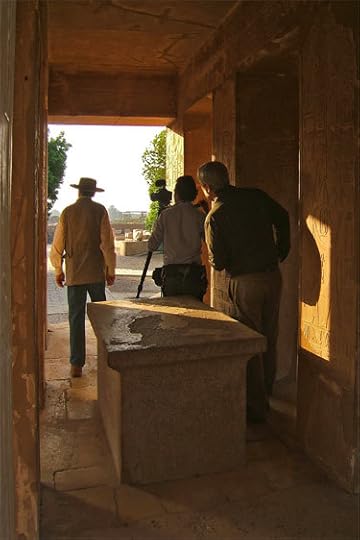 Dawn at the chapel of Senuseret I in Karnak.
Dawn at the chapel of Senuseret I in Karnak.
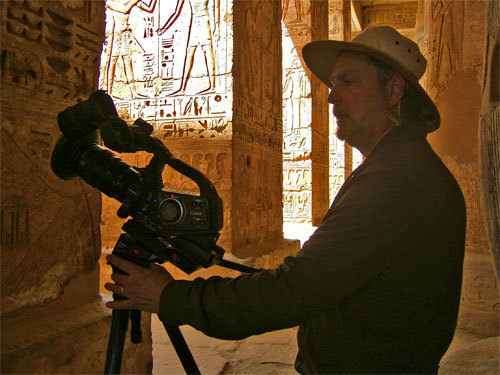 Director Tim Mahoney lining up a shot in the temple of Medinet Habu.
Director Tim Mahoney lining up a shot in the temple of Medinet Habu.
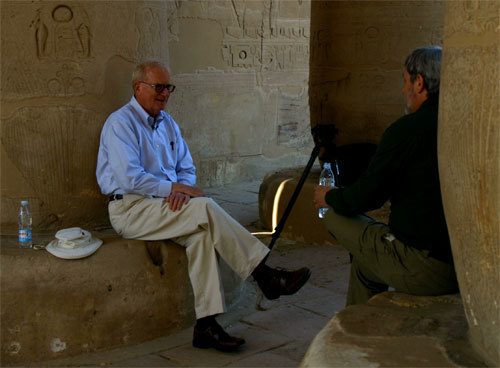 Interview with Professor Kent Weeks in the Ramesseum.
Interview with Professor Kent Weeks in the Ramesseum.
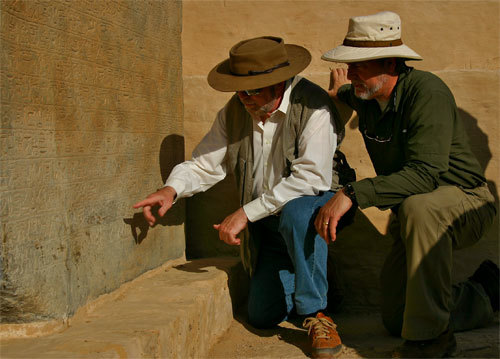 Examining the name 'Israel' on the Merenptah Stela (copy) in the king's mortuary temple on the west bank at Thebes.
Examining the name 'Israel' on the Merenptah Stela (copy) in the king's mortuary temple on the west bank at Thebes.
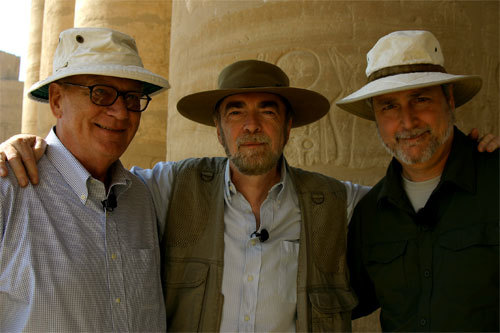 Kent Weeks, David Rohl and Tim Mahoney.
Kent Weeks, David Rohl and Tim Mahoney.
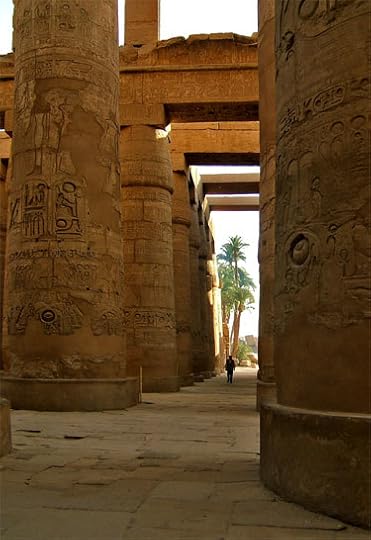 Walking the hypostyle hall at Karnak.
Walking the hypostyle hall at Karnak.
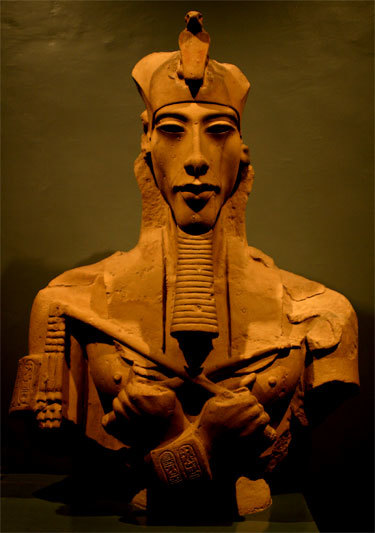 Akhenaten in the Luxor Museum.
Akhenaten in the Luxor Museum.
 Director Tim Mahoney and David Rohl in discussion.
Director Tim Mahoney and David Rohl in discussion.
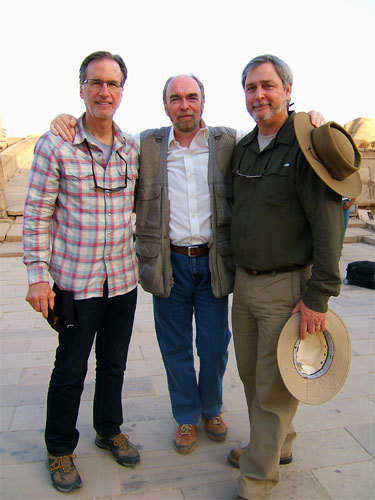 Executive Producer David Wessner, David Rohl and Director Tim Mahoney.
Executive Producer David Wessner, David Rohl and Director Tim Mahoney.
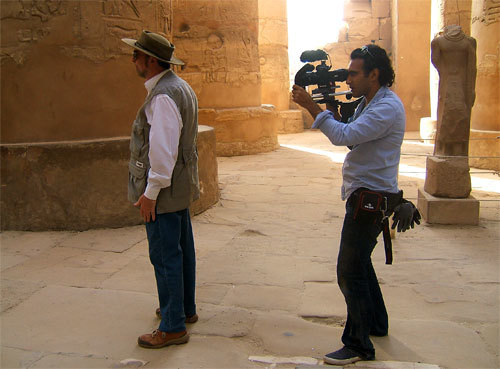 Cameraman Ramy Romany sets up a follow shot in the hypostyle hall at Karnak.
Cameraman Ramy Romany sets up a follow shot in the hypostyle hall at Karnak.
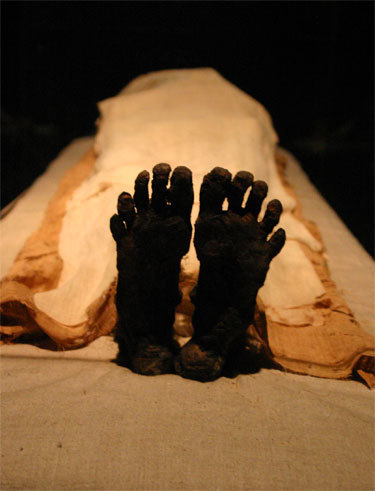 The feet of Ahmose II in Luxor Museum.
The feet of Ahmose II in Luxor Museum.
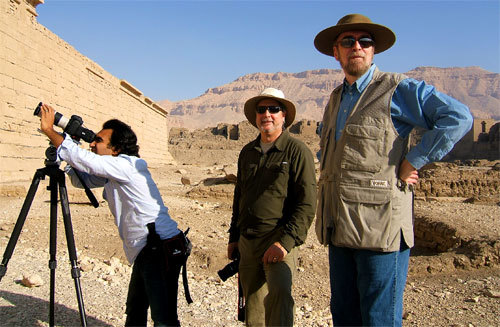 Filming the Sea Peoples reliefs at Medinet Habu.
Filming the Sea Peoples reliefs at Medinet Habu.
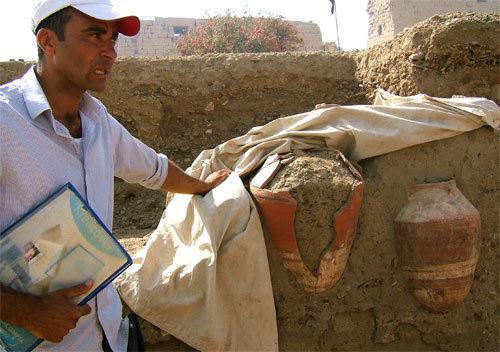 Chief Inspector Salah Elmasekh revealing Greek storage jars at his excavations in front of Karnak temple.
Chief Inspector Salah Elmasekh revealing Greek storage jars at his excavations in front of Karnak temple.
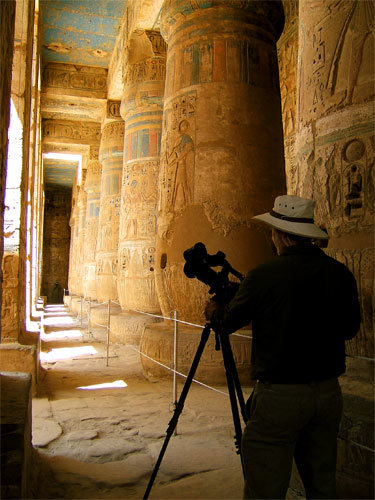 Tim Mahoney filming in Medinet Habu.
Tim Mahoney filming in Medinet Habu.
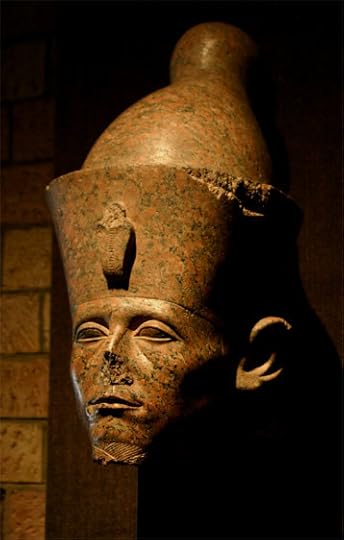 Senuseret III in the Luxor Museum.
Senuseret III in the Luxor Museum.
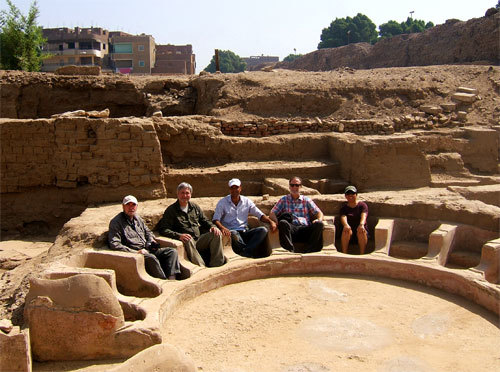 Production meeting in the recently excavated Greco-Roman baths at Karnak.
Production meeting in the recently excavated Greco-Roman baths at Karnak.
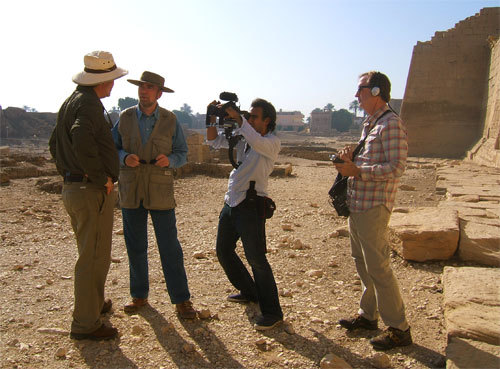 Filming at Medinet Habu beside the Sea Peoples reliefs.
Filming at Medinet Habu beside the Sea Peoples reliefs.
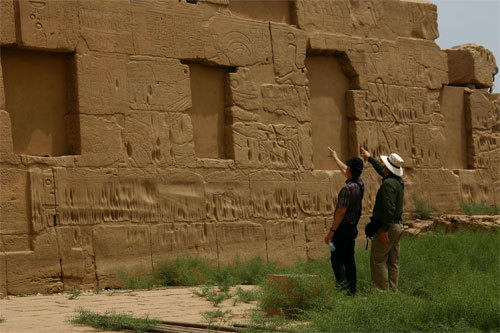 Examining the 'Israel blocks' at Karnak.
Examining the 'Israel blocks' at Karnak.
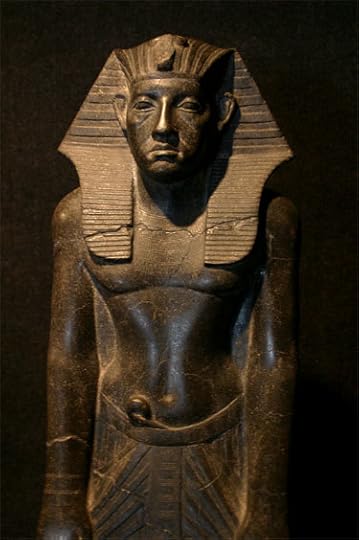 Mr Grumpy (Amenemhat III) in the Luxor Museum.
Mr Grumpy (Amenemhat III) in the Luxor Museum.
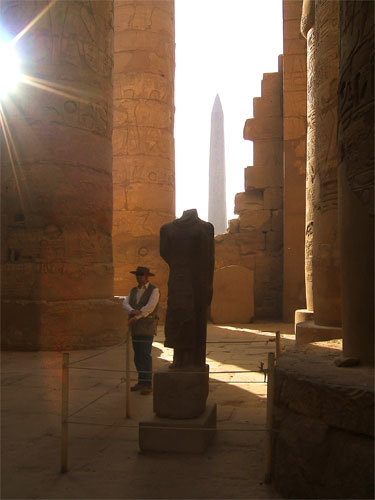 Waiting for action in the hypostyle hall at Karnak.
Waiting for action in the hypostyle hall at Karnak.
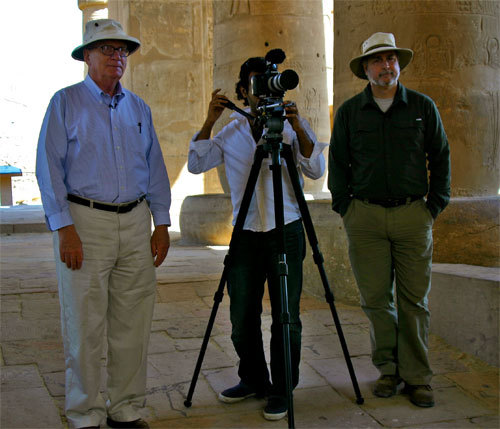 Kent Weeks, Ramy Romany and Tim Mahoney in the Ramesseum.
Kent Weeks, Ramy Romany and Tim Mahoney in the Ramesseum.
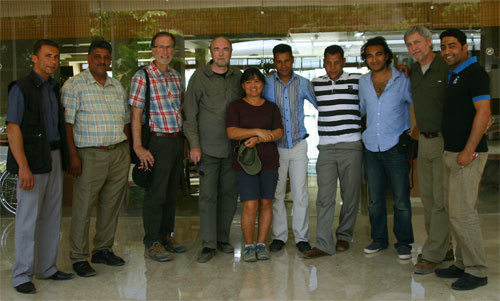 The team.
The team.
 Dawn at the chapel of Senuseret I in Karnak.
Dawn at the chapel of Senuseret I in Karnak. Director Tim Mahoney lining up a shot in the temple of Medinet Habu.
Director Tim Mahoney lining up a shot in the temple of Medinet Habu. Interview with Professor Kent Weeks in the Ramesseum.
Interview with Professor Kent Weeks in the Ramesseum. Examining the name 'Israel' on the Merenptah Stela (copy) in the king's mortuary temple on the west bank at Thebes.
Examining the name 'Israel' on the Merenptah Stela (copy) in the king's mortuary temple on the west bank at Thebes. Kent Weeks, David Rohl and Tim Mahoney.
Kent Weeks, David Rohl and Tim Mahoney. Walking the hypostyle hall at Karnak.
Walking the hypostyle hall at Karnak. Akhenaten in the Luxor Museum.
Akhenaten in the Luxor Museum. Director Tim Mahoney and David Rohl in discussion.
Director Tim Mahoney and David Rohl in discussion. Executive Producer David Wessner, David Rohl and Director Tim Mahoney.
Executive Producer David Wessner, David Rohl and Director Tim Mahoney. Cameraman Ramy Romany sets up a follow shot in the hypostyle hall at Karnak.
Cameraman Ramy Romany sets up a follow shot in the hypostyle hall at Karnak. The feet of Ahmose II in Luxor Museum.
The feet of Ahmose II in Luxor Museum. Filming the Sea Peoples reliefs at Medinet Habu.
Filming the Sea Peoples reliefs at Medinet Habu. Chief Inspector Salah Elmasekh revealing Greek storage jars at his excavations in front of Karnak temple.
Chief Inspector Salah Elmasekh revealing Greek storage jars at his excavations in front of Karnak temple. Tim Mahoney filming in Medinet Habu.
Tim Mahoney filming in Medinet Habu. Senuseret III in the Luxor Museum.
Senuseret III in the Luxor Museum. Production meeting in the recently excavated Greco-Roman baths at Karnak.
Production meeting in the recently excavated Greco-Roman baths at Karnak. Filming at Medinet Habu beside the Sea Peoples reliefs.
Filming at Medinet Habu beside the Sea Peoples reliefs. Examining the 'Israel blocks' at Karnak.
Examining the 'Israel blocks' at Karnak. Mr Grumpy (Amenemhat III) in the Luxor Museum.
Mr Grumpy (Amenemhat III) in the Luxor Museum. Waiting for action in the hypostyle hall at Karnak.
Waiting for action in the hypostyle hall at Karnak. Kent Weeks, Ramy Romany and Tim Mahoney in the Ramesseum.
Kent Weeks, Ramy Romany and Tim Mahoney in the Ramesseum. The team.
The team.
Published on May 12, 2012 03:27
April 23, 2012
The Hyksos in Tradition and History
[Note: This is an essay written in the 2nd year of my degree course in Ancient History and Egyptology at University College London (1989). As a result, it does not include the latest research. However, it does give an insight into how I was thinking back then.]
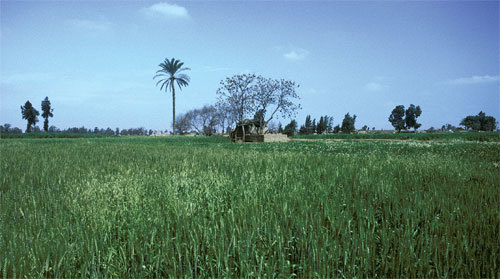 The field of Tell ed-Daba/Avaris where a palace and pyramid tomb were found.
The field of Tell ed-Daba/Avaris where a palace and pyramid tomb were found.
Until recently much of what had been written on the Second Intermediate Period (SIP) revolved around attempts to establish its chronology, both in relative and absolute terms. Little monumental or settlement archaeology had apparently survived upon which to draw conclusions about the social and cultural history of the period. Scholars were therefore dependent mainly on later written sources to reconstruct any sort of history of the SIP. Some of these sources were near contemporary, such as the Speos Artemidos inscription (mid-18th Dyn) – in which Hatshepsut proclaims her restoration of monuments neglected by the Asiatics of an earlier time; the Turin Canon (mid-19th Dyn) – listing the kings of the 13th to 17th Dynasties; and the Papyrus Sallier tale (late-19th Dyn) of Sekenenre and Apophis – a folk tale about the machinations of a 17th Dynasty Theban king and his contemporary, the 'Hyksos' ruler of Avaris. From several centuries later we also have the Genealogy of the Memphite Priesthood – a large block from a Sakkara tomb containing a list of priests of Ptah (and in some instances the rulers under which they served) extending back to Mentuhotep II and therefore including the SIP. Finally, of course, considerable use had to be made of the history of Egypt recorded by the Ptolemaic priest, Manetho, as handed down to us in the writings of Africanus, Eusebius and, for this period in particular, Josephus [Waddell 1971, pp. 73-99]. The only two primary source documents considered to be contemporary with the period under discussion are: the Kamose Stela describing the king's war against Auserre Apophis; and, the biography from the el-kab tomb of Ahmose, son of Ibana [Lichtheim 1976, II, pp. 12-15], who served in the army of Ahmose I and had participated in the siege and capture of Avaris – the event which finally resulted in the Hyksos expulsion from Egypt. Both these documents deal with the end of 'Hyksos' rule and we thus have no contemporary material which throws light on the events which led up to the rise of a foreign dynasty in Lower and Middle Egypt.
Recently, within the last fifteen years, we have at last begun to receive data from settlement sites of the period, and the initial results are suggesting that a new approach is needed to both our understanding of the nature of 'Hyksos' society and to the historical events related to their occupation of Egypt.
The remainder of this essay will review the corpus of material currently available to us in the late 1980s (including recent archaeological discoveries in the eastern delta) and will, in particular, attempt a new reconstruction of the famous Turin Canon papyrus fragments – a proposal which has important consequences for both the length of the SIP and the relative position of the principal 'Hyksos' dynasty.
The first of our tasks is to attempt to construct a picture of the society which occupied Egypt (and in particular the delta) in the years following the 12th Dynasty and prior to the Hyksos dominance. In other words, we shall be discussing the archaeological and textual evidence for Manetho's 13th and 14th Dynasties. Let us start with a new phenomenon which is apparently introduced on a large scale for the first time in Egyptian society during the 13th Dynasty.
The Evidence for Slavery in Egypt
The major document which has come to light concerning the Canaanite population of Egypt during the 13th Dynasty is the Brooklyn Papyrus 35.1446 [Hayes 1955], but there are also several papyri from the pyramid town of Senuseret II at Kahun, known collectively as the Illahun Papyri [Griffith 1898]. In the case of the former, out of a total holding in one Theban estate amounting to 79 domestic slaves, no less than 45 bore Canaanite names [Kemp 1983, p. 155]. The fact that the household was located in Upper Egypt suggest that an even higher proportion might be expected for the eastern delta where Egypt adjoins Canaan. Thus it should be quite reasonable to infer that between 50% and 75% of the slave/servant population during the 13th Dynasty was of Asiatic/Canaanite origin.
Posener has noted that all the early references to Aamu (i.e. Canaanites) living in Egypt date to the period from Amenemhat III down to the mid-13th Dynasty, around the time of Neferhotep I (Turin Canon VI, 25) [Posener 1957, pp. 145-63]. The evidence further suggests that they were more numerous in the 13th Dynasty, in spite of the poverty of archaeological data for this period, compared to the relatively rich preceding dynasty [Van Seters 1966, p. 90]. In general, they seem to have assimilated well into the existing culture of Egypt. The surviving Aamu population records of the 13th Dynasty also show a greater number of female slaves to male [Hayes 1955, p. 99].
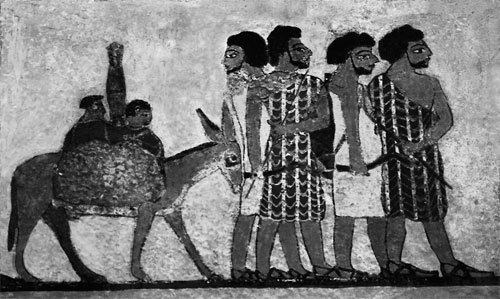 Asiatics entering Egypt from the tomb of Khnumhotep, Beni Hassan.
Asiatics entering Egypt from the tomb of Khnumhotep, Beni Hassan.
A number of texts have come to light which indicate that certain of these Aamu managed to reach high positions in the administration during the latter part of the 12th Dynasty (some also marrying Egyptian women), but that this state of affairs did not last into the late 13th Dynasty:
‘The fact that important persons in the time of Amenemhet III felt free to designate themselves as Aam or as born of an Aamt means that one can hardly consider them as slaves in the ordinary sense as in the Brooklyn Papyrus. One must therefore reckon with a deterioration in the status of Asiatics between the time of Amenemhet III and that of Neferhotep.' [Van Seters 1966, p. 91]
Van Seters also interestingly compares the Aamu of the Middle Kingdom with the Habiru, referred-to throughout the Levant from the Middle Kingdom to the el-Amarna Period [Van Seters 1966, p. 91].
Seth Worship in the Eastern Delta
An obelisk of a 'king's son' Nehesy ('the Nubian') found at Tanis [Leclant & Yoyotte 1957, pp. 50-54] has been used to establish the relative date for the beginning of the 14th Dynasty in the eastern delta. It has been almost unanimously agreed that this new dynasty arose sometime during the second half of the 13th Dynasty, whilst the kings of the latter dynasty apparently still ruled from the old 12th Dynasty royal residence of Itj-tawy south of Memphis. The argument goes something on the following lines: as artefacts for the 13th Dynasty kings succeeding Khaneferre Sebekhotep IV (Turin Canon VI, 27) have not been found in the delta, these kings must have lost control of Lower Egypt to a local dynasty which the archaeological evidence suggests was based at or near Avaris. In spite of the fact that it is an argument based on negative evidence from a region which has rarely received the archaeologists' attention until recently, this understanding of SIP history has remained the popular option. This is in no small measure due to the chronological restrictions which have been imposed upon the 13th to 17th Dynasties as a result of two key Sothic dates. By dating Year 7 of Senusret III (?) to 1830 BC (Illahun Papyrus) – and thus the end of the 12th Dynasty to 1759 BC [1]; and Year 9 of Amenhotep I to 1505 BC (Ebers Papyrus) – giving a starting date for the 18th Dynasty of 1539 BC, the SIP is restricted to just 220 years [Kitchen 1987, pp. 43-44]. Given the minimum lengths attributable to both the 13th and 14th Dynasties, as derived from the Turin Canon and Manetho, this must force an overlap between the two dynasties simply on chronological grounds.
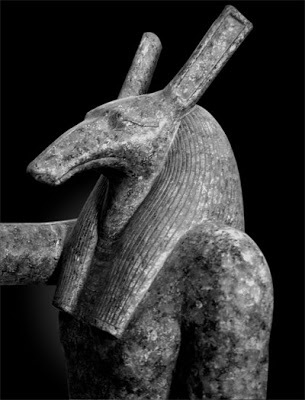 Seth Lord of Avaris.
Seth Lord of Avaris.
Returning to Nehesy, the primary candidate for founder of the 14th Dynasty, we can make certain tentative assumptions based on eastern delta archaeology. As obelisks are associated with temple facades, it would be reasonable to assume that Nehesy was involved in the construction of a temple, somewhere in the eastern delta; this is on the basis of the provenance of other Ramesside obelisks found at Tanis which have been shown to have originally come from the city of Pi-Ramesse, built at the site of the earlier city of Avaris. The obelisk is inscribed with the phrases ‘eldest royal son, Nehesy, beloved of Seth, Lord of r-3ht’ and ‘beloved of hry-s.f’ (Arsaphes). Montet has suggested that perhaps the origin of the name of the Sethroite (14th) nome is to be identified with the cult of ‘Seth Ra-akhet’ [Montet 1957, p. 199].
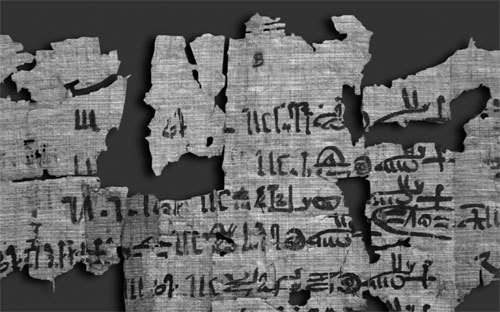 Royal Canon of Turin Column VIII with the name of King Nehesy at the top.
Royal Canon of Turin Column VIII with the name of King Nehesy at the top.
It has recently been suggested by Ahmed Osman [Sunday Times, 21st May 1989] that a newly discovered fortress town of Ramesside date, just east of the Suez Canal, may be Pi-Ramesse: the capital of the 19th and 20th Dynasties. The large 400m by 400m enclosure of Tell el-Hebua also contains an Asiatic occupation level, beneath the New Kingdom structures, which he therefore associates with Avaris. However, it is much more likely that the EAO excavator, Mohamed Abdel Maksoud, has unearthed the famous frontier town of Djaru/Sile, known to be located near Kantara, and which was undoubtedly occupied throughout most of Egypt’s history, given its strategic importance as the ‘gateway’ into the delta. That the site lies on a sand spit between salt flats and alongside the ancient pharaonic water course of the Pelusiac branch of the Nile, points clearly to el-Hebua being one of the fortress towns built to protect the principal eastern entrance into Egypt. Its large dimensions (the biggest Egyptian fort ever found) reduces the possibilities of identifying the site to either Seti I’s ‘House of the Lion’ (Karnak annals) or Djaru/Sile, both of which lay at the western end of the line of Ramesside forts.
Van Seters has persuasively argued that Ra-akhet, which means ‘gateway of the cultivation’ is to be located at Sile where cultivation and desert meet [Van Seters 1966, p. 101]. The phrase ‘beloved of Arsaphes’ gives us a further clue as to where the Nehesy obelisk may have been erected. Arsaphes was worshipped in later times at Heracleopolis Parva, capital of the 14th nome, and this too has been tentatively located at or near Sile. Thus we may postulate that Nehesy’s obelisk, and therefore the temple which it adorned, was probably erected at the Kantara fortress site where substantial remains of his time have been found. What is more, the only stelae recovered so far from el-Heboua are two bearing the name of Nehesy [2]. The implication of all this is that Nehesy, as a king’s son and heir, was charged with the protection of Egypt’s eastern frontier and that he may have resided at Sile at least for a time. Maksoud’s continuing excavations will no doubt prove to be of considerable importance and an investigation of the SIP strata at the site may well add much to our knowledge of 13th and 14th Dynasty history.
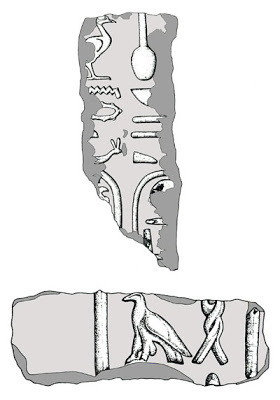 Fragments of a lintel of Nehesy found at Tell ed-Daba.
Fragments of a lintel of Nehesy found at Tell ed-Daba.
Soon after Nehesy became king, he established or enhanced the cult of ‘Seth, Lord of Avaris’ (a block of his bearing this epithet was found at Tell Moqdam – one of the two primary candidates for the Biblical Pithom). It has thus been suggested that Nehesy built a temple to Seth at Avaris which in turn is to be identified with the Canaanite temple found by Bietak at Tell ed-Daba (Stratum F/E) [Bietak 1986, p. 247]. This, however, should only be taken as a tentative suggestion. Clearly, a few monuments from the reign of Nehesy prove nothing regarding the origins of Seth-worship in the eastern delta, and, with a large part of the site as yet unexcavated, evidence might still be unearthed to show that a temple of Seth was already established and functioning at Tell ed-Daba prior to the reign of this king. It is not even absolutely certain whether the Canaanite temple was built by the Stratum F population (as seems likely) or those of the later Stratum E [Bietak 1979, p. 241-42]. Nor is it certain which of the strata represents the arrival of the main Hyksos dynasty at Avaris – any candidate from F to D/2 appears to remain a possibility [Bietak 1979, p. 237].
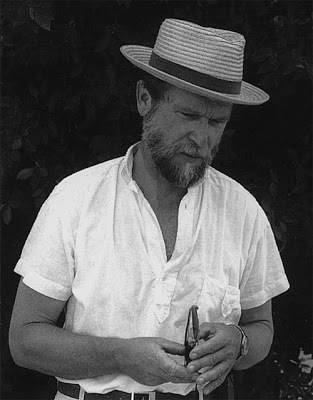 Professor Manfred Bietak.
Professor Manfred Bietak.
Moreover, Bietak himself has tentatively postulated that a palace from Area F at ed-Daba (which is located in the equivalent stratum to Stratum G on the main tell) may be a royal palace and therefore the residence of Nehesy and his dynasty [Bietak 1986, p. 294]. If this is so, then the temple must be of a later date than the palace and would clearly have to be that constructed by the Hyksos of the 15th Dynasty – perhaps the temple of Seth built by Apophis, as related in Papyrus Sallier. With this scenario, the temple which had previously been suggested as marking the establishment Seth worship by the founding kings of the 14th Dynasty must, in fact, still await discovery at Tell ed-Daba.
The Ipuwer Papyrus
‘The Admonitions of an Egyptian Sage’, as Gardiner has called the text of Papyrus Leiden 344 (recto), is a plea to an un-named king of Egypt by one Ipuwer, who relates to his lord how the land of Egypt has degenerated into chaos. The papyrus itself was found at Memphis and, according to Gardiner, is to be dated to the 19th Dynasty at the earliest; however, the palaeography and orthography suggest that the 19th Dynasty version was a copy of an earlier 18th Dynasty text, whereas the language is typical of the Middle Kingdom. Gardiner, on somewhat tenuous grounds, proposed a date at the beginning of the First Intermediate Period (FIP) for the original story. Because of the authority he holds in the discipline of the ancient Egyptian language, his view has generally held sway ever since. On the other hand, Gardiner himself conceded that a date as late as the early 18th Dynasty could not be excluded [Gardiner 1909, pp. 3 & 18].
Van Seters has since convincingly argued that the original Ipuwer text belongs securely in the late Middle Kingdom or Second Intermediate Period [Van Seters 1966, pp. 103-20]. He has shown that the orthography and language are not typical of Old Kingdom texts and that, if Gardiner's view holds, then ‘the many intimate connections with the Middle Kingdom’ would have to be ‘considered merely as anticipations’. There are so many points of language, social structure and ethnic terminology which favour the later period that our current view of Egyptian cultural and social history would have to be turned on its head if a First Intermediate Period date is to be retained.
I shall briefly summarise Van Seter’s arguments concerning the Admonitions of Ipuwer here and rely on the reader to pursue the points in more detail in the original work. His telling observations include the following:
1. The md3yw as a pro-Egyptian military force are not attested until the Middle Kingdom [Van Seters 1966, p. 106], yet they appear in line 14:14 of the Ipuwer text as a force to be relied upon by the Egyptian authorities during troubled times [Lichtheim 1973, p. 161].
2. The term sttyw to designate Asiatics who carry the bow (with an archery target as its determinative) [Admonitions 14:11 & 15:2] is common during the Middle Kingdom but does not occur in this form in the Old Kingdom and rarely in the New Kingdom [Van Seters 1966, p. 107].
3. Winlock noted that there was a shortage of coffin wood from Syria and Lebanon near the beginning of the Second Intermediate Period [Winlock 1947, p. 101]; this is reflected in the Admonitions [3:6-8]: ‘None indeed sail north to Byblos today. What shall we do for the ’s wood (pine?) for the making of coffins?’
4. The term Keftiu (kftiw) for Crete, found in line 3:9, does not occur in the Old Kingdom and is even quite rare in the 12th Dynasty [Van Seters 1966, pp. 108-9].
5. ‘The institution of slavery, apart from a type of serfdom associated primarily with royal land estates, is not attested for the Old Kingdom. Slavery is, at the earliest, a product of the Middle Kingdom; in this period there is clear evidence for privately owned household slaves, male and female, who were considered as transferable, moveable property.’ The term hm/hmt is used seven times in the Admonitions in the context of household slaves, exactly as it is used in the slave list of the Brooklyn Papyrus which is dated to the 13th Dynasty.
In summation of his findings Van Seters makes the following statement:
‘One date seems to fit all the requirements: late Thirteenth Dynasty. The orthography and the linguistic evidence have always pointed toward this later date, and our present knowledge of the social and political history of this period confirms this opinion.’ [Van Seters 1966, p. 115]
Thus the Admonitions of Ipuwer should more justifiably be utilised in the elaboration of SIP history than the FIP. Even if one were to argue that this type of literature is of the didactic variety (like the predominantly Middle Kingdom sb3yt ‘instruction’ texts which often deal with chaos versus order), there is no reason why it should not reflect, to some degree, the conditions which Egypt found itself in at the time of the writing of the original text. In other words, Egypt was suffering from severe distress sometime during the mid-13th Dynasty/early SIP, at least partly due to the machinations of the large Asiatic population in the delta which looms large in the Admonitions.
It is therefore also my own view that Gardiner was quite wrong in his dating of this important text, and to continue to regard Ipuwer as reflecting the troubles at the end of the Old Kingdom, as most authoritative reference works still do, is to perpetuate a serious misconception concerning the nature of the era known as the First Intermediate Period and deprive the 13th Dynasty of an important document relating to the troubled conditions that generally pertained at the time. One may legitimately argue that the Admonitions has no real historical value, but this would be to ignore the obvious point that pessimistic writings tend to be born out of periods of political instability and can justifiably be used to some degree to create a picture of the era which created them. In the case of Ipuwer it is the continuous references to 'Asiatics’, who seem to be at the focus of the troubles, which can add to information from other sources pointing to a general decline during the second half of the 13th Dynasty. It has been suggested that one major element in this scenario of decline was ‘Asiatic’ expansion in the delta and this appears to be precisely the sort of political picture described in the Ipuwer Papyrus.
Hyksos Invasion or Asiatic Infiltration and Internal Coup?
Save-Soderbergh [Save-Soderbergh 1951, p. 55] and others [e.g. Alt 1959] have argued that there was no sudden invasion of Egypt by Asiatic chiefs who subsequently became the Hyksos 15th Dynasty of Manetho. They point to the ‘Asiatic’ names of rulers of Egypt found in the Turin Canon at lines IX:29 & 30 (An[a]ti = Anath (?) & Bebnem = Bnon (?)), who occur 16 places before the Hyksos kings of the 15th Dynasty (currently residing in column X), according to the accepted reconstruction of the papyrus. Thus they argue that Asiatic kings were already ruling in the eastern delta long before the main group of 6 Hyksos kings. This then contradicts Josephus’ supposed verbatim account of Manetho which tells of a sudden invasion of oppressive Asiatics ‘from Phoenicia’ [Waddell, pp. 77-91].
On the other hand, Helck has strongly supported the invasion story of Josephus and the Manethonian excerptors [Helck 1962]. He argued (before Bietak’s discoveries at Tell ed-Daba) that, by its very nature, an invasion of a civilised and established culture by nomadic groups will not necessarily appear in the stratigraphical record. He sites the Kassite conquerors of Babylonia, who were completely assimilated into the existing culture of the region and only identifiable as a new group through the evidence of later written records. He also cites the Speos Artemidos inscription of Hatshepsut as literary support of the character of Hyksos rule, less than a century after their expulsion:
‘Listen all people, as many as you may be! I have done this according to the wishes of my heart ... I have restored that which was in ruins, I have raised up that which was unfinished since the Asiatics were in the midst of Avaris of the Northland, and the barbarians were in the midst of them, overthrowing that which had been made, while they ruled without Ra’.
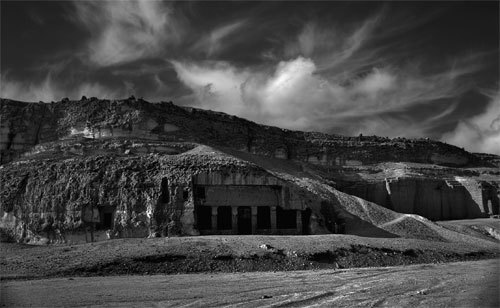 Hatshepsut's Speos Artemidos temple.
Hatshepsut's Speos Artemidos temple.
This, Helck argues, is clear evidence for the veracity of the Manethonean tradition, whereas there are no native Egyptian or Syro-Palestinian sources which can be seen to contradict the Egyptian priest’s version of events – only the apparent occurrence of kings bearing Asiatic names prior to the main Hyksos dynasty.
Alt’s typically sceptical approach to Manetho views the Hyksos invasion tradition as a symptom of the later military invasions of Assyria and Persia [Alt 1959, pp. 72-98]. Thus, having rightly observed that Josephus’s ‘verbatim’ account is riddled with later additions, including the mention of Assyrians, who do not appear on the Egyptian scene until much later in 7th century Egypt, he contends that the story of a sudden invasion is a reflection of the Esarhaddon and Ashurbanipal invasions of 671 and 667 BC. But can this approach really be employed to deny the substance of Manetho’s history, simply because there were other invasions between the Hyksos period and the Ptolemaic historian’s own era? The fact that peoples and places mentioned in the traditions are to be identified with political and geographical conditions nearer to Manetho’s lifetime simply shows that the writer thought of his country’s past in terms of the political topography of its recent history; but this in itself cannot deny the basic truth of the original event. The Romans did not build a garrison town at York but at ‘Eboracum’, and Julius Caesar did not cross the ‘English Channel’. Do these simple statements mean that we must reject all popular accounts of historical events simply because modern historians employ 20th-century names to describe ancient events and places? Surely in this case Alt’s reasoning is not based on a sound methodology.
Alt’s somewhat jaundiced view of ancient historical tradition also accounts for the loss to history of the Conquest narratives of the Old Testament. This sort of scholarship is partly responsible for the trend towards the so-called ‘healthy skepticism’ approach to the study of ancient history, which, in my view, has tended towards rampant gradualism. Virtually all the great traditions of invasions and population movements in the ancient world are now apparently seen as rather insipid infiltrations thanks to the Alt and Noth school of thought.
As the non-invasion view of the Hyksos period is now given prominence in the standard works on Egyptian history, the reconstruction of the surviving Turin Canon fragments proposed below, which undermines one of the principal arguments at the heart of this view, is important for the re-establishment of a counterweight to this now somewhat unbalanced debate.
The Turin Canon: A New Reconstruction
During one afternoon spent undertaking research in the Edwards Library at University College London, I chanced to come across the original publication of The Royal Canon of Turin by Alan Gardiner [Gardiner 1959]. I decided to thumb through the pages of this large format volume, just to give my brain a rest from the long and somewhat dry tome that I had been studying. Almost at once I noticed something on Plate III which struck me as very odd, for in the middle of column IX of the reconstructed papyrus, Ibscher (who undertook the second restoration) had placed one of the ancient repair patches which were otherwise consistently to be found at the top of the Canon’s columns.
 Column IX (left) with the darker patch towards the bottom of the column.
Column IX (left) with the darker patch towards the bottom of the column.
The most reasonable explanation for these patches would be that, after the 19th Dynasty tax list on the recto was put into store, the top of the role had been eaten through by an insect, leaving a hole right through the document, a couple of centimetres from the top edge. When the papyrus was reused to record a copy of the kings list (on the blank verso) it was necessary to stick small patches of papyrus over the holes which had been discovered upon unrolling the papyrus. The patches thus appear at intervals of 17cms along the upper section of its length – that is except for the patch which now stands in the middle of column IX and one which remains in the collection of unplaced fragments.
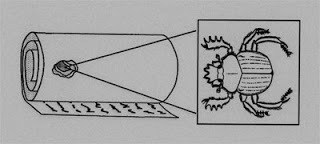 Greedy beetle!
Greedy beetle!
What appeared quite obvious to me was the simple fact that in three places where one might have expected to find repair patches there were none: in the gaps at the top of columns I and IV and the left side of column IX.
 Simplified layout of the Royal Canon showing positions of patches (darker).
Simplified layout of the Royal Canon showing positions of patches (darker).
Why then hadn’t someone suggested that the patch in the middle of column IX, and that assigned to the fragments, belonged in the gaps at the top of these columns? Surely a closer scrutiny would reveal why those who had assembled the fragments had not taken this logical step? Subsequent investigation has, however, convinced me that a serious error was made in the mounting of the Turin Canon by Ibscher [published in Farina, 1938] and later retained by Gardiner. This in turn has led to a number of false assumptions about the length of the SIP and the position of the Hyksos 15th Dynasty within that period.
Looking in detail at the two patches of concern: the one mounted in column IX bears names which Gardiner describes as ‘wholly fictitious beings’ and ‘fantastically named royalties’ [Gardiner 1959, p. 17]. They include animals and animal deities like ‘ibis/Thoth?’ (IX,17), ‘goose/Geb?’ (IX,18) and ‘Apis’ (IX,19) and the term ‘shemsu’ – a designation for the semi-divine beings of Predynastic Egypt. If any location on the papyrus were to suit these strange entries it must surely be in the space at the top of column I where, at the bottom half of the column, we find the gods and demi-gods of the prehistoric era. This would leave the patch from the unplaced fragments (containing only numerals of reign durations) to occupy either the top of column IV or the left half of the top of column IX.
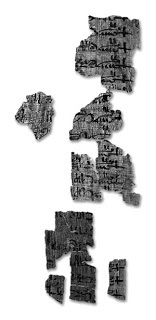
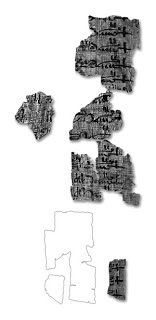
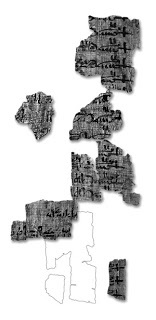 Three stages of reconstruction.
Three stages of reconstruction.
By removing the patch from column IX we now find ourselves with a large gap in the middle of that column and an equally large question begging to be answered – why, in the first place, was the Canon reconstructed into eleven columns when all the pieces could be mounted in ten columns? The small fragments in column X could easily fit in the new space now available in column IX and, what is more, fragments 150 and 152 certainly do not belong at the top of column X where they currently reside, as neither is a patch (on the arguments already aired above, a patch would have to stand here). The recto tax list, on the back of the fragments placed in columns IX to XI, is ‘wholly chaotic’ (in Gardiner's words), so is useless in determining any of the positions for the fragments of the last third of the document.
Unfortunately, it seems that historians in recent years have taken the order and position of these fragments as established with some degree of certainty, and have failed to take into consideration Gardiner’s salutary remarks found in the notes of his publication of the Turin Canon:
‘Down to IX,10 of the King-list the positions of the fragments as seen in F[arina] may be regarded as on the whole certain or at least plausible, but the arrangement of the remainder of col. IX and the whole of col. X must be regarded with the utmost skepticism. The scanty traces on the recto are wholly chaotic. In our Plates the positions given by Farina or Ibscher are retained, but only in order to avoid relegating to the Unplaced a number of pieces that undoubtedly belong to this papyrus. ... With the scanty material before us we see no solution to these problems.’ [Gardiner 1959, p. 17]
It is thus difficult to understand why the two great modern works on the chronology of the Turin Canon, those of von Beckerath [1964] and Malek [1982], have made use of the existing mounting of columns IX and X to develop their arguments.
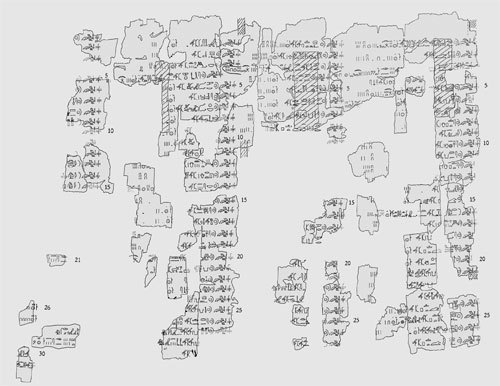 Columns VI to IX of the Royal Canon of Turin.
Columns VI to IX of the Royal Canon of Turin.
It is my contention that Ibscher’s column X is superfluous, resulting in an artificial stretching of the Canon (and therefore the chronology) by one column of 25 to 30 kings. Column XI, containing some of the 17th Dynasty rulers, should therefore be renamed as column X and brought into contact with a newly reconstructed column IX. It is the latter to which we should now turn in order to relocate the fragment bearing the total for the Hyksos dynasty which previously resided in the now defunct column X.
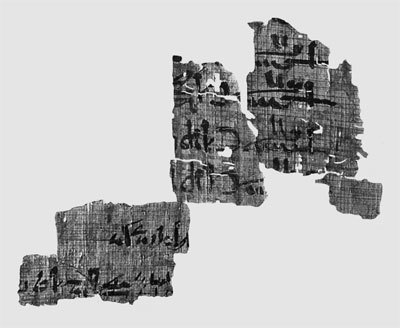 The Hyksos fragments reunited.
The Hyksos fragments reunited.
The reconstruction of column IX is best explained by reference to the illustration above. The top two fragments (105 & 108) have been retained in their original position. Similarly, fragment 112 has been left where Ibscher mounted it although it must be said that there is no evidence for doing so (but see below). The patch fragments 41, 41a and 42 have been relocated to column I, and in their place is positioned the un-numbered fragment bearing the name of the last Hyksos ruler, Khamudy, followed by the total line: ‘6 rulers of foreign lands for 100[+x years]’ (this fragment will be designated the number 112a in order to simplify references to it in the following discussion). Beneath this is placed the small fragment 22 from the old column X, simply to fill the gap above fragments 123 and 122 which have been retained in their original positions. Now let us look at the results of this arrangement to see what information can be gleaned.
The place to start is with the central fragments 112 and 112a which form the focus of this new reconstruction. What we now have is the following:
[...] – Line IX,14
Dual King [...] – Line IX,15
Dual King Anak[...] – Line IX,16
Dual King Ia[...] – Line IX,17
Dual King Ap[...] – Line IX,18
[...] Khamudy – Line IX,19
6 [heqau]-khasut for 100[+x years] – Line IX,20
I would therefore like to tentatively propose that this constitutes the 6 kings of the 15th Dynasty and that Manetho's list of Hyksos kings may be arranged as follows:
Salites/Saites = Shalek
Bnon/Baion = Bebnem
Apachnan = Anak-idbu ('Lord of the Isles') Khyan [3]
Iannas/Staan = Ianassi (son of Khyan)
Apophis = Auserre Apophis
Assis/Archles = Khamudy
One of the principal arguments against the theory of a sudden Asiatic invasion of Egypt was that the Turin Canon had kings with Asiatic names residing at the bottom of column IX, a number of generations before the Hyksos 15th Dynasty (represented by 112a) standing in the middle of the old column X. Now that we have relocated the 15th Dynasty before these other Asiatic rulers, they simply become part of Manetho's ‘17th Dynasty’ group of ‘shepherd kings’ and no longer predate the arrival of the Hyksos.
Moreover, the number of kings which follow the first Hyksos ruler (IX,14) accord perfectly with von Beckerath’s excellent suggestion that Manetho’s 17th Dynasty (Africanus version) represents the 6 main Hyksos kings, plus 5 Theban rulers, plus 32 minor Asiatic rulers – a total of 43 kings ruling for a period of 151 years [von Beckerath 1964, p. ..]. According to this argument, the 17th Dynasty is therefore a construct which arose from Manetho’s misunderstanding of a summary line in the original kings list giving in reality the total reigns and years since the foreign occupation of Egypt had begun. The reconstruction offered here has exactly 43 kings from the first Hyksos (IX,14) to the end of the new column X – the beginning of the 18th Dynasty (according to the column line totals calculated by Malek, p. 94).
The new arrangement of the Turin Canon is also compatible with the Genealogy of the Memphite Priesthood (see diagram) where we have 7 generations between one ‘Aken’ (perhaps Akenenre Apophis, an early Hyksos ruler not to be identified with Auserre Apophis – a theory for which there is absolutely no proof and little precedent) and Ahmose I (at 22 years a generation a total of around 154 years and therefore close to the figure arrived at for the 17th Dynasty). Before Aken the Genealogy gives the name Iby, and this ruler is attested in the Canon (VII,14) immediately after a broken entry which reads ‘[...]mes’, almost certainly the Djedneferre Dudimose of the Gebelain Stela and several other monuments from this period [Gauthier 1907, pp. 50-51]. Thus again Manetho may be quite correct when he states (Josephus version) that:
‘Tutimaeos. In his reign, for what cause I know not, a blast of God smote us; and unexpectedly, from the regions of the East, invaders of obscure race marched in confidence of victory against our land.’ [Waddell, p. 79]
It is very likely that this Tutimaeos is our Dudimose of the 13th Dynasty and, given the overlap already established for the late 13th and early 14th Dynasties it is not inconceivable that the Hyksos invasion may have taken place during the reign of the 38th king of the 13th Dynasty and some 9 or 10 rulers into the parallel 14th.
With this scenario, the new reconstruction of the Turin Canon is consistent and compatible with both the Memphite Genealogy and Manetho. The latter’s history of this period once again appears to have been vindicated by new research, just as both Malek and von Beckerath had independently argued that the data derived from the Ptolemaic priest’s dynastic list had a genuine historical basis which simply required the correct interpretation. By adopting this new proposal, a number of the riddles which have tended to confuse the chronology of the SIP have been solved and an opportunity exists to establish a clearer chronological framework for the history of this fascinating period of Egypt’s past.
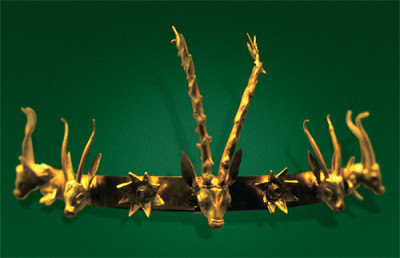 The golden diadem of a Hyksos princess from Tell ed-Daba.
The golden diadem of a Hyksos princess from Tell ed-Daba.
Notes
1. The dates used here are the low chronology of Krauss [1985]. For the higher chronology of Parker the reader should date the end of the 12th Dynasty to 1801 and the start of the 18th to 1550, giving an interval of 251 years in which to place the dynasties of the SIP. Krauss’ dates are based on observations of the heliacal rising of Sirius at Elephantine whereas Parker locates the observations at Memphis or Itj-tawy.
2. Disclosed by the excavator at the recent seminar held in the Egyptian Cultural Centre in London – May 1989.
3. Personal communication from Dr Bietak – letter of 29/9/86 in which he informed me that his team had found a stela of ‘the eldest son of king Ianasi, son of king Khyan’. Manfred Gorg proposed that Ianasi should be identified with Iannas and that Khyan must therefore be identified with the predecessor of Iannas in the redactions of Manetho.
Bibliography
A. Alt 1959: ‘Die Herkunft der Hyksos in neuer Sicht’ in Kleine Schriften zur Geschichte des Volkes Israel Vol. 3 (Munich), pp. 72-98.
J. von Beckerath 1964: Untersuchungen zur politischen Geschichte der Zweiten Zwischenzeit in Agypten (Glöckstadt).
J. von Beckerath 1984: Handbuch der Agyptischen Konigsnamen (Munich).
M. Bietak 1979: Avaris and Piramesse (Oxford)
M. Bietak 1984: ‘Problems of Middle Bronze Age Chronology: New Evidence from Egypt’ in AJA 88, pp. 471-85.
W. G. Dever 1985: ‘Relations Between Syria-Palestine and Egypt in the "Hyksos" Period’ in J. N. Tubb (ed.): Palestine in the Bronze and Iron Ages: Papers in Honour of Olga Tufnell (London), pp. 69-87.
G. Farina 1938: Il Papiro dei Re Restaurato (Rome).
A. H. Gardiner 1909: Admonitions of an Egyptian Sage, (Leipzig), pp. 3 & 18.
A. H. Gardiner 1959: The Royal Canon of Turin (Oxford).
A. H. Gardiner 1961: Egypt of the Pharaohs (London).
F. L. Griffith 1898: Hieratic Papyri from Kahun and Gurob 2 vols (London).
W. C. Hayes 1955: A Papyrus of the Late Middle Kingdom in the Brooklyn Museum (Brooklyn).
W. C. Hayes 1973: ‘Egypt: From the Death of Ammenemes III to Seqenenre II’ in CAH II:1, pp. 42-76.
H. W. Helck 1962: Die Beziehungen Agyptens zu Vorderasien im 3. und 2. Jahrtausend V. Chr. (Wiesbaden).
M. Ibrahim & D. Rohl 1988: ‘Apis and the Serapeum’ in JACF 2, pp. 6-26.
P. P. James et.al. 1987: ‘Bronze to Iron Age Chronology in the Old World: Time for a Re-assessment?’ in JACF 1, pp. 6-80.
B. J. Kemp 1983: ‘The Second Intermediate Period in Egypt’ in B. G. Trigger et. al.: Ancient Egypt: A Social History (Cambridge).
K. M. Kenyon 1983: ‘Palestine in the Middle Bronze Age’ in CAH II:1, pp. 77-116.
K. A. Kitchen 1987: ‘The Basics of Egyptian Chronology in Relation to the Bronze Age’ in High Middle or Low: Acts of an International Colloquium on Absolute Chronology Held at the University of Gothenburg 20th-22nd August 1987 Part 1, pp. 37-56.
R. Krauss 1985: Sothis- und Monddaten, Studien zur astronomischen und technischen Chronologie Altagyptens (Hildesheim).
P. H. Labib 1937: Die Herrschaft der Hyksos in Agypten und ihr Sturz (Glockstadt).
J. Leclant & J. Yoyotte 1957: ‘Les Obelisques de Tanis’ in Kemi 14, pp. 50-54.
M. Lichtheim 1973: Ancient Egyptian Literature Vol. I (London), p. 161.
J. Malek 1982: ‘The Original Version of the Royal Canon of Turin’ in JEA 68, pp. 93-106.
P. Montet 1957: Geographie de l'Egypte ancienne 2 vols (Paris), p. 199.
G. Posener 1957: ‘Les Asiatiques en Egypte sous les XIIe et XIIIe dynasties’ in Syria 34, pp. 145-63.
D. B. Redford 1970: ‘The Hyksos Invasion in History and Tradition’ in Orientalia 39, pp. 1-51.
D. Rohl & P. James 1983: ‘An Alternative to the Velikovskian Chronology of Ancient Egypt: A Preview of Some Recent Work in the Field of Ancient History’ in SIS Workshop 5:2, pp. 12-22.
D. Rohl & B. Newgrosh 1988: ‘The el-Amarna Letters and the New Chronology’ in C & C Review X, pp. 23-42.
T. Save-Soderbergh 1951: ‘The Hyksos Rule in Egypt’ in JEA 37.
J. Van Seters 1966: The Hyksos (London).
W. G. Waddell 1971: Manetho (London).
W. Whiston (trans.) 1981: Josephus (Grand Rapids).
H. E. Winlock 1947: The Rise and Fall of the Middle Kingdom in Thebes (New York).
 The field of Tell ed-Daba/Avaris where a palace and pyramid tomb were found.
The field of Tell ed-Daba/Avaris where a palace and pyramid tomb were found.Until recently much of what had been written on the Second Intermediate Period (SIP) revolved around attempts to establish its chronology, both in relative and absolute terms. Little monumental or settlement archaeology had apparently survived upon which to draw conclusions about the social and cultural history of the period. Scholars were therefore dependent mainly on later written sources to reconstruct any sort of history of the SIP. Some of these sources were near contemporary, such as the Speos Artemidos inscription (mid-18th Dyn) – in which Hatshepsut proclaims her restoration of monuments neglected by the Asiatics of an earlier time; the Turin Canon (mid-19th Dyn) – listing the kings of the 13th to 17th Dynasties; and the Papyrus Sallier tale (late-19th Dyn) of Sekenenre and Apophis – a folk tale about the machinations of a 17th Dynasty Theban king and his contemporary, the 'Hyksos' ruler of Avaris. From several centuries later we also have the Genealogy of the Memphite Priesthood – a large block from a Sakkara tomb containing a list of priests of Ptah (and in some instances the rulers under which they served) extending back to Mentuhotep II and therefore including the SIP. Finally, of course, considerable use had to be made of the history of Egypt recorded by the Ptolemaic priest, Manetho, as handed down to us in the writings of Africanus, Eusebius and, for this period in particular, Josephus [Waddell 1971, pp. 73-99]. The only two primary source documents considered to be contemporary with the period under discussion are: the Kamose Stela describing the king's war against Auserre Apophis; and, the biography from the el-kab tomb of Ahmose, son of Ibana [Lichtheim 1976, II, pp. 12-15], who served in the army of Ahmose I and had participated in the siege and capture of Avaris – the event which finally resulted in the Hyksos expulsion from Egypt. Both these documents deal with the end of 'Hyksos' rule and we thus have no contemporary material which throws light on the events which led up to the rise of a foreign dynasty in Lower and Middle Egypt.
Recently, within the last fifteen years, we have at last begun to receive data from settlement sites of the period, and the initial results are suggesting that a new approach is needed to both our understanding of the nature of 'Hyksos' society and to the historical events related to their occupation of Egypt.
The remainder of this essay will review the corpus of material currently available to us in the late 1980s (including recent archaeological discoveries in the eastern delta) and will, in particular, attempt a new reconstruction of the famous Turin Canon papyrus fragments – a proposal which has important consequences for both the length of the SIP and the relative position of the principal 'Hyksos' dynasty.
The first of our tasks is to attempt to construct a picture of the society which occupied Egypt (and in particular the delta) in the years following the 12th Dynasty and prior to the Hyksos dominance. In other words, we shall be discussing the archaeological and textual evidence for Manetho's 13th and 14th Dynasties. Let us start with a new phenomenon which is apparently introduced on a large scale for the first time in Egyptian society during the 13th Dynasty.
The Evidence for Slavery in Egypt
The major document which has come to light concerning the Canaanite population of Egypt during the 13th Dynasty is the Brooklyn Papyrus 35.1446 [Hayes 1955], but there are also several papyri from the pyramid town of Senuseret II at Kahun, known collectively as the Illahun Papyri [Griffith 1898]. In the case of the former, out of a total holding in one Theban estate amounting to 79 domestic slaves, no less than 45 bore Canaanite names [Kemp 1983, p. 155]. The fact that the household was located in Upper Egypt suggest that an even higher proportion might be expected for the eastern delta where Egypt adjoins Canaan. Thus it should be quite reasonable to infer that between 50% and 75% of the slave/servant population during the 13th Dynasty was of Asiatic/Canaanite origin.
Posener has noted that all the early references to Aamu (i.e. Canaanites) living in Egypt date to the period from Amenemhat III down to the mid-13th Dynasty, around the time of Neferhotep I (Turin Canon VI, 25) [Posener 1957, pp. 145-63]. The evidence further suggests that they were more numerous in the 13th Dynasty, in spite of the poverty of archaeological data for this period, compared to the relatively rich preceding dynasty [Van Seters 1966, p. 90]. In general, they seem to have assimilated well into the existing culture of Egypt. The surviving Aamu population records of the 13th Dynasty also show a greater number of female slaves to male [Hayes 1955, p. 99].
 Asiatics entering Egypt from the tomb of Khnumhotep, Beni Hassan.
Asiatics entering Egypt from the tomb of Khnumhotep, Beni Hassan.A number of texts have come to light which indicate that certain of these Aamu managed to reach high positions in the administration during the latter part of the 12th Dynasty (some also marrying Egyptian women), but that this state of affairs did not last into the late 13th Dynasty:
‘The fact that important persons in the time of Amenemhet III felt free to designate themselves as Aam or as born of an Aamt means that one can hardly consider them as slaves in the ordinary sense as in the Brooklyn Papyrus. One must therefore reckon with a deterioration in the status of Asiatics between the time of Amenemhet III and that of Neferhotep.' [Van Seters 1966, p. 91]
Van Seters also interestingly compares the Aamu of the Middle Kingdom with the Habiru, referred-to throughout the Levant from the Middle Kingdom to the el-Amarna Period [Van Seters 1966, p. 91].
Seth Worship in the Eastern Delta
An obelisk of a 'king's son' Nehesy ('the Nubian') found at Tanis [Leclant & Yoyotte 1957, pp. 50-54] has been used to establish the relative date for the beginning of the 14th Dynasty in the eastern delta. It has been almost unanimously agreed that this new dynasty arose sometime during the second half of the 13th Dynasty, whilst the kings of the latter dynasty apparently still ruled from the old 12th Dynasty royal residence of Itj-tawy south of Memphis. The argument goes something on the following lines: as artefacts for the 13th Dynasty kings succeeding Khaneferre Sebekhotep IV (Turin Canon VI, 27) have not been found in the delta, these kings must have lost control of Lower Egypt to a local dynasty which the archaeological evidence suggests was based at or near Avaris. In spite of the fact that it is an argument based on negative evidence from a region which has rarely received the archaeologists' attention until recently, this understanding of SIP history has remained the popular option. This is in no small measure due to the chronological restrictions which have been imposed upon the 13th to 17th Dynasties as a result of two key Sothic dates. By dating Year 7 of Senusret III (?) to 1830 BC (Illahun Papyrus) – and thus the end of the 12th Dynasty to 1759 BC [1]; and Year 9 of Amenhotep I to 1505 BC (Ebers Papyrus) – giving a starting date for the 18th Dynasty of 1539 BC, the SIP is restricted to just 220 years [Kitchen 1987, pp. 43-44]. Given the minimum lengths attributable to both the 13th and 14th Dynasties, as derived from the Turin Canon and Manetho, this must force an overlap between the two dynasties simply on chronological grounds.
 Seth Lord of Avaris.
Seth Lord of Avaris.Returning to Nehesy, the primary candidate for founder of the 14th Dynasty, we can make certain tentative assumptions based on eastern delta archaeology. As obelisks are associated with temple facades, it would be reasonable to assume that Nehesy was involved in the construction of a temple, somewhere in the eastern delta; this is on the basis of the provenance of other Ramesside obelisks found at Tanis which have been shown to have originally come from the city of Pi-Ramesse, built at the site of the earlier city of Avaris. The obelisk is inscribed with the phrases ‘eldest royal son, Nehesy, beloved of Seth, Lord of r-3ht’ and ‘beloved of hry-s.f’ (Arsaphes). Montet has suggested that perhaps the origin of the name of the Sethroite (14th) nome is to be identified with the cult of ‘Seth Ra-akhet’ [Montet 1957, p. 199].
 Royal Canon of Turin Column VIII with the name of King Nehesy at the top.
Royal Canon of Turin Column VIII with the name of King Nehesy at the top.It has recently been suggested by Ahmed Osman [Sunday Times, 21st May 1989] that a newly discovered fortress town of Ramesside date, just east of the Suez Canal, may be Pi-Ramesse: the capital of the 19th and 20th Dynasties. The large 400m by 400m enclosure of Tell el-Hebua also contains an Asiatic occupation level, beneath the New Kingdom structures, which he therefore associates with Avaris. However, it is much more likely that the EAO excavator, Mohamed Abdel Maksoud, has unearthed the famous frontier town of Djaru/Sile, known to be located near Kantara, and which was undoubtedly occupied throughout most of Egypt’s history, given its strategic importance as the ‘gateway’ into the delta. That the site lies on a sand spit between salt flats and alongside the ancient pharaonic water course of the Pelusiac branch of the Nile, points clearly to el-Hebua being one of the fortress towns built to protect the principal eastern entrance into Egypt. Its large dimensions (the biggest Egyptian fort ever found) reduces the possibilities of identifying the site to either Seti I’s ‘House of the Lion’ (Karnak annals) or Djaru/Sile, both of which lay at the western end of the line of Ramesside forts.
Van Seters has persuasively argued that Ra-akhet, which means ‘gateway of the cultivation’ is to be located at Sile where cultivation and desert meet [Van Seters 1966, p. 101]. The phrase ‘beloved of Arsaphes’ gives us a further clue as to where the Nehesy obelisk may have been erected. Arsaphes was worshipped in later times at Heracleopolis Parva, capital of the 14th nome, and this too has been tentatively located at or near Sile. Thus we may postulate that Nehesy’s obelisk, and therefore the temple which it adorned, was probably erected at the Kantara fortress site where substantial remains of his time have been found. What is more, the only stelae recovered so far from el-Heboua are two bearing the name of Nehesy [2]. The implication of all this is that Nehesy, as a king’s son and heir, was charged with the protection of Egypt’s eastern frontier and that he may have resided at Sile at least for a time. Maksoud’s continuing excavations will no doubt prove to be of considerable importance and an investigation of the SIP strata at the site may well add much to our knowledge of 13th and 14th Dynasty history.
 Fragments of a lintel of Nehesy found at Tell ed-Daba.
Fragments of a lintel of Nehesy found at Tell ed-Daba.Soon after Nehesy became king, he established or enhanced the cult of ‘Seth, Lord of Avaris’ (a block of his bearing this epithet was found at Tell Moqdam – one of the two primary candidates for the Biblical Pithom). It has thus been suggested that Nehesy built a temple to Seth at Avaris which in turn is to be identified with the Canaanite temple found by Bietak at Tell ed-Daba (Stratum F/E) [Bietak 1986, p. 247]. This, however, should only be taken as a tentative suggestion. Clearly, a few monuments from the reign of Nehesy prove nothing regarding the origins of Seth-worship in the eastern delta, and, with a large part of the site as yet unexcavated, evidence might still be unearthed to show that a temple of Seth was already established and functioning at Tell ed-Daba prior to the reign of this king. It is not even absolutely certain whether the Canaanite temple was built by the Stratum F population (as seems likely) or those of the later Stratum E [Bietak 1979, p. 241-42]. Nor is it certain which of the strata represents the arrival of the main Hyksos dynasty at Avaris – any candidate from F to D/2 appears to remain a possibility [Bietak 1979, p. 237].
 Professor Manfred Bietak.
Professor Manfred Bietak.Moreover, Bietak himself has tentatively postulated that a palace from Area F at ed-Daba (which is located in the equivalent stratum to Stratum G on the main tell) may be a royal palace and therefore the residence of Nehesy and his dynasty [Bietak 1986, p. 294]. If this is so, then the temple must be of a later date than the palace and would clearly have to be that constructed by the Hyksos of the 15th Dynasty – perhaps the temple of Seth built by Apophis, as related in Papyrus Sallier. With this scenario, the temple which had previously been suggested as marking the establishment Seth worship by the founding kings of the 14th Dynasty must, in fact, still await discovery at Tell ed-Daba.
The Ipuwer Papyrus
‘The Admonitions of an Egyptian Sage’, as Gardiner has called the text of Papyrus Leiden 344 (recto), is a plea to an un-named king of Egypt by one Ipuwer, who relates to his lord how the land of Egypt has degenerated into chaos. The papyrus itself was found at Memphis and, according to Gardiner, is to be dated to the 19th Dynasty at the earliest; however, the palaeography and orthography suggest that the 19th Dynasty version was a copy of an earlier 18th Dynasty text, whereas the language is typical of the Middle Kingdom. Gardiner, on somewhat tenuous grounds, proposed a date at the beginning of the First Intermediate Period (FIP) for the original story. Because of the authority he holds in the discipline of the ancient Egyptian language, his view has generally held sway ever since. On the other hand, Gardiner himself conceded that a date as late as the early 18th Dynasty could not be excluded [Gardiner 1909, pp. 3 & 18].
Van Seters has since convincingly argued that the original Ipuwer text belongs securely in the late Middle Kingdom or Second Intermediate Period [Van Seters 1966, pp. 103-20]. He has shown that the orthography and language are not typical of Old Kingdom texts and that, if Gardiner's view holds, then ‘the many intimate connections with the Middle Kingdom’ would have to be ‘considered merely as anticipations’. There are so many points of language, social structure and ethnic terminology which favour the later period that our current view of Egyptian cultural and social history would have to be turned on its head if a First Intermediate Period date is to be retained.
I shall briefly summarise Van Seter’s arguments concerning the Admonitions of Ipuwer here and rely on the reader to pursue the points in more detail in the original work. His telling observations include the following:
1. The md3yw as a pro-Egyptian military force are not attested until the Middle Kingdom [Van Seters 1966, p. 106], yet they appear in line 14:14 of the Ipuwer text as a force to be relied upon by the Egyptian authorities during troubled times [Lichtheim 1973, p. 161].
2. The term sttyw to designate Asiatics who carry the bow (with an archery target as its determinative) [Admonitions 14:11 & 15:2] is common during the Middle Kingdom but does not occur in this form in the Old Kingdom and rarely in the New Kingdom [Van Seters 1966, p. 107].
3. Winlock noted that there was a shortage of coffin wood from Syria and Lebanon near the beginning of the Second Intermediate Period [Winlock 1947, p. 101]; this is reflected in the Admonitions [3:6-8]: ‘None indeed sail north to Byblos today. What shall we do for the ’s wood (pine?) for the making of coffins?’
4. The term Keftiu (kftiw) for Crete, found in line 3:9, does not occur in the Old Kingdom and is even quite rare in the 12th Dynasty [Van Seters 1966, pp. 108-9].
5. ‘The institution of slavery, apart from a type of serfdom associated primarily with royal land estates, is not attested for the Old Kingdom. Slavery is, at the earliest, a product of the Middle Kingdom; in this period there is clear evidence for privately owned household slaves, male and female, who were considered as transferable, moveable property.’ The term hm/hmt is used seven times in the Admonitions in the context of household slaves, exactly as it is used in the slave list of the Brooklyn Papyrus which is dated to the 13th Dynasty.
In summation of his findings Van Seters makes the following statement:
‘One date seems to fit all the requirements: late Thirteenth Dynasty. The orthography and the linguistic evidence have always pointed toward this later date, and our present knowledge of the social and political history of this period confirms this opinion.’ [Van Seters 1966, p. 115]
Thus the Admonitions of Ipuwer should more justifiably be utilised in the elaboration of SIP history than the FIP. Even if one were to argue that this type of literature is of the didactic variety (like the predominantly Middle Kingdom sb3yt ‘instruction’ texts which often deal with chaos versus order), there is no reason why it should not reflect, to some degree, the conditions which Egypt found itself in at the time of the writing of the original text. In other words, Egypt was suffering from severe distress sometime during the mid-13th Dynasty/early SIP, at least partly due to the machinations of the large Asiatic population in the delta which looms large in the Admonitions.
It is therefore also my own view that Gardiner was quite wrong in his dating of this important text, and to continue to regard Ipuwer as reflecting the troubles at the end of the Old Kingdom, as most authoritative reference works still do, is to perpetuate a serious misconception concerning the nature of the era known as the First Intermediate Period and deprive the 13th Dynasty of an important document relating to the troubled conditions that generally pertained at the time. One may legitimately argue that the Admonitions has no real historical value, but this would be to ignore the obvious point that pessimistic writings tend to be born out of periods of political instability and can justifiably be used to some degree to create a picture of the era which created them. In the case of Ipuwer it is the continuous references to 'Asiatics’, who seem to be at the focus of the troubles, which can add to information from other sources pointing to a general decline during the second half of the 13th Dynasty. It has been suggested that one major element in this scenario of decline was ‘Asiatic’ expansion in the delta and this appears to be precisely the sort of political picture described in the Ipuwer Papyrus.
Hyksos Invasion or Asiatic Infiltration and Internal Coup?
Save-Soderbergh [Save-Soderbergh 1951, p. 55] and others [e.g. Alt 1959] have argued that there was no sudden invasion of Egypt by Asiatic chiefs who subsequently became the Hyksos 15th Dynasty of Manetho. They point to the ‘Asiatic’ names of rulers of Egypt found in the Turin Canon at lines IX:29 & 30 (An[a]ti = Anath (?) & Bebnem = Bnon (?)), who occur 16 places before the Hyksos kings of the 15th Dynasty (currently residing in column X), according to the accepted reconstruction of the papyrus. Thus they argue that Asiatic kings were already ruling in the eastern delta long before the main group of 6 Hyksos kings. This then contradicts Josephus’ supposed verbatim account of Manetho which tells of a sudden invasion of oppressive Asiatics ‘from Phoenicia’ [Waddell, pp. 77-91].
On the other hand, Helck has strongly supported the invasion story of Josephus and the Manethonian excerptors [Helck 1962]. He argued (before Bietak’s discoveries at Tell ed-Daba) that, by its very nature, an invasion of a civilised and established culture by nomadic groups will not necessarily appear in the stratigraphical record. He sites the Kassite conquerors of Babylonia, who were completely assimilated into the existing culture of the region and only identifiable as a new group through the evidence of later written records. He also cites the Speos Artemidos inscription of Hatshepsut as literary support of the character of Hyksos rule, less than a century after their expulsion:
‘Listen all people, as many as you may be! I have done this according to the wishes of my heart ... I have restored that which was in ruins, I have raised up that which was unfinished since the Asiatics were in the midst of Avaris of the Northland, and the barbarians were in the midst of them, overthrowing that which had been made, while they ruled without Ra’.
 Hatshepsut's Speos Artemidos temple.
Hatshepsut's Speos Artemidos temple.This, Helck argues, is clear evidence for the veracity of the Manethonean tradition, whereas there are no native Egyptian or Syro-Palestinian sources which can be seen to contradict the Egyptian priest’s version of events – only the apparent occurrence of kings bearing Asiatic names prior to the main Hyksos dynasty.
Alt’s typically sceptical approach to Manetho views the Hyksos invasion tradition as a symptom of the later military invasions of Assyria and Persia [Alt 1959, pp. 72-98]. Thus, having rightly observed that Josephus’s ‘verbatim’ account is riddled with later additions, including the mention of Assyrians, who do not appear on the Egyptian scene until much later in 7th century Egypt, he contends that the story of a sudden invasion is a reflection of the Esarhaddon and Ashurbanipal invasions of 671 and 667 BC. But can this approach really be employed to deny the substance of Manetho’s history, simply because there were other invasions between the Hyksos period and the Ptolemaic historian’s own era? The fact that peoples and places mentioned in the traditions are to be identified with political and geographical conditions nearer to Manetho’s lifetime simply shows that the writer thought of his country’s past in terms of the political topography of its recent history; but this in itself cannot deny the basic truth of the original event. The Romans did not build a garrison town at York but at ‘Eboracum’, and Julius Caesar did not cross the ‘English Channel’. Do these simple statements mean that we must reject all popular accounts of historical events simply because modern historians employ 20th-century names to describe ancient events and places? Surely in this case Alt’s reasoning is not based on a sound methodology.
Alt’s somewhat jaundiced view of ancient historical tradition also accounts for the loss to history of the Conquest narratives of the Old Testament. This sort of scholarship is partly responsible for the trend towards the so-called ‘healthy skepticism’ approach to the study of ancient history, which, in my view, has tended towards rampant gradualism. Virtually all the great traditions of invasions and population movements in the ancient world are now apparently seen as rather insipid infiltrations thanks to the Alt and Noth school of thought.
As the non-invasion view of the Hyksos period is now given prominence in the standard works on Egyptian history, the reconstruction of the surviving Turin Canon fragments proposed below, which undermines one of the principal arguments at the heart of this view, is important for the re-establishment of a counterweight to this now somewhat unbalanced debate.
The Turin Canon: A New Reconstruction
During one afternoon spent undertaking research in the Edwards Library at University College London, I chanced to come across the original publication of The Royal Canon of Turin by Alan Gardiner [Gardiner 1959]. I decided to thumb through the pages of this large format volume, just to give my brain a rest from the long and somewhat dry tome that I had been studying. Almost at once I noticed something on Plate III which struck me as very odd, for in the middle of column IX of the reconstructed papyrus, Ibscher (who undertook the second restoration) had placed one of the ancient repair patches which were otherwise consistently to be found at the top of the Canon’s columns.
 Column IX (left) with the darker patch towards the bottom of the column.
Column IX (left) with the darker patch towards the bottom of the column.The most reasonable explanation for these patches would be that, after the 19th Dynasty tax list on the recto was put into store, the top of the role had been eaten through by an insect, leaving a hole right through the document, a couple of centimetres from the top edge. When the papyrus was reused to record a copy of the kings list (on the blank verso) it was necessary to stick small patches of papyrus over the holes which had been discovered upon unrolling the papyrus. The patches thus appear at intervals of 17cms along the upper section of its length – that is except for the patch which now stands in the middle of column IX and one which remains in the collection of unplaced fragments.
 Greedy beetle!
Greedy beetle!What appeared quite obvious to me was the simple fact that in three places where one might have expected to find repair patches there were none: in the gaps at the top of columns I and IV and the left side of column IX.
 Simplified layout of the Royal Canon showing positions of patches (darker).
Simplified layout of the Royal Canon showing positions of patches (darker).Why then hadn’t someone suggested that the patch in the middle of column IX, and that assigned to the fragments, belonged in the gaps at the top of these columns? Surely a closer scrutiny would reveal why those who had assembled the fragments had not taken this logical step? Subsequent investigation has, however, convinced me that a serious error was made in the mounting of the Turin Canon by Ibscher [published in Farina, 1938] and later retained by Gardiner. This in turn has led to a number of false assumptions about the length of the SIP and the position of the Hyksos 15th Dynasty within that period.
Looking in detail at the two patches of concern: the one mounted in column IX bears names which Gardiner describes as ‘wholly fictitious beings’ and ‘fantastically named royalties’ [Gardiner 1959, p. 17]. They include animals and animal deities like ‘ibis/Thoth?’ (IX,17), ‘goose/Geb?’ (IX,18) and ‘Apis’ (IX,19) and the term ‘shemsu’ – a designation for the semi-divine beings of Predynastic Egypt. If any location on the papyrus were to suit these strange entries it must surely be in the space at the top of column I where, at the bottom half of the column, we find the gods and demi-gods of the prehistoric era. This would leave the patch from the unplaced fragments (containing only numerals of reign durations) to occupy either the top of column IV or the left half of the top of column IX.


 Three stages of reconstruction.
Three stages of reconstruction.By removing the patch from column IX we now find ourselves with a large gap in the middle of that column and an equally large question begging to be answered – why, in the first place, was the Canon reconstructed into eleven columns when all the pieces could be mounted in ten columns? The small fragments in column X could easily fit in the new space now available in column IX and, what is more, fragments 150 and 152 certainly do not belong at the top of column X where they currently reside, as neither is a patch (on the arguments already aired above, a patch would have to stand here). The recto tax list, on the back of the fragments placed in columns IX to XI, is ‘wholly chaotic’ (in Gardiner's words), so is useless in determining any of the positions for the fragments of the last third of the document.
Unfortunately, it seems that historians in recent years have taken the order and position of these fragments as established with some degree of certainty, and have failed to take into consideration Gardiner’s salutary remarks found in the notes of his publication of the Turin Canon:
‘Down to IX,10 of the King-list the positions of the fragments as seen in F[arina] may be regarded as on the whole certain or at least plausible, but the arrangement of the remainder of col. IX and the whole of col. X must be regarded with the utmost skepticism. The scanty traces on the recto are wholly chaotic. In our Plates the positions given by Farina or Ibscher are retained, but only in order to avoid relegating to the Unplaced a number of pieces that undoubtedly belong to this papyrus. ... With the scanty material before us we see no solution to these problems.’ [Gardiner 1959, p. 17]
It is thus difficult to understand why the two great modern works on the chronology of the Turin Canon, those of von Beckerath [1964] and Malek [1982], have made use of the existing mounting of columns IX and X to develop their arguments.
 Columns VI to IX of the Royal Canon of Turin.
Columns VI to IX of the Royal Canon of Turin.It is my contention that Ibscher’s column X is superfluous, resulting in an artificial stretching of the Canon (and therefore the chronology) by one column of 25 to 30 kings. Column XI, containing some of the 17th Dynasty rulers, should therefore be renamed as column X and brought into contact with a newly reconstructed column IX. It is the latter to which we should now turn in order to relocate the fragment bearing the total for the Hyksos dynasty which previously resided in the now defunct column X.
 The Hyksos fragments reunited.
The Hyksos fragments reunited.The reconstruction of column IX is best explained by reference to the illustration above. The top two fragments (105 & 108) have been retained in their original position. Similarly, fragment 112 has been left where Ibscher mounted it although it must be said that there is no evidence for doing so (but see below). The patch fragments 41, 41a and 42 have been relocated to column I, and in their place is positioned the un-numbered fragment bearing the name of the last Hyksos ruler, Khamudy, followed by the total line: ‘6 rulers of foreign lands for 100[+x years]’ (this fragment will be designated the number 112a in order to simplify references to it in the following discussion). Beneath this is placed the small fragment 22 from the old column X, simply to fill the gap above fragments 123 and 122 which have been retained in their original positions. Now let us look at the results of this arrangement to see what information can be gleaned.
The place to start is with the central fragments 112 and 112a which form the focus of this new reconstruction. What we now have is the following:
[...] – Line IX,14
Dual King [...] – Line IX,15
Dual King Anak[...] – Line IX,16
Dual King Ia[...] – Line IX,17
Dual King Ap[...] – Line IX,18
[...] Khamudy – Line IX,19
6 [heqau]-khasut for 100[+x years] – Line IX,20
I would therefore like to tentatively propose that this constitutes the 6 kings of the 15th Dynasty and that Manetho's list of Hyksos kings may be arranged as follows:
Salites/Saites = Shalek
Bnon/Baion = Bebnem
Apachnan = Anak-idbu ('Lord of the Isles') Khyan [3]
Iannas/Staan = Ianassi (son of Khyan)
Apophis = Auserre Apophis
Assis/Archles = Khamudy
One of the principal arguments against the theory of a sudden Asiatic invasion of Egypt was that the Turin Canon had kings with Asiatic names residing at the bottom of column IX, a number of generations before the Hyksos 15th Dynasty (represented by 112a) standing in the middle of the old column X. Now that we have relocated the 15th Dynasty before these other Asiatic rulers, they simply become part of Manetho's ‘17th Dynasty’ group of ‘shepherd kings’ and no longer predate the arrival of the Hyksos.
Moreover, the number of kings which follow the first Hyksos ruler (IX,14) accord perfectly with von Beckerath’s excellent suggestion that Manetho’s 17th Dynasty (Africanus version) represents the 6 main Hyksos kings, plus 5 Theban rulers, plus 32 minor Asiatic rulers – a total of 43 kings ruling for a period of 151 years [von Beckerath 1964, p. ..]. According to this argument, the 17th Dynasty is therefore a construct which arose from Manetho’s misunderstanding of a summary line in the original kings list giving in reality the total reigns and years since the foreign occupation of Egypt had begun. The reconstruction offered here has exactly 43 kings from the first Hyksos (IX,14) to the end of the new column X – the beginning of the 18th Dynasty (according to the column line totals calculated by Malek, p. 94).
The new arrangement of the Turin Canon is also compatible with the Genealogy of the Memphite Priesthood (see diagram) where we have 7 generations between one ‘Aken’ (perhaps Akenenre Apophis, an early Hyksos ruler not to be identified with Auserre Apophis – a theory for which there is absolutely no proof and little precedent) and Ahmose I (at 22 years a generation a total of around 154 years and therefore close to the figure arrived at for the 17th Dynasty). Before Aken the Genealogy gives the name Iby, and this ruler is attested in the Canon (VII,14) immediately after a broken entry which reads ‘[...]mes’, almost certainly the Djedneferre Dudimose of the Gebelain Stela and several other monuments from this period [Gauthier 1907, pp. 50-51]. Thus again Manetho may be quite correct when he states (Josephus version) that:
‘Tutimaeos. In his reign, for what cause I know not, a blast of God smote us; and unexpectedly, from the regions of the East, invaders of obscure race marched in confidence of victory against our land.’ [Waddell, p. 79]
It is very likely that this Tutimaeos is our Dudimose of the 13th Dynasty and, given the overlap already established for the late 13th and early 14th Dynasties it is not inconceivable that the Hyksos invasion may have taken place during the reign of the 38th king of the 13th Dynasty and some 9 or 10 rulers into the parallel 14th.
With this scenario, the new reconstruction of the Turin Canon is consistent and compatible with both the Memphite Genealogy and Manetho. The latter’s history of this period once again appears to have been vindicated by new research, just as both Malek and von Beckerath had independently argued that the data derived from the Ptolemaic priest’s dynastic list had a genuine historical basis which simply required the correct interpretation. By adopting this new proposal, a number of the riddles which have tended to confuse the chronology of the SIP have been solved and an opportunity exists to establish a clearer chronological framework for the history of this fascinating period of Egypt’s past.
 The golden diadem of a Hyksos princess from Tell ed-Daba.
The golden diadem of a Hyksos princess from Tell ed-Daba.Notes
1. The dates used here are the low chronology of Krauss [1985]. For the higher chronology of Parker the reader should date the end of the 12th Dynasty to 1801 and the start of the 18th to 1550, giving an interval of 251 years in which to place the dynasties of the SIP. Krauss’ dates are based on observations of the heliacal rising of Sirius at Elephantine whereas Parker locates the observations at Memphis or Itj-tawy.
2. Disclosed by the excavator at the recent seminar held in the Egyptian Cultural Centre in London – May 1989.
3. Personal communication from Dr Bietak – letter of 29/9/86 in which he informed me that his team had found a stela of ‘the eldest son of king Ianasi, son of king Khyan’. Manfred Gorg proposed that Ianasi should be identified with Iannas and that Khyan must therefore be identified with the predecessor of Iannas in the redactions of Manetho.
Bibliography
A. Alt 1959: ‘Die Herkunft der Hyksos in neuer Sicht’ in Kleine Schriften zur Geschichte des Volkes Israel Vol. 3 (Munich), pp. 72-98.
J. von Beckerath 1964: Untersuchungen zur politischen Geschichte der Zweiten Zwischenzeit in Agypten (Glöckstadt).
J. von Beckerath 1984: Handbuch der Agyptischen Konigsnamen (Munich).
M. Bietak 1979: Avaris and Piramesse (Oxford)
M. Bietak 1984: ‘Problems of Middle Bronze Age Chronology: New Evidence from Egypt’ in AJA 88, pp. 471-85.
W. G. Dever 1985: ‘Relations Between Syria-Palestine and Egypt in the "Hyksos" Period’ in J. N. Tubb (ed.): Palestine in the Bronze and Iron Ages: Papers in Honour of Olga Tufnell (London), pp. 69-87.
G. Farina 1938: Il Papiro dei Re Restaurato (Rome).
A. H. Gardiner 1909: Admonitions of an Egyptian Sage, (Leipzig), pp. 3 & 18.
A. H. Gardiner 1959: The Royal Canon of Turin (Oxford).
A. H. Gardiner 1961: Egypt of the Pharaohs (London).
F. L. Griffith 1898: Hieratic Papyri from Kahun and Gurob 2 vols (London).
W. C. Hayes 1955: A Papyrus of the Late Middle Kingdom in the Brooklyn Museum (Brooklyn).
W. C. Hayes 1973: ‘Egypt: From the Death of Ammenemes III to Seqenenre II’ in CAH II:1, pp. 42-76.
H. W. Helck 1962: Die Beziehungen Agyptens zu Vorderasien im 3. und 2. Jahrtausend V. Chr. (Wiesbaden).
M. Ibrahim & D. Rohl 1988: ‘Apis and the Serapeum’ in JACF 2, pp. 6-26.
P. P. James et.al. 1987: ‘Bronze to Iron Age Chronology in the Old World: Time for a Re-assessment?’ in JACF 1, pp. 6-80.
B. J. Kemp 1983: ‘The Second Intermediate Period in Egypt’ in B. G. Trigger et. al.: Ancient Egypt: A Social History (Cambridge).
K. M. Kenyon 1983: ‘Palestine in the Middle Bronze Age’ in CAH II:1, pp. 77-116.
K. A. Kitchen 1987: ‘The Basics of Egyptian Chronology in Relation to the Bronze Age’ in High Middle or Low: Acts of an International Colloquium on Absolute Chronology Held at the University of Gothenburg 20th-22nd August 1987 Part 1, pp. 37-56.
R. Krauss 1985: Sothis- und Monddaten, Studien zur astronomischen und technischen Chronologie Altagyptens (Hildesheim).
P. H. Labib 1937: Die Herrschaft der Hyksos in Agypten und ihr Sturz (Glockstadt).
J. Leclant & J. Yoyotte 1957: ‘Les Obelisques de Tanis’ in Kemi 14, pp. 50-54.
M. Lichtheim 1973: Ancient Egyptian Literature Vol. I (London), p. 161.
J. Malek 1982: ‘The Original Version of the Royal Canon of Turin’ in JEA 68, pp. 93-106.
P. Montet 1957: Geographie de l'Egypte ancienne 2 vols (Paris), p. 199.
G. Posener 1957: ‘Les Asiatiques en Egypte sous les XIIe et XIIIe dynasties’ in Syria 34, pp. 145-63.
D. B. Redford 1970: ‘The Hyksos Invasion in History and Tradition’ in Orientalia 39, pp. 1-51.
D. Rohl & P. James 1983: ‘An Alternative to the Velikovskian Chronology of Ancient Egypt: A Preview of Some Recent Work in the Field of Ancient History’ in SIS Workshop 5:2, pp. 12-22.
D. Rohl & B. Newgrosh 1988: ‘The el-Amarna Letters and the New Chronology’ in C & C Review X, pp. 23-42.
T. Save-Soderbergh 1951: ‘The Hyksos Rule in Egypt’ in JEA 37.
J. Van Seters 1966: The Hyksos (London).
W. G. Waddell 1971: Manetho (London).
W. Whiston (trans.) 1981: Josephus (Grand Rapids).
H. E. Winlock 1947: The Rise and Fall of the Middle Kingdom in Thebes (New York).
Published on April 23, 2012 14:36
April 18, 2012
How Myth Became History
By Peter Martin of the Sunday Times

The Eastern Desert, situated between the Red Sea and the Nile, is a fairly barren place that has never much caught the interest of archeologists. An exception was Hans Winkler, who, when he came here in the 1930s, recorded scads of ancient rock carvings depicting strange high-prowed ships, right here in the desert. Winkler died puzzled, and nobody laid eyes on the carvings again until the Egyptologist David Rohl, on an expedition here in 1997, recognised them as an extraordinary archeological scoop.
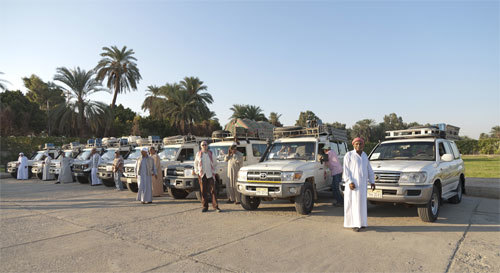 The Eastern Desert Survey Expedition.Most of us have a passing familiarity with the wonders of ancient Egypt, if chiefly with Tutankhamun’s fabulous burial treasure. But the big mystery is how such a sophisticated culture sprang up so quickly, as if from nowhere, and how this ties in with civilisation's best-known founding story, the Old Testament.
The Eastern Desert Survey Expedition.Most of us have a passing familiarity with the wonders of ancient Egypt, if chiefly with Tutankhamun’s fabulous burial treasure. But the big mystery is how such a sophisticated culture sprang up so quickly, as if from nowhere, and how this ties in with civilisation's best-known founding story, the Old Testament.
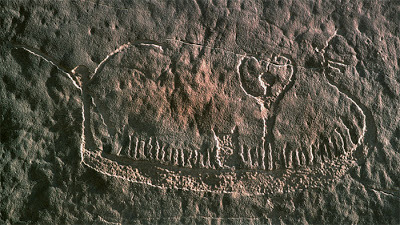 Rock-art boat from the Wadi Barramiya. The Eastern Desert rock carvings depict an epic journey made by a godlike people – exotic and terrible strangers – who, by what looks to have been a surprise invasion of Egypt, dragged their large reed ships overland from the Red Sea to the Nile. These were plainly warships, with up to eighty oars apiece, their chieftains armed to the teeth and pointing westward. Great lines of other men are shown dragging the ships with ropes. Strategically, you can see how it could have worked: haul the ships two-thirds of the way, get into the dried-up river beds, then wait for the annual high Nile to carry you to war at eighty-oar speed.Rohl is convinced that these invaders came from Mesopotamia at the onset of the third millennium BC: “We can tell this from their style of weapons, ship design, their dress and their religious symbolism”, he says. “They carry pear-shaped maces, far more lethal than the disc-shaped maces the Egyptians used at that time, and their ships are typical Mesopotamian seagoing vessels. Their chieftains wear tall twin plumes, and kilts with animals’ tails attached. I've linked them with the mythical ‘followers of Horus’ because the carvings feature the falcon god, Horus”.
Rock-art boat from the Wadi Barramiya. The Eastern Desert rock carvings depict an epic journey made by a godlike people – exotic and terrible strangers – who, by what looks to have been a surprise invasion of Egypt, dragged their large reed ships overland from the Red Sea to the Nile. These were plainly warships, with up to eighty oars apiece, their chieftains armed to the teeth and pointing westward. Great lines of other men are shown dragging the ships with ropes. Strategically, you can see how it could have worked: haul the ships two-thirds of the way, get into the dried-up river beds, then wait for the annual high Nile to carry you to war at eighty-oar speed.Rohl is convinced that these invaders came from Mesopotamia at the onset of the third millennium BC: “We can tell this from their style of weapons, ship design, their dress and their religious symbolism”, he says. “They carry pear-shaped maces, far more lethal than the disc-shaped maces the Egyptians used at that time, and their ships are typical Mesopotamian seagoing vessels. Their chieftains wear tall twin plumes, and kilts with animals’ tails attached. I've linked them with the mythical ‘followers of Horus’ because the carvings feature the falcon god, Horus”.
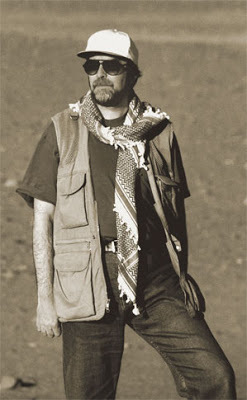
Rohl’s interpretation of these rock-art sequences as an all-out invasion of Egypt neatly elides, with an archeologically famous ceremonial knife. Unearthed at nearby Gebel el-Arak, it was made in the same era as the invasion. Carved on its ivory handle is the world’s oldest pictorial record of a battle. “And we know who won it”, says Rohl, “because it shows the long-haired Nile valley dwellers succumbing to the pear-shaped maces of the short-haired invaders. We also see the high-prowed boats knocking the hell out of the people in the crescent-shaped Nile boats, who are shown drowning”.Further evidence strongly suggests that these foreigners eventually became the pharaohs: “Within 500 years, in pyramids and tombs, we begin to see all this Mesopotamian symbolism now become part of Egyptian culture. The gods wear tall twin plumes, the kings have tails attached to their kilts, and the bodies of the pharaohs are dragged to their underworld tombs in high-prowed ships. After the falcon god in the rock carvings, we soon get the Horus kings of Egypt. We see pharaohs smiting their enemies with pear-shaped maces and, as with King Tut, they're all depicted wearing false beards, as if imitating the divine heroes of Mesopotamia”.But what has all this to do with civilisation’s founding story, as told in the Old Testament (OT)? According to Genesis, following Adam's ancestral line from the Garden of Eden, through Noah and the flood, it was Ham’s second son, Mizra, who came with his tribe and settled Egypt. Still today, an Egyptian will refer to himself as a descendant of Masr. Not just a phonetic similarity, it’s an etymological fit.As civilisation’s founding stories go, the OT is no means an exclusive. The Sumerian and Akkadian epics come to us from Mesopotamia, written down for the first time – in cuneiform script on clay tablets – circa 2,500 BC. Albeit with different names, they tell the same story – the first of all stories – involving the same principal characters. Like Eve in the OT, in Mesopotamian legend ‘the Lady of the Rib’ is banished from eternal life in heaven. Next, there’s Noah, the exact double of the Sumerian flood hero Utnapishtim. Both send out doves from the ark to find dry land. Later, Noah's great-grandson, Nimrod – warrior, mighty hunter and builder of the great city of Erech – has his twin in the Sumerian saga of Enmerkar, ‘Enmer the Hunter’, the warrior and builder-king of Uruk. Same man, same city?But of all Rohl’s evidence for the adoption of Mesopotamian culture by Egypt, here's a language detail to lift the hair on your neck. The odd epithet ascribed to the ancient Mesopotamian flood hero, ‘the far distant’, is the exact meaning of the Egyptian word ‘Horus’. This takes you from Noah to the pharaohs in just one word.
That Rohl packs more into one book than most archeologist-historians would attempt to set down in a lifetime is only the half of it. In his latest work, The Lost Testament, he upsets convention, very ably demonstrating that the OT was in part based on real people and actual events. Following the Mesopotamian invasion of Egypt, he pieces together Joseph’s life as Pharaoh's right-hand man, through to how Moses came to learn the true name of God – Yahweh – to the exodus, the Israelites’ storming of the Promised Land, and the extraordinary rise of King Saul and King David, ending with the fall of Jerusalem to Nebuchadnezzar in the sixth century BC – 5,000 years of history delivered at a tremendous lick. If, here and there, Rohl’s evidence reads a little thin, it’s chiefly because he’s attempted to tell a seamless story for a lay audience. At the back of each chapter, however, he presents his evidence cold.Of course, conventional academic wisdom holds that the OT is little better than a fairy story because no archaeological evidence for it has been found. On the contrary, says Rohl. There’s evidence galore, and all sorts of specialists have been staring at it for decades. The mistake, he argues, is that the ancient world has been dated wrongly. Take Joshua and his Israelite army destroying the city of Jericho. Jericho’s tumbled walls are still there, along with storage jars, the grain inside burnt to a cinder, consistent with Joshua's infamous torching of the city. The glitch is that orthodox chronology would place Joshua at the end of the Late Bronze Age, when no such fortified cities were built. Hence, either Joshua was born too late to have had anything to do with Jericho, or he never existed. Everyone's problem, of course, is that there were no calendars BC, only tantalisingly incomplete king lists and dynastic records. All we have, then, are evidence-based interpretations – and ferocious arguments.
When Rohl first advanced his new chronology in A Test of Time, published in 1995, he got some awful stick. The leading Bible scholar Professor Thomas L Thompson insisted that any attempt to write history based on a direct integration of biblical and extra-biblical sources was "not only dubious but wholly ludicrous". The very architect of Egyptian chronology, Professor Kenneth Kitchen, dismissed Rohl’s thesis as "98% rubbish".
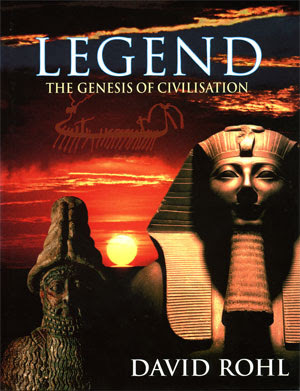
Undeterred, in his next book, Legend, Rohl advanced new discoveries relating to the Book of Genesis. Indeed, as readers of The Sunday Times may recall, he even gave a geographical fix for the Garden of Eden, in Iran, based on his deciphering of the ancient language names of four rivers given as co-ordinates in Genesis, chapter two. For our story, we went and we saw, including a place ‘east of Eden’, as described in Genesis, that is still called Noqdi, the Land of Nod.In the interim, the pendulum of serious opinion has begun to swing Rohl’s way. Dr Ronald Wallenfels, for example, the curator of New York’s Metropolitan Museum, and an Assyrian specialist, says there's plenty of flexibility in the ancient Assyrian dates. Given that all chronologies are interdependent, the same flexibility would inevitably apply to the Egyptian time line. Just recently too, one of Rohl’s peers, an American Egyptologist, cold-canvassed a number of other Egyptologists with a single question: if you were to place the Israelite sojourn and exodus in any period in history, what would it be? The majority picked the middle Bronze Age, concurring with Rohl.Of all OT characters, the best drawn is Abraham's descendant Joseph, but Rohl gives him the evidential kiss of life. This – to remind you – is Joseph of the coat of many colours, whose jealous brothers had him sold as a slave into Egypt. Eventually, his talent for dream interpretation brings him to the attention of Pharaoh, who has had a nightmare of seven emaciated cattle rising up out of the Nile to devour seven fat cattle. As Joseph divined it, seven years of plenty would be followed by seven of famine, and he urged Pharaoh to reorganise the nation's grain supply against the lean time to come. Joseph, the Hebrew foreigner, got the job of vizier of all Egypt.
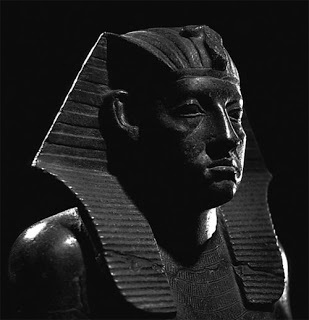 Pharaoh Amenemhat III.But did it happen, and if so, what caused the famine years? In 1844 a German Egyptologist discovered a series of flood records – water heights chipped into cliff faces just south of the Nile's second cataract. Dating from the late 12th Dynasty, when Rohl’s chronology places Joseph in Egypt under Pharaoh Amenemhat III, the records show flood heights of nine metres above normal. The American hydrologist Barbara Bell recently calculated that, on those reckonings, the Nile valley would have been inundated with four times the usual volume of water, making seed-sowing impossible for several years and famine inevitable.The OT also tells us that Joseph, as part of the now-centralised grain strategy, forced Egypt’s landowners to sell him their stocks. Intriguingly, the 12th-Dynasty archeological record shows that tomb building for regional chieftains suddenly ceased, as if they’d been dispossessed. Separately, contemporaneous Egyptian papyrus documents mention the setting up of an agricultural office called ‘the Department of the People's Giving’. Grain to be handed in for later redistribution in the famine years?
Pharaoh Amenemhat III.But did it happen, and if so, what caused the famine years? In 1844 a German Egyptologist discovered a series of flood records – water heights chipped into cliff faces just south of the Nile's second cataract. Dating from the late 12th Dynasty, when Rohl’s chronology places Joseph in Egypt under Pharaoh Amenemhat III, the records show flood heights of nine metres above normal. The American hydrologist Barbara Bell recently calculated that, on those reckonings, the Nile valley would have been inundated with four times the usual volume of water, making seed-sowing impossible for several years and famine inevitable.The OT also tells us that Joseph, as part of the now-centralised grain strategy, forced Egypt’s landowners to sell him their stocks. Intriguingly, the 12th-Dynasty archeological record shows that tomb building for regional chieftains suddenly ceased, as if they’d been dispossessed. Separately, contemporaneous Egyptian papyrus documents mention the setting up of an agricultural office called ‘the Department of the People's Giving’. Grain to be handed in for later redistribution in the famine years?
 The Bahr Yussef.Stronger evidence suggests that reorganising Egypt’s grain supplies was by no means Joseph's only great work. We know from Diodorus Siculus, writing in the first century BC, that a canal was dug to drain off the Nile’s destructive inundations. Today, in the Arabic, the canal is still known as Bahr Yussef, the Waterway of Joseph. At the time, Amenemhat III was so taken with the canal, he had his pyramid built overlooking it.Rohl’s research has produced evidence that Joseph, a Hebrew regarded as the saviour of Egypt, had his own palace at Avaris in the part of the Nile delta known in the OT as Goshen. As per the OT too, Hebrews were now so welcome in Egypt that they soon became very influential in Egyptian affairs, and the archeology concurs: wealthy Semitic graves at the Middle Bronze Age level have been found at Avaris. Joseph, at his death, unheard of for a foreigner, was entombed in a small pyramid in the grounds of his palace, with a chapel containing his colossal cult statue.On Rohl’s reading, it was following a series of weak 13th-Dynasty pharaohs, with consequent political chaos in Egypt, that the Hebrews were infamously pressed into slavery. Grimly tallying, Middle Bronze Age documents have yielded up pharaonic slave lists with Hebrew names, and the tin-pot grave goods of an underclass have been unearthed at Avaris. When excavated, Joseph's pyramid tomb turned out to be empty. "But that’s consistent with his dying wish to be returned to the Promised Land," argues Rohl. "At the Exodus, they took his body with them”. What was found in the chapel of the tomb, however, was a busted-up painted statue of an Asiatically pale fellow with reddish hair adorned with the multi-coloured coat of a Middle Bronze Age chieftain.Although seemingly outrageous, Rohl’s bold placing of these events in time, often to the very year, has lately been vindicated by independent researchers, here and in the United States, in the complex field of astronomical dating. What they did was to retro-calculate the dates of astronomical events – chiefly eclipses and moon phases – as described in the ancient texts. And the results? Rohl had fixed the coronation date of Joseph’s pharaoh, Amenemhat III, at 1678 BC. It turned out that he had missed by just four years, and has since tweaked his time line accordingly.Also, in a head-to-head contest, Rohl's placing of Amenemhat III in the seventeenth century BC resulted in 37 out of 39 lunar month-length matches, whereas orthodox chronology – which keeps its options open with two possible placings – scored no better than 21 matches. The astronomer Dr David Lappin of Glasgow university, concluded: “Most of the astronomical data – particularly the 12th-Dynasty lunar dates simply do not fit with the orthodox chronology, while the support it gives to David Rohl’s new chronology is nothing less than startling”.So let's revisit Jericho for a moment. The Book of Joshua describes the Israelites destroying not just Jericho but also the cities of Ai, Debir, Hebron and Hazor. “And the king of Hazor is actually mentioned by name – King Jabin, who was personally knifed to death by Joshua” says Rohl. “Now, at Hazor they've found a tablet with the name Jabin on it. And where? In the same Middle Bronze Age levels that mark the destruction of Jericho”.
The Bahr Yussef.Stronger evidence suggests that reorganising Egypt’s grain supplies was by no means Joseph's only great work. We know from Diodorus Siculus, writing in the first century BC, that a canal was dug to drain off the Nile’s destructive inundations. Today, in the Arabic, the canal is still known as Bahr Yussef, the Waterway of Joseph. At the time, Amenemhat III was so taken with the canal, he had his pyramid built overlooking it.Rohl’s research has produced evidence that Joseph, a Hebrew regarded as the saviour of Egypt, had his own palace at Avaris in the part of the Nile delta known in the OT as Goshen. As per the OT too, Hebrews were now so welcome in Egypt that they soon became very influential in Egyptian affairs, and the archeology concurs: wealthy Semitic graves at the Middle Bronze Age level have been found at Avaris. Joseph, at his death, unheard of for a foreigner, was entombed in a small pyramid in the grounds of his palace, with a chapel containing his colossal cult statue.On Rohl’s reading, it was following a series of weak 13th-Dynasty pharaohs, with consequent political chaos in Egypt, that the Hebrews were infamously pressed into slavery. Grimly tallying, Middle Bronze Age documents have yielded up pharaonic slave lists with Hebrew names, and the tin-pot grave goods of an underclass have been unearthed at Avaris. When excavated, Joseph's pyramid tomb turned out to be empty. "But that’s consistent with his dying wish to be returned to the Promised Land," argues Rohl. "At the Exodus, they took his body with them”. What was found in the chapel of the tomb, however, was a busted-up painted statue of an Asiatically pale fellow with reddish hair adorned with the multi-coloured coat of a Middle Bronze Age chieftain.Although seemingly outrageous, Rohl’s bold placing of these events in time, often to the very year, has lately been vindicated by independent researchers, here and in the United States, in the complex field of astronomical dating. What they did was to retro-calculate the dates of astronomical events – chiefly eclipses and moon phases – as described in the ancient texts. And the results? Rohl had fixed the coronation date of Joseph’s pharaoh, Amenemhat III, at 1678 BC. It turned out that he had missed by just four years, and has since tweaked his time line accordingly.Also, in a head-to-head contest, Rohl's placing of Amenemhat III in the seventeenth century BC resulted in 37 out of 39 lunar month-length matches, whereas orthodox chronology – which keeps its options open with two possible placings – scored no better than 21 matches. The astronomer Dr David Lappin of Glasgow university, concluded: “Most of the astronomical data – particularly the 12th-Dynasty lunar dates simply do not fit with the orthodox chronology, while the support it gives to David Rohl’s new chronology is nothing less than startling”.So let's revisit Jericho for a moment. The Book of Joshua describes the Israelites destroying not just Jericho but also the cities of Ai, Debir, Hebron and Hazor. “And the king of Hazor is actually mentioned by name – King Jabin, who was personally knifed to death by Joshua” says Rohl. “Now, at Hazor they've found a tablet with the name Jabin on it. And where? In the same Middle Bronze Age levels that mark the destruction of Jericho”.
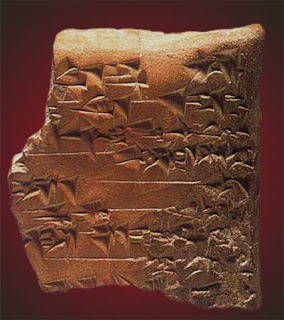 The Jabin Tablet from Hazor.
The Jabin Tablet from Hazor.
Of all the scoops in The Lost Testament, Rohl's marshalling of evidence for the late-eleventh-century life and times of King Saul is so impressive that it makes the orthodoxy look like a flat-Earth proposition. Background: at the same time that a politically complacent pharaoh, Akhenaten, came to power in Egypt, the Israelites found themselves with a fierce warrior leader in Saul. Saul – Shaul in Hebrew – was not his actual name, but an epithet meaning ‘asked for (by the people)’ that was given to him by the later Bible writer.So who was this first king of Israel, what was his real name, and what evidence is there, outside the OT, of his existence? One of the great finds of the mid-nineteenth century was the el-Amarna letters, 3,000-year-old eyewitness accounts, in the form of 380 clay tablets, that represent the correspondence sent to Pharaoh Akhenaten by his vassal rulers. They tell of a new and belligerent Habiru rebel leader called Labaya. Some letters from vassal kings complain to Pharaoh that Labaya keeps making war on them. Others, from Labaya himself, reveal a crafty long-game specialist.
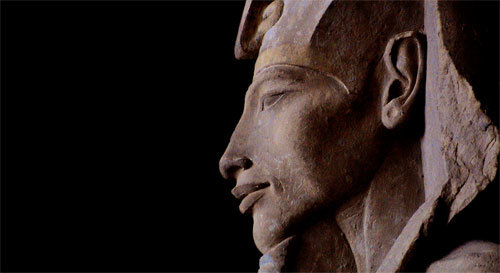 Akhenaten in whose capital the Amarna Letters were found.The thing to grasp here is that the orthodox time line fixes Saul and his Hebrew army at a distance of three centuries from Labaya and his Habiru fighters. In Rohl’s chronology, however, they come up as exact contemporaries. But are they the same man? Judge for yourself.As per the OT, Saul, having declared his war of liberation, seized the two towns of Gibeah and Michmash. Similarly, in a letter from Labaya to Pharaoh, the Habiru chieftain argues that his recent taking of two towns was justified because they were his in the first place. Bolshie in the extreme, this particular letter not only omits the customary obeisance – ‘I am the dirt under your feet’ – but issues Pharaoh with a veiled warning – “If an ant is struck, does it not fight back and bite the hand of the man that struck it?”More persuasive that Labaya was Saul is their identical family politics. In the Bible account, Saul was enraged by the close friendship of his son Jonathan with the rebel mercenary David. Since David was also Saul's son-in-law, he and Jonathan should have been rivals for the kingship. Instead, famously, they doted on each other. In the OT, Saul cursed Jonathan as the “son of slut” – and you can see why. At one point, his bosom pal David and his Hebrew mercenaries were fighting on the side of the Philistines against Saul. And guess what: Labaya, in an ostensibly embarrassed letter to Pharaoh, protests that he didn't know that his son was consorting with the Habiru.The name of one of the rebel leaders in the Amarna Letters, Tadua – an epithet bestowed on him by his Hurrian warriors – means “the beloved”. The Hebrew name David also means ‘the beloved’, which in its earlier, Canaanite form would have been written as Dadua. But the clincher is that Saul and Labaya shared exactly the same death. As in the OT, so in the Amarna Letters, both die in battle – against a coalition of city-states from the coastal plain – on or near Mount Gilboa, both as a result of betrayal.Combining information from both the Bible and the Amarna letters, Rohl has reconstructed the course of the battle. At first, it seemed that Labaya/Saul couldn't lose. He was at the top of Mount Gilboa, and the only access for Philistine chariots and archers was protected by his ally Tagu. But Tagu had done a treacherous deal with the Philistines and, in a surprise onslaught from the rear, Labaya was mortally wounded. Rather than be taken in shackles to Egypt for ritual slaughter, however, he fell on his own sword.Rohl completes this chapter with a stunning flourish. The OT also tells us that Saul's body was taken from Mount Gilboa to the fortress of Beth-Shean, beheaded there, and hung on the wall. Three thousand years later, in 1993, the excavators of Beth-Shean found a fragment of a small cylinder seal, the sort used for quick communication between allied commanders in battle. Cylinder seals usually came with a string attached for hanging them around your neck. The Beth-Shean seal fragment reads: “To Labaya, my Lord, speak. Message from Tagu: ‘To the king my Lord. I have listened carefully to your message from me’”. The rest is missing. Let Rohl savour it: “So here we have a message from the traitor Tagu, probably delivered to King Labaya/Saul before the battle on Mount Gilboa, then carried here to Beth-Shean still around the king’s neck, fallen to the ground when he was beheaded”.But what of David? Later in the OT, King David, as he now is, storms and takes Jerusalem. Among the Amarna letters is a plea from Abdi-Heba, the ruler of Jerusalem, begging Pharaoh for reinforcements against the besieging Habiru army. Then the pleas stop. Jerusalem has fallen.The final battle between the Philistines and the all-conquering Hebrews is described in both the OT and the Amarna Letters as having taken place in exactly the same spot – just outside Jerusalem, in the Vale of Rephaim. One difficulty in fixing King David as a real historical figure was the lack of evidence outside the ancient texts. Until just under a decade ago that is, when a stone stela fragment bearing the phrase ‘The House of David’ was found in the city of Dan, incorporated into a 2,800-year-old wall.
Akhenaten in whose capital the Amarna Letters were found.The thing to grasp here is that the orthodox time line fixes Saul and his Hebrew army at a distance of three centuries from Labaya and his Habiru fighters. In Rohl’s chronology, however, they come up as exact contemporaries. But are they the same man? Judge for yourself.As per the OT, Saul, having declared his war of liberation, seized the two towns of Gibeah and Michmash. Similarly, in a letter from Labaya to Pharaoh, the Habiru chieftain argues that his recent taking of two towns was justified because they were his in the first place. Bolshie in the extreme, this particular letter not only omits the customary obeisance – ‘I am the dirt under your feet’ – but issues Pharaoh with a veiled warning – “If an ant is struck, does it not fight back and bite the hand of the man that struck it?”More persuasive that Labaya was Saul is their identical family politics. In the Bible account, Saul was enraged by the close friendship of his son Jonathan with the rebel mercenary David. Since David was also Saul's son-in-law, he and Jonathan should have been rivals for the kingship. Instead, famously, they doted on each other. In the OT, Saul cursed Jonathan as the “son of slut” – and you can see why. At one point, his bosom pal David and his Hebrew mercenaries were fighting on the side of the Philistines against Saul. And guess what: Labaya, in an ostensibly embarrassed letter to Pharaoh, protests that he didn't know that his son was consorting with the Habiru.The name of one of the rebel leaders in the Amarna Letters, Tadua – an epithet bestowed on him by his Hurrian warriors – means “the beloved”. The Hebrew name David also means ‘the beloved’, which in its earlier, Canaanite form would have been written as Dadua. But the clincher is that Saul and Labaya shared exactly the same death. As in the OT, so in the Amarna Letters, both die in battle – against a coalition of city-states from the coastal plain – on or near Mount Gilboa, both as a result of betrayal.Combining information from both the Bible and the Amarna letters, Rohl has reconstructed the course of the battle. At first, it seemed that Labaya/Saul couldn't lose. He was at the top of Mount Gilboa, and the only access for Philistine chariots and archers was protected by his ally Tagu. But Tagu had done a treacherous deal with the Philistines and, in a surprise onslaught from the rear, Labaya was mortally wounded. Rather than be taken in shackles to Egypt for ritual slaughter, however, he fell on his own sword.Rohl completes this chapter with a stunning flourish. The OT also tells us that Saul's body was taken from Mount Gilboa to the fortress of Beth-Shean, beheaded there, and hung on the wall. Three thousand years later, in 1993, the excavators of Beth-Shean found a fragment of a small cylinder seal, the sort used for quick communication between allied commanders in battle. Cylinder seals usually came with a string attached for hanging them around your neck. The Beth-Shean seal fragment reads: “To Labaya, my Lord, speak. Message from Tagu: ‘To the king my Lord. I have listened carefully to your message from me’”. The rest is missing. Let Rohl savour it: “So here we have a message from the traitor Tagu, probably delivered to King Labaya/Saul before the battle on Mount Gilboa, then carried here to Beth-Shean still around the king’s neck, fallen to the ground when he was beheaded”.But what of David? Later in the OT, King David, as he now is, storms and takes Jerusalem. Among the Amarna letters is a plea from Abdi-Heba, the ruler of Jerusalem, begging Pharaoh for reinforcements against the besieging Habiru army. Then the pleas stop. Jerusalem has fallen.The final battle between the Philistines and the all-conquering Hebrews is described in both the OT and the Amarna Letters as having taken place in exactly the same spot – just outside Jerusalem, in the Vale of Rephaim. One difficulty in fixing King David as a real historical figure was the lack of evidence outside the ancient texts. Until just under a decade ago that is, when a stone stela fragment bearing the phrase ‘The House of David’ was found in the city of Dan, incorporated into a 2,800-year-old wall.
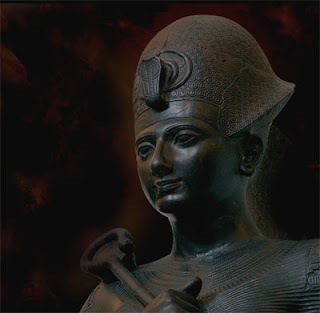 Ramesses II.As after a round of musical chairs, not the least effect of Rohl’s New Chronology is that many ancient figures have switched thrones. That of mighty Ramesses II of the 19th Dynasty, once thought to be the repressive Pharaoh of the Exodus, is now taken by Dudimose, a petty king of the 13th Dynasty. Ramesses, meanwhile, becomes a contemporary of the Israelite King Solomon, David’s son. Orthodox chronology puts Solomon in the relatively impoverished early Iron Age. But, as described in the First Book of Kings, Solomon’s reputation as a successful merchant king sits far better in the wealthy Late Bronze Age.Take his fabulous palaces, commissioned from the best of ancient stonemasons, the Phoenicians. They used three rows of fine-cut stone, topped by a cedar beam, backfilled with rubble to protect the structure against earth tremors. Today, Solomon's Late Bronze Age gate at Megiddo is a perfect example. No similar construction technique was used in the early Iron Age, where orthodoxy places Solomon.
Ramesses II.As after a round of musical chairs, not the least effect of Rohl’s New Chronology is that many ancient figures have switched thrones. That of mighty Ramesses II of the 19th Dynasty, once thought to be the repressive Pharaoh of the Exodus, is now taken by Dudimose, a petty king of the 13th Dynasty. Ramesses, meanwhile, becomes a contemporary of the Israelite King Solomon, David’s son. Orthodox chronology puts Solomon in the relatively impoverished early Iron Age. But, as described in the First Book of Kings, Solomon’s reputation as a successful merchant king sits far better in the wealthy Late Bronze Age.Take his fabulous palaces, commissioned from the best of ancient stonemasons, the Phoenicians. They used three rows of fine-cut stone, topped by a cedar beam, backfilled with rubble to protect the structure against earth tremors. Today, Solomon's Late Bronze Age gate at Megiddo is a perfect example. No similar construction technique was used in the early Iron Age, where orthodoxy places Solomon.
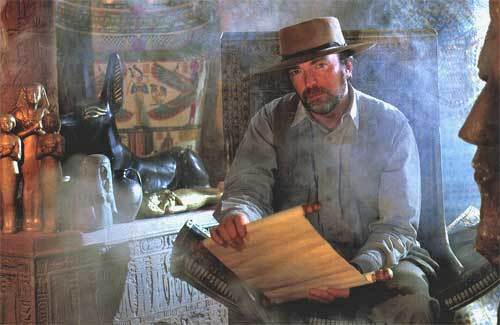 Sunday Times Magazine front cover picture (1995).A nonbeliever, Rohl has no religious mission to vindicate the Old Testament. “I don't doubt that I've got some of the details of this historical reconstruction wrong”, he says, “but I find the big picture so convincing. If I am wrong, so be it – but let’s see the evidence, not the dogma”.
Sunday Times Magazine front cover picture (1995).A nonbeliever, Rohl has no religious mission to vindicate the Old Testament. “I don't doubt that I've got some of the details of this historical reconstruction wrong”, he says, “but I find the big picture so convincing. If I am wrong, so be it – but let’s see the evidence, not the dogma”.

The Eastern Desert, situated between the Red Sea and the Nile, is a fairly barren place that has never much caught the interest of archeologists. An exception was Hans Winkler, who, when he came here in the 1930s, recorded scads of ancient rock carvings depicting strange high-prowed ships, right here in the desert. Winkler died puzzled, and nobody laid eyes on the carvings again until the Egyptologist David Rohl, on an expedition here in 1997, recognised them as an extraordinary archeological scoop.
 The Eastern Desert Survey Expedition.Most of us have a passing familiarity with the wonders of ancient Egypt, if chiefly with Tutankhamun’s fabulous burial treasure. But the big mystery is how such a sophisticated culture sprang up so quickly, as if from nowhere, and how this ties in with civilisation's best-known founding story, the Old Testament.
The Eastern Desert Survey Expedition.Most of us have a passing familiarity with the wonders of ancient Egypt, if chiefly with Tutankhamun’s fabulous burial treasure. But the big mystery is how such a sophisticated culture sprang up so quickly, as if from nowhere, and how this ties in with civilisation's best-known founding story, the Old Testament.
 Rock-art boat from the Wadi Barramiya. The Eastern Desert rock carvings depict an epic journey made by a godlike people – exotic and terrible strangers – who, by what looks to have been a surprise invasion of Egypt, dragged their large reed ships overland from the Red Sea to the Nile. These were plainly warships, with up to eighty oars apiece, their chieftains armed to the teeth and pointing westward. Great lines of other men are shown dragging the ships with ropes. Strategically, you can see how it could have worked: haul the ships two-thirds of the way, get into the dried-up river beds, then wait for the annual high Nile to carry you to war at eighty-oar speed.Rohl is convinced that these invaders came from Mesopotamia at the onset of the third millennium BC: “We can tell this from their style of weapons, ship design, their dress and their religious symbolism”, he says. “They carry pear-shaped maces, far more lethal than the disc-shaped maces the Egyptians used at that time, and their ships are typical Mesopotamian seagoing vessels. Their chieftains wear tall twin plumes, and kilts with animals’ tails attached. I've linked them with the mythical ‘followers of Horus’ because the carvings feature the falcon god, Horus”.
Rock-art boat from the Wadi Barramiya. The Eastern Desert rock carvings depict an epic journey made by a godlike people – exotic and terrible strangers – who, by what looks to have been a surprise invasion of Egypt, dragged their large reed ships overland from the Red Sea to the Nile. These were plainly warships, with up to eighty oars apiece, their chieftains armed to the teeth and pointing westward. Great lines of other men are shown dragging the ships with ropes. Strategically, you can see how it could have worked: haul the ships two-thirds of the way, get into the dried-up river beds, then wait for the annual high Nile to carry you to war at eighty-oar speed.Rohl is convinced that these invaders came from Mesopotamia at the onset of the third millennium BC: “We can tell this from their style of weapons, ship design, their dress and their religious symbolism”, he says. “They carry pear-shaped maces, far more lethal than the disc-shaped maces the Egyptians used at that time, and their ships are typical Mesopotamian seagoing vessels. Their chieftains wear tall twin plumes, and kilts with animals’ tails attached. I've linked them with the mythical ‘followers of Horus’ because the carvings feature the falcon god, Horus”.
Rohl’s interpretation of these rock-art sequences as an all-out invasion of Egypt neatly elides, with an archeologically famous ceremonial knife. Unearthed at nearby Gebel el-Arak, it was made in the same era as the invasion. Carved on its ivory handle is the world’s oldest pictorial record of a battle. “And we know who won it”, says Rohl, “because it shows the long-haired Nile valley dwellers succumbing to the pear-shaped maces of the short-haired invaders. We also see the high-prowed boats knocking the hell out of the people in the crescent-shaped Nile boats, who are shown drowning”.Further evidence strongly suggests that these foreigners eventually became the pharaohs: “Within 500 years, in pyramids and tombs, we begin to see all this Mesopotamian symbolism now become part of Egyptian culture. The gods wear tall twin plumes, the kings have tails attached to their kilts, and the bodies of the pharaohs are dragged to their underworld tombs in high-prowed ships. After the falcon god in the rock carvings, we soon get the Horus kings of Egypt. We see pharaohs smiting their enemies with pear-shaped maces and, as with King Tut, they're all depicted wearing false beards, as if imitating the divine heroes of Mesopotamia”.But what has all this to do with civilisation’s founding story, as told in the Old Testament (OT)? According to Genesis, following Adam's ancestral line from the Garden of Eden, through Noah and the flood, it was Ham’s second son, Mizra, who came with his tribe and settled Egypt. Still today, an Egyptian will refer to himself as a descendant of Masr. Not just a phonetic similarity, it’s an etymological fit.As civilisation’s founding stories go, the OT is no means an exclusive. The Sumerian and Akkadian epics come to us from Mesopotamia, written down for the first time – in cuneiform script on clay tablets – circa 2,500 BC. Albeit with different names, they tell the same story – the first of all stories – involving the same principal characters. Like Eve in the OT, in Mesopotamian legend ‘the Lady of the Rib’ is banished from eternal life in heaven. Next, there’s Noah, the exact double of the Sumerian flood hero Utnapishtim. Both send out doves from the ark to find dry land. Later, Noah's great-grandson, Nimrod – warrior, mighty hunter and builder of the great city of Erech – has his twin in the Sumerian saga of Enmerkar, ‘Enmer the Hunter’, the warrior and builder-king of Uruk. Same man, same city?But of all Rohl’s evidence for the adoption of Mesopotamian culture by Egypt, here's a language detail to lift the hair on your neck. The odd epithet ascribed to the ancient Mesopotamian flood hero, ‘the far distant’, is the exact meaning of the Egyptian word ‘Horus’. This takes you from Noah to the pharaohs in just one word.

That Rohl packs more into one book than most archeologist-historians would attempt to set down in a lifetime is only the half of it. In his latest work, The Lost Testament, he upsets convention, very ably demonstrating that the OT was in part based on real people and actual events. Following the Mesopotamian invasion of Egypt, he pieces together Joseph’s life as Pharaoh's right-hand man, through to how Moses came to learn the true name of God – Yahweh – to the exodus, the Israelites’ storming of the Promised Land, and the extraordinary rise of King Saul and King David, ending with the fall of Jerusalem to Nebuchadnezzar in the sixth century BC – 5,000 years of history delivered at a tremendous lick. If, here and there, Rohl’s evidence reads a little thin, it’s chiefly because he’s attempted to tell a seamless story for a lay audience. At the back of each chapter, however, he presents his evidence cold.Of course, conventional academic wisdom holds that the OT is little better than a fairy story because no archaeological evidence for it has been found. On the contrary, says Rohl. There’s evidence galore, and all sorts of specialists have been staring at it for decades. The mistake, he argues, is that the ancient world has been dated wrongly. Take Joshua and his Israelite army destroying the city of Jericho. Jericho’s tumbled walls are still there, along with storage jars, the grain inside burnt to a cinder, consistent with Joshua's infamous torching of the city. The glitch is that orthodox chronology would place Joshua at the end of the Late Bronze Age, when no such fortified cities were built. Hence, either Joshua was born too late to have had anything to do with Jericho, or he never existed. Everyone's problem, of course, is that there were no calendars BC, only tantalisingly incomplete king lists and dynastic records. All we have, then, are evidence-based interpretations – and ferocious arguments.

When Rohl first advanced his new chronology in A Test of Time, published in 1995, he got some awful stick. The leading Bible scholar Professor Thomas L Thompson insisted that any attempt to write history based on a direct integration of biblical and extra-biblical sources was "not only dubious but wholly ludicrous". The very architect of Egyptian chronology, Professor Kenneth Kitchen, dismissed Rohl’s thesis as "98% rubbish".

Undeterred, in his next book, Legend, Rohl advanced new discoveries relating to the Book of Genesis. Indeed, as readers of The Sunday Times may recall, he even gave a geographical fix for the Garden of Eden, in Iran, based on his deciphering of the ancient language names of four rivers given as co-ordinates in Genesis, chapter two. For our story, we went and we saw, including a place ‘east of Eden’, as described in Genesis, that is still called Noqdi, the Land of Nod.In the interim, the pendulum of serious opinion has begun to swing Rohl’s way. Dr Ronald Wallenfels, for example, the curator of New York’s Metropolitan Museum, and an Assyrian specialist, says there's plenty of flexibility in the ancient Assyrian dates. Given that all chronologies are interdependent, the same flexibility would inevitably apply to the Egyptian time line. Just recently too, one of Rohl’s peers, an American Egyptologist, cold-canvassed a number of other Egyptologists with a single question: if you were to place the Israelite sojourn and exodus in any period in history, what would it be? The majority picked the middle Bronze Age, concurring with Rohl.Of all OT characters, the best drawn is Abraham's descendant Joseph, but Rohl gives him the evidential kiss of life. This – to remind you – is Joseph of the coat of many colours, whose jealous brothers had him sold as a slave into Egypt. Eventually, his talent for dream interpretation brings him to the attention of Pharaoh, who has had a nightmare of seven emaciated cattle rising up out of the Nile to devour seven fat cattle. As Joseph divined it, seven years of plenty would be followed by seven of famine, and he urged Pharaoh to reorganise the nation's grain supply against the lean time to come. Joseph, the Hebrew foreigner, got the job of vizier of all Egypt.
 Pharaoh Amenemhat III.But did it happen, and if so, what caused the famine years? In 1844 a German Egyptologist discovered a series of flood records – water heights chipped into cliff faces just south of the Nile's second cataract. Dating from the late 12th Dynasty, when Rohl’s chronology places Joseph in Egypt under Pharaoh Amenemhat III, the records show flood heights of nine metres above normal. The American hydrologist Barbara Bell recently calculated that, on those reckonings, the Nile valley would have been inundated with four times the usual volume of water, making seed-sowing impossible for several years and famine inevitable.The OT also tells us that Joseph, as part of the now-centralised grain strategy, forced Egypt’s landowners to sell him their stocks. Intriguingly, the 12th-Dynasty archeological record shows that tomb building for regional chieftains suddenly ceased, as if they’d been dispossessed. Separately, contemporaneous Egyptian papyrus documents mention the setting up of an agricultural office called ‘the Department of the People's Giving’. Grain to be handed in for later redistribution in the famine years?
Pharaoh Amenemhat III.But did it happen, and if so, what caused the famine years? In 1844 a German Egyptologist discovered a series of flood records – water heights chipped into cliff faces just south of the Nile's second cataract. Dating from the late 12th Dynasty, when Rohl’s chronology places Joseph in Egypt under Pharaoh Amenemhat III, the records show flood heights of nine metres above normal. The American hydrologist Barbara Bell recently calculated that, on those reckonings, the Nile valley would have been inundated with four times the usual volume of water, making seed-sowing impossible for several years and famine inevitable.The OT also tells us that Joseph, as part of the now-centralised grain strategy, forced Egypt’s landowners to sell him their stocks. Intriguingly, the 12th-Dynasty archeological record shows that tomb building for regional chieftains suddenly ceased, as if they’d been dispossessed. Separately, contemporaneous Egyptian papyrus documents mention the setting up of an agricultural office called ‘the Department of the People's Giving’. Grain to be handed in for later redistribution in the famine years? The Bahr Yussef.Stronger evidence suggests that reorganising Egypt’s grain supplies was by no means Joseph's only great work. We know from Diodorus Siculus, writing in the first century BC, that a canal was dug to drain off the Nile’s destructive inundations. Today, in the Arabic, the canal is still known as Bahr Yussef, the Waterway of Joseph. At the time, Amenemhat III was so taken with the canal, he had his pyramid built overlooking it.Rohl’s research has produced evidence that Joseph, a Hebrew regarded as the saviour of Egypt, had his own palace at Avaris in the part of the Nile delta known in the OT as Goshen. As per the OT too, Hebrews were now so welcome in Egypt that they soon became very influential in Egyptian affairs, and the archeology concurs: wealthy Semitic graves at the Middle Bronze Age level have been found at Avaris. Joseph, at his death, unheard of for a foreigner, was entombed in a small pyramid in the grounds of his palace, with a chapel containing his colossal cult statue.On Rohl’s reading, it was following a series of weak 13th-Dynasty pharaohs, with consequent political chaos in Egypt, that the Hebrews were infamously pressed into slavery. Grimly tallying, Middle Bronze Age documents have yielded up pharaonic slave lists with Hebrew names, and the tin-pot grave goods of an underclass have been unearthed at Avaris. When excavated, Joseph's pyramid tomb turned out to be empty. "But that’s consistent with his dying wish to be returned to the Promised Land," argues Rohl. "At the Exodus, they took his body with them”. What was found in the chapel of the tomb, however, was a busted-up painted statue of an Asiatically pale fellow with reddish hair adorned with the multi-coloured coat of a Middle Bronze Age chieftain.Although seemingly outrageous, Rohl’s bold placing of these events in time, often to the very year, has lately been vindicated by independent researchers, here and in the United States, in the complex field of astronomical dating. What they did was to retro-calculate the dates of astronomical events – chiefly eclipses and moon phases – as described in the ancient texts. And the results? Rohl had fixed the coronation date of Joseph’s pharaoh, Amenemhat III, at 1678 BC. It turned out that he had missed by just four years, and has since tweaked his time line accordingly.Also, in a head-to-head contest, Rohl's placing of Amenemhat III in the seventeenth century BC resulted in 37 out of 39 lunar month-length matches, whereas orthodox chronology – which keeps its options open with two possible placings – scored no better than 21 matches. The astronomer Dr David Lappin of Glasgow university, concluded: “Most of the astronomical data – particularly the 12th-Dynasty lunar dates simply do not fit with the orthodox chronology, while the support it gives to David Rohl’s new chronology is nothing less than startling”.So let's revisit Jericho for a moment. The Book of Joshua describes the Israelites destroying not just Jericho but also the cities of Ai, Debir, Hebron and Hazor. “And the king of Hazor is actually mentioned by name – King Jabin, who was personally knifed to death by Joshua” says Rohl. “Now, at Hazor they've found a tablet with the name Jabin on it. And where? In the same Middle Bronze Age levels that mark the destruction of Jericho”.
The Bahr Yussef.Stronger evidence suggests that reorganising Egypt’s grain supplies was by no means Joseph's only great work. We know from Diodorus Siculus, writing in the first century BC, that a canal was dug to drain off the Nile’s destructive inundations. Today, in the Arabic, the canal is still known as Bahr Yussef, the Waterway of Joseph. At the time, Amenemhat III was so taken with the canal, he had his pyramid built overlooking it.Rohl’s research has produced evidence that Joseph, a Hebrew regarded as the saviour of Egypt, had his own palace at Avaris in the part of the Nile delta known in the OT as Goshen. As per the OT too, Hebrews were now so welcome in Egypt that they soon became very influential in Egyptian affairs, and the archeology concurs: wealthy Semitic graves at the Middle Bronze Age level have been found at Avaris. Joseph, at his death, unheard of for a foreigner, was entombed in a small pyramid in the grounds of his palace, with a chapel containing his colossal cult statue.On Rohl’s reading, it was following a series of weak 13th-Dynasty pharaohs, with consequent political chaos in Egypt, that the Hebrews were infamously pressed into slavery. Grimly tallying, Middle Bronze Age documents have yielded up pharaonic slave lists with Hebrew names, and the tin-pot grave goods of an underclass have been unearthed at Avaris. When excavated, Joseph's pyramid tomb turned out to be empty. "But that’s consistent with his dying wish to be returned to the Promised Land," argues Rohl. "At the Exodus, they took his body with them”. What was found in the chapel of the tomb, however, was a busted-up painted statue of an Asiatically pale fellow with reddish hair adorned with the multi-coloured coat of a Middle Bronze Age chieftain.Although seemingly outrageous, Rohl’s bold placing of these events in time, often to the very year, has lately been vindicated by independent researchers, here and in the United States, in the complex field of astronomical dating. What they did was to retro-calculate the dates of astronomical events – chiefly eclipses and moon phases – as described in the ancient texts. And the results? Rohl had fixed the coronation date of Joseph’s pharaoh, Amenemhat III, at 1678 BC. It turned out that he had missed by just four years, and has since tweaked his time line accordingly.Also, in a head-to-head contest, Rohl's placing of Amenemhat III in the seventeenth century BC resulted in 37 out of 39 lunar month-length matches, whereas orthodox chronology – which keeps its options open with two possible placings – scored no better than 21 matches. The astronomer Dr David Lappin of Glasgow university, concluded: “Most of the astronomical data – particularly the 12th-Dynasty lunar dates simply do not fit with the orthodox chronology, while the support it gives to David Rohl’s new chronology is nothing less than startling”.So let's revisit Jericho for a moment. The Book of Joshua describes the Israelites destroying not just Jericho but also the cities of Ai, Debir, Hebron and Hazor. “And the king of Hazor is actually mentioned by name – King Jabin, who was personally knifed to death by Joshua” says Rohl. “Now, at Hazor they've found a tablet with the name Jabin on it. And where? In the same Middle Bronze Age levels that mark the destruction of Jericho”.
 The Jabin Tablet from Hazor.
The Jabin Tablet from Hazor.Of all the scoops in The Lost Testament, Rohl's marshalling of evidence for the late-eleventh-century life and times of King Saul is so impressive that it makes the orthodoxy look like a flat-Earth proposition. Background: at the same time that a politically complacent pharaoh, Akhenaten, came to power in Egypt, the Israelites found themselves with a fierce warrior leader in Saul. Saul – Shaul in Hebrew – was not his actual name, but an epithet meaning ‘asked for (by the people)’ that was given to him by the later Bible writer.So who was this first king of Israel, what was his real name, and what evidence is there, outside the OT, of his existence? One of the great finds of the mid-nineteenth century was the el-Amarna letters, 3,000-year-old eyewitness accounts, in the form of 380 clay tablets, that represent the correspondence sent to Pharaoh Akhenaten by his vassal rulers. They tell of a new and belligerent Habiru rebel leader called Labaya. Some letters from vassal kings complain to Pharaoh that Labaya keeps making war on them. Others, from Labaya himself, reveal a crafty long-game specialist.
 Akhenaten in whose capital the Amarna Letters were found.The thing to grasp here is that the orthodox time line fixes Saul and his Hebrew army at a distance of three centuries from Labaya and his Habiru fighters. In Rohl’s chronology, however, they come up as exact contemporaries. But are they the same man? Judge for yourself.As per the OT, Saul, having declared his war of liberation, seized the two towns of Gibeah and Michmash. Similarly, in a letter from Labaya to Pharaoh, the Habiru chieftain argues that his recent taking of two towns was justified because they were his in the first place. Bolshie in the extreme, this particular letter not only omits the customary obeisance – ‘I am the dirt under your feet’ – but issues Pharaoh with a veiled warning – “If an ant is struck, does it not fight back and bite the hand of the man that struck it?”More persuasive that Labaya was Saul is their identical family politics. In the Bible account, Saul was enraged by the close friendship of his son Jonathan with the rebel mercenary David. Since David was also Saul's son-in-law, he and Jonathan should have been rivals for the kingship. Instead, famously, they doted on each other. In the OT, Saul cursed Jonathan as the “son of slut” – and you can see why. At one point, his bosom pal David and his Hebrew mercenaries were fighting on the side of the Philistines against Saul. And guess what: Labaya, in an ostensibly embarrassed letter to Pharaoh, protests that he didn't know that his son was consorting with the Habiru.The name of one of the rebel leaders in the Amarna Letters, Tadua – an epithet bestowed on him by his Hurrian warriors – means “the beloved”. The Hebrew name David also means ‘the beloved’, which in its earlier, Canaanite form would have been written as Dadua. But the clincher is that Saul and Labaya shared exactly the same death. As in the OT, so in the Amarna Letters, both die in battle – against a coalition of city-states from the coastal plain – on or near Mount Gilboa, both as a result of betrayal.Combining information from both the Bible and the Amarna letters, Rohl has reconstructed the course of the battle. At first, it seemed that Labaya/Saul couldn't lose. He was at the top of Mount Gilboa, and the only access for Philistine chariots and archers was protected by his ally Tagu. But Tagu had done a treacherous deal with the Philistines and, in a surprise onslaught from the rear, Labaya was mortally wounded. Rather than be taken in shackles to Egypt for ritual slaughter, however, he fell on his own sword.Rohl completes this chapter with a stunning flourish. The OT also tells us that Saul's body was taken from Mount Gilboa to the fortress of Beth-Shean, beheaded there, and hung on the wall. Three thousand years later, in 1993, the excavators of Beth-Shean found a fragment of a small cylinder seal, the sort used for quick communication between allied commanders in battle. Cylinder seals usually came with a string attached for hanging them around your neck. The Beth-Shean seal fragment reads: “To Labaya, my Lord, speak. Message from Tagu: ‘To the king my Lord. I have listened carefully to your message from me’”. The rest is missing. Let Rohl savour it: “So here we have a message from the traitor Tagu, probably delivered to King Labaya/Saul before the battle on Mount Gilboa, then carried here to Beth-Shean still around the king’s neck, fallen to the ground when he was beheaded”.But what of David? Later in the OT, King David, as he now is, storms and takes Jerusalem. Among the Amarna letters is a plea from Abdi-Heba, the ruler of Jerusalem, begging Pharaoh for reinforcements against the besieging Habiru army. Then the pleas stop. Jerusalem has fallen.The final battle between the Philistines and the all-conquering Hebrews is described in both the OT and the Amarna Letters as having taken place in exactly the same spot – just outside Jerusalem, in the Vale of Rephaim. One difficulty in fixing King David as a real historical figure was the lack of evidence outside the ancient texts. Until just under a decade ago that is, when a stone stela fragment bearing the phrase ‘The House of David’ was found in the city of Dan, incorporated into a 2,800-year-old wall.
Akhenaten in whose capital the Amarna Letters were found.The thing to grasp here is that the orthodox time line fixes Saul and his Hebrew army at a distance of three centuries from Labaya and his Habiru fighters. In Rohl’s chronology, however, they come up as exact contemporaries. But are they the same man? Judge for yourself.As per the OT, Saul, having declared his war of liberation, seized the two towns of Gibeah and Michmash. Similarly, in a letter from Labaya to Pharaoh, the Habiru chieftain argues that his recent taking of two towns was justified because they were his in the first place. Bolshie in the extreme, this particular letter not only omits the customary obeisance – ‘I am the dirt under your feet’ – but issues Pharaoh with a veiled warning – “If an ant is struck, does it not fight back and bite the hand of the man that struck it?”More persuasive that Labaya was Saul is their identical family politics. In the Bible account, Saul was enraged by the close friendship of his son Jonathan with the rebel mercenary David. Since David was also Saul's son-in-law, he and Jonathan should have been rivals for the kingship. Instead, famously, they doted on each other. In the OT, Saul cursed Jonathan as the “son of slut” – and you can see why. At one point, his bosom pal David and his Hebrew mercenaries were fighting on the side of the Philistines against Saul. And guess what: Labaya, in an ostensibly embarrassed letter to Pharaoh, protests that he didn't know that his son was consorting with the Habiru.The name of one of the rebel leaders in the Amarna Letters, Tadua – an epithet bestowed on him by his Hurrian warriors – means “the beloved”. The Hebrew name David also means ‘the beloved’, which in its earlier, Canaanite form would have been written as Dadua. But the clincher is that Saul and Labaya shared exactly the same death. As in the OT, so in the Amarna Letters, both die in battle – against a coalition of city-states from the coastal plain – on or near Mount Gilboa, both as a result of betrayal.Combining information from both the Bible and the Amarna letters, Rohl has reconstructed the course of the battle. At first, it seemed that Labaya/Saul couldn't lose. He was at the top of Mount Gilboa, and the only access for Philistine chariots and archers was protected by his ally Tagu. But Tagu had done a treacherous deal with the Philistines and, in a surprise onslaught from the rear, Labaya was mortally wounded. Rather than be taken in shackles to Egypt for ritual slaughter, however, he fell on his own sword.Rohl completes this chapter with a stunning flourish. The OT also tells us that Saul's body was taken from Mount Gilboa to the fortress of Beth-Shean, beheaded there, and hung on the wall. Three thousand years later, in 1993, the excavators of Beth-Shean found a fragment of a small cylinder seal, the sort used for quick communication between allied commanders in battle. Cylinder seals usually came with a string attached for hanging them around your neck. The Beth-Shean seal fragment reads: “To Labaya, my Lord, speak. Message from Tagu: ‘To the king my Lord. I have listened carefully to your message from me’”. The rest is missing. Let Rohl savour it: “So here we have a message from the traitor Tagu, probably delivered to King Labaya/Saul before the battle on Mount Gilboa, then carried here to Beth-Shean still around the king’s neck, fallen to the ground when he was beheaded”.But what of David? Later in the OT, King David, as he now is, storms and takes Jerusalem. Among the Amarna letters is a plea from Abdi-Heba, the ruler of Jerusalem, begging Pharaoh for reinforcements against the besieging Habiru army. Then the pleas stop. Jerusalem has fallen.The final battle between the Philistines and the all-conquering Hebrews is described in both the OT and the Amarna Letters as having taken place in exactly the same spot – just outside Jerusalem, in the Vale of Rephaim. One difficulty in fixing King David as a real historical figure was the lack of evidence outside the ancient texts. Until just under a decade ago that is, when a stone stela fragment bearing the phrase ‘The House of David’ was found in the city of Dan, incorporated into a 2,800-year-old wall. Ramesses II.As after a round of musical chairs, not the least effect of Rohl’s New Chronology is that many ancient figures have switched thrones. That of mighty Ramesses II of the 19th Dynasty, once thought to be the repressive Pharaoh of the Exodus, is now taken by Dudimose, a petty king of the 13th Dynasty. Ramesses, meanwhile, becomes a contemporary of the Israelite King Solomon, David’s son. Orthodox chronology puts Solomon in the relatively impoverished early Iron Age. But, as described in the First Book of Kings, Solomon’s reputation as a successful merchant king sits far better in the wealthy Late Bronze Age.Take his fabulous palaces, commissioned from the best of ancient stonemasons, the Phoenicians. They used three rows of fine-cut stone, topped by a cedar beam, backfilled with rubble to protect the structure against earth tremors. Today, Solomon's Late Bronze Age gate at Megiddo is a perfect example. No similar construction technique was used in the early Iron Age, where orthodoxy places Solomon.
Ramesses II.As after a round of musical chairs, not the least effect of Rohl’s New Chronology is that many ancient figures have switched thrones. That of mighty Ramesses II of the 19th Dynasty, once thought to be the repressive Pharaoh of the Exodus, is now taken by Dudimose, a petty king of the 13th Dynasty. Ramesses, meanwhile, becomes a contemporary of the Israelite King Solomon, David’s son. Orthodox chronology puts Solomon in the relatively impoverished early Iron Age. But, as described in the First Book of Kings, Solomon’s reputation as a successful merchant king sits far better in the wealthy Late Bronze Age.Take his fabulous palaces, commissioned from the best of ancient stonemasons, the Phoenicians. They used three rows of fine-cut stone, topped by a cedar beam, backfilled with rubble to protect the structure against earth tremors. Today, Solomon's Late Bronze Age gate at Megiddo is a perfect example. No similar construction technique was used in the early Iron Age, where orthodoxy places Solomon.
 Sunday Times Magazine front cover picture (1995).A nonbeliever, Rohl has no religious mission to vindicate the Old Testament. “I don't doubt that I've got some of the details of this historical reconstruction wrong”, he says, “but I find the big picture so convincing. If I am wrong, so be it – but let’s see the evidence, not the dogma”.
Sunday Times Magazine front cover picture (1995).A nonbeliever, Rohl has no religious mission to vindicate the Old Testament. “I don't doubt that I've got some of the details of this historical reconstruction wrong”, he says, “but I find the big picture so convincing. If I am wrong, so be it – but let’s see the evidence, not the dogma”.
Published on April 18, 2012 15:06
March 24, 2012
Mountain of the Ark
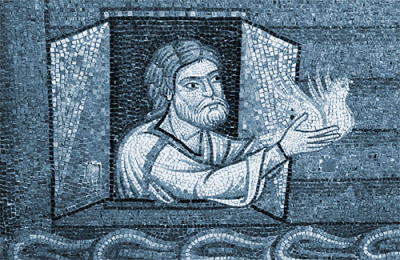
The Great Flood is one of those enduring mysteries handed down to us from ancient times. It continues to fascinate – especially those of us interested in the Bible, ancient history and global catastrophism. After all, if we are to believe the Biblical narrative, the Sumerian epic literature and numerous traditional sources from around the world, it was the event to end all events – the cataclysmic finale of the primeval age. Unfortunately, however, little convincing evidence to show that the Flood actually took place has surfaced in nearly two centuries of archaeological endeavour.
It is easy to dismiss the Flood legend simply as a myth, not worthy of investigation from an archaeological or historical standpoint. But then such a view is immediately confronted by literally hundreds of flood stories from disparate cultures scattered across the globe. Deluge traditions can be found in India, South-East Asia, Australia, Central America, Celtic Europe and Greece, as well as the numerous epic tales handed down to us by the ancient civilisations of the Middle East. Are they all the independent invention of fertile minds? Or did a real catastrophic event take place in the distant past which continues to echo through the millennia down to our own time? I believe the answer has to be yes, something did happen. But the nature of that something – its causes, scale and consequences – requires much further research. The tenacity of the Flood traditions demands that scholarship should address these issues and seek out the historical truth which lies behind them.
So, approaching this controversial subject with an open mind, how should one go about looking for evidence and confirmation of the Deluge traditions? As an Egyptologist and historian working in the Middle East, the obvious starting point for me would be my home turf. So, let me transport you to the wide-open plain of Mesopotamia – the 'land between the two rivers' – where the Judaeo-Christian, Islamic and ancient Sumerian flood stories were set.
First, we will need to tackle the archaeological evidence, then the time frame and finally the thorny question of Noah's Ark and its putative whereabouts.
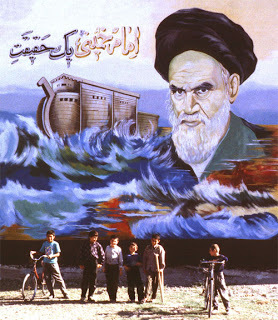 The new Noah (Iran).
The new Noah (Iran).Let's begin with what, if anything, archaeology has revealed in the alluvial basin of the two rivers, Tigris and Euphrates, where civilisation began and where the first cities on earth were built before the Flood according to Sumerian legend.
The problem here has always been the ephemeral nature of catastrophes caused by water. At best an archaeologist might expect to find a deep silt deposit overlying an ancient occupation level, above which a new human settlement had been constructed. And, in order to prove that the flood was more than just a local event, several silt deposits of the same date would need to be located, scattered throughout the Mesopotamian alluvial plain. Needless to say, no archaeological discovery has ever been made which fits these criteria, although there have been some tantalising indications of water-borne disaster.
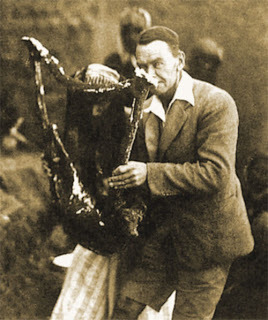 Sir Leonard Woolley at Ur.
Sir Leonard Woolley at Ur.Between 1928 and 1934 the famous British archaeologist Sir Leonard Woolley was excavating the city of Ur (where Abraham originated). In one of his deep soundings he came across a deposit of clean, water-borne silt measuring eleven feet in depth. Below it were houses and pottery dating to the Ubaid Period (c. 5,000-4,000 BC) whilst the silt layer was overlain by occupation levels dating to the Uruk Period (c. 4,000-3,000 BC). The Ur find hit the headlines – proof that the Deluge had been an historical event after all.
But subsequent discoveries in the region soon cast doubt on Woolley's claim. First, a refinement of the pottery dating techniques, combined with the ongoing decipherment of the cuneiform texts from Mesopotamia, began to suggest that the Ur flood was at least a thousand years too early for the Biblical Flood. Then, discoveries of silt layers at Fara (ancient Shuruppak) and Ingharra (ancient Kish) appeared not to match the stratigraphical date of Woolley's flood horizon (c. 4,000 BC). These new flood deposits were clustered around 2,800 BC and therefore much nearer to the date of circa 2,300 BC suggested by the chronology of Genesis. Scholarly opinion shifted and Woolley's Ur flood became nothing more than an archaeological curiosity.
As is often the case in academia, once a theory is abandoned for something more recent, it is rarely re-examined – even when subsequent findings suggest this might prove to be a fruitful exercise. Several new factors indicate that Woolley could have been right all along. Archaeologists now accept that the later flood deposits are unlikely to be the result of a single catastrophic event; they are spread out over at least a century and must represent a series of localised river floods. Moreover, archaeological excavations have shown that the city wall of Uruk, built after the Flood by the legendary Gilgamesh, dates to an archaeological period which comes before the silt deposits from these other archaeological sites. If Gilgamesh post-dated the Flood by at least a couple of centuries (as is the king-list tradition), then these later silt levels have nothing to do with the Great Flood remembered by both the Sumerians and the author of Genesis. Indeed, the only flood deposit which predates Gilgamesh, so far discovered, appears to be that found deep beneath the city of Ur by Leonard Woolley.
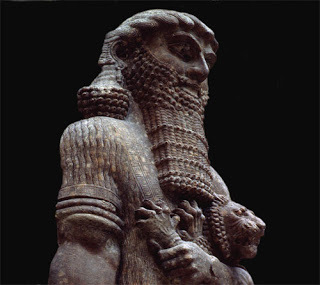 Gilgamesh (Louvre Museum).
Gilgamesh (Louvre Museum).But what about absolute dating? Isn't the Ur deposit simply too early to fit Noah's Flood? Perhaps not. First, the date assigned to the end of the Ubaid Period has been established principally through relative pottery dating – an inexact science at the best of times. Similarly, the duration of the Uruk Period which followed the Ubaid is based on an estimate that it must have lasted a considerable time due to the huge amount of building activity within its archaeological limits. But this is subjective. The Uruk Period was the age of the first great cities, when the kings of Sumer built platform temples and grandiose religious complexes, all made in mudbrick. It was the era when writing was invented and which, in later times, was to be regarded as the golden age of heroes. This was an epoch of terrific cultural dynamism which could indeed have lasted 1,000 years but equally just 300 years, depending on one's view of historical development. The succeeding historical era, known as the Early Dynastic Period, may also have been shorter than is conventionally believed because, again, there are no clear archaeological dating criteria. As a result, it is possible to argue for a terminus date for the Ubaid Period as low as 3,100 BC – a date which I have put forward (in my book, Legend: The Genesis of Civilisation) as being consistent with most of the textual sources and the limited archaeological dating evidence.
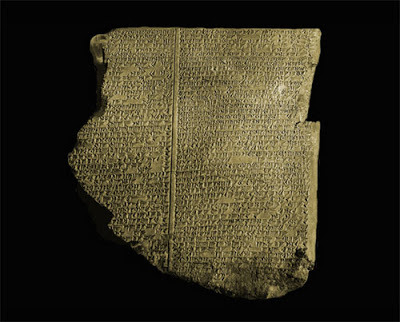 Tablet 11 of the Gilgamesh Epic concerning the Flood.
Tablet 11 of the Gilgamesh Epic concerning the Flood.In the same way that we can shorten the archaeological ages, bringing them down towards the present, scholars have argued that the Biblical date of the Flood can be set back to an earlier period than suggested by a cursory reading of the Genesis narrative. The Greek and Aramaic versions of the Old Testament (both of which are older than the earliest surviving Hebrew copy of the Bible) suggest that the Flood took place up to eight hundred years prior to the date calculable from the Massoretic (Hebrew) text (c. 2,300 BC) from which the Latin and English translations of the Old Testament derive. A date of around 3,100 BC is therefore quite possible if we take into consideration these earlier sources. It is also reassuring to note that the Mayan tradition places the Great Flood in Mesoamerica at precisely 3,113 BC according to their recently deciphered calendar.
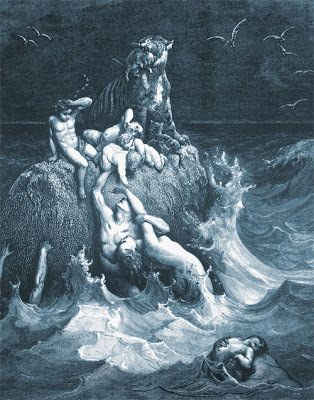 Doré's Flood.
Doré's Flood.Probable dates are all very well, but what would be the real clincher to prove, beyond doubt, that Noah's Flood was a genuine historical event? Of course, the discovery of Noah's Ark, what else? You may think that this is a bit of a joke, but people have been searching for Noah's Ark for decades and have been coming up with all kinds of extraordinary claims, some of which have made headline news or had TV documentaries lavished upon them. Virtually all these 'discoveries' have been focused on or around Mount Ararat in north-eastern Turkey. The problem here is that Mount Ararat was not the original traditional landing site of the Ark. It was only in the 13th century AD, when Vincent de Beauvais, Friar William of Rubruck, Odoric and Marco Polo came this way, that Mount Ararat superseded a much older and widely recognised location for the Place of Descent.
The first thing to note is that the Biblical text itself does not identify Mount Ararat as Noah's mountain. What Genesis 8:4 actually says is that 'the Ark came to rest on the mountains (plural) of Ararat' – in other words somewhere in the mountainous terrain of the land of Ararat. Biblical Ararat is recognised as being identical with the region that the 1st millennium BC Assyrians called Urartu – a land which covered much of the central section of the Zagros range. According to Genesis, therefore, the Ark must be searched for in modern Kurdistan, not hundreds of miles to the north on the volcanic peak we know today as Ararat in Armenia. Ararat is a late Christian name for the mountain; its local name is Agri Dagh. What is more, Jewish Talmudic writings of the 6th century AD consistently interpret the Biblical Ararat to mean Kurdistan and not Armenia [Targums of Genesis 8:4, Isaiah 37-38 and Jeremiah].
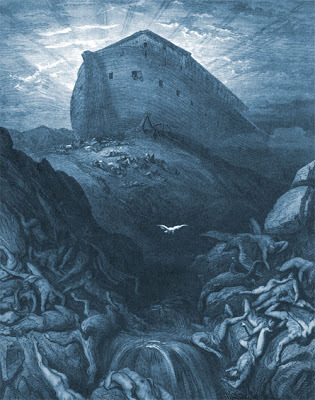 Dorés landing of the Ark.
Dorés landing of the Ark.So, where does everybody else, other than post-13th-century Christianity, locate the Place of Descent?
The Koran (8th century AD) calls Noah's landing site Gebel Judi ('Mountain of the Heights') and the 10th-century Muslim writer, Ibn Haukal, observes that 'Judi is a mountain near Nisibis. It is said that the ark of Noah (peace be upon him) rested on the summit of this mountain'. Nisibis is modern Nesibin or Nusaybin, one hundred miles north-west of Mosul on the southern edge of the Zagros foothills.
The early Nestorian Christians (followers of Nestorius, 4th-century patriarch of Constantinople) knew this to be the true landing place of the Ark. The pilgrim saint, Jacob of Nisibis (also 4th century) – note the link with the town claimed to be near Gebel Judi by Ibn Haukal – was the first Christian to look for the mountain of the Ark. His search concentrated in the 'district of Gartouk' which scholars recognise as a late spelling of classical Carduchi which, in turn, derives from Kardu – the ancient name of Kurdistan.
But we can narrow down our search even further. Hippolytus (AD 155-236) informs us that the landing site of the Ark was located in 'those mountains called Ararat which are situated in the country of the Adiabeni'. The Greek and Latin sources place Adiabene in the mountains to the north of Mosul where the Hadhabeni tribe still live today. One hundred miles due north of Mosul, just across the Iraqi border into Turkey and ninety miles to the east of Nesibin, the 7,000-feet peak of Judi Dagh ('Judi Mountain') rises from the Mesopotamian plain. This surely has to be the landing site of Noah's Ark referred to in all the early, Jewish, Christian and Islamic sources.
Judi Dagh is a place of real mystery and fascination for someone like me. Around this holy mountain there are devil-worshipping cults, giant rock-cut reliefs of Assyrian kings, and, near the summit itself, the ruins of a Nestorian monastery called the 'Cloister of the Ark'. Needless to say, I am keen to mount an expedition to investigate but, unfortunately, that isn't possible at the moment. Not only is Judi Dagh on the northern edge of the Kurdish autonomous zone of Iraq (currently a no-go area for British and American nationals) but it is also smack in the middle of the area being fought over by three different Kurdish military factions. Add to this the ongoing 'cleansing' operations by the Turkish army in eastern Anatolia and you have a recipe for potential disaster for any archaeological mission. For the moment, then, we will have to satisfy ourselves with what we know from the writings of earlier travellers to the region.
In the 1920s the Reverend William A. Wigram and his son Edgar spent some time exploring the region around Mosul. In their book, The Cradle of Mankind, they record ascending the ridge beneath the summit of Judi Dagh on the 14th of September to witness a gathering of Muslims (both Sunnis and Shias), Sabaeans, Jews and the Satan-worshipping Yezidis for a great annual religious festival. The English explorers watch each group of pilgrims deliver a sheep for sacrifice as 'the smoke of a hundred offerings goes up once more on the ancient altar' where the Kurds believe Noah made sacrifice to God for his deliverance from the Flood.
The Babylonian chronographer, Berossus (3rd century BC), tells us that in his day Kurdish mountain-folk 'scraping off pieces of bitumen from the ship (i.e. the Ark), bring them back and wear them as talismans'. The practice of local women wearing bitumen talismans was still observed as recently as the beginning of this century according to European travellers' reports. Bitumen is the oil-based 'pitch' with which the Ark was sealed against the seepage of the flood-waters [Genesis 6:14]. The mystery here is that the nearest source of bitumen lies hundreds of miles south of Judi Dagh in the swamps of the Iraqi lowlands. So by what mechanism did quantities of the black tar reach a mountain ridge on Judi Dagh? - unless, that is, it was a genuine survival from the wreck of Noah's floating refuge.
Finally, we have the ancient Jewish legends surrounding the powerful Assyrian ruler, Sennacherib (705-681 BC), who, during his military campaigns against the Kurds, 'found a plank, which he worshipped as an idol, because it was part of the Ark that had saved Noah from the Deluge'. If this tale has some historical truth to it, then knowing the approximate find spot of Sennacherib's sacred relic would be very useful. It is interesting, therefore, to note that giant figures of King Sennacherib were discovered in 1904, carved into the cliffs at the foot of one particular Kurdish mountain. Yes, you've guessed it – Judi Dagh. Aren't you just itching to get out there?
Appendix A
The Satan Worshippers
During his excavation season at Nineveh in 1846, Sir Austen Henry Layard made the short journey into the Zagros mountains to learn what he could about a strange cult known as the Yezidis. This Kurdish tribe lived in the northern Iraqi plain and the foothills around Judi Dagh. Layard had been invited by the high priest of the tribe to witness their most sacred rituals at the tomb of Sheikh Adi, a 12th-century holyman of the Yezidi sect. His tomb was hidden in a narrow valley on the eastern flank of Mount Judi.
The term Yezidi means a 'follower of angels' or 'one who belongs to angels'. They believe that they are directly descended from Noah. But what is extraordinary about these mountain folk is that their most important deity is an archangel they call Lasifarus whom scholars identify as Lucifer. Other names for the high-god of the Yezidis include Azazel (the fallen angel of Islamic tradition), Malek Taus ('peacock angel') and Shaitan (Satan). Within the inner sanctum of Sheikh Adi's tomb Layard came face to face with the Yezidis' dark lord in the form of a bronze statue depicting a bird of prey (probably a representation of the indigenous great bustard) whilst upon the door-jamb of the shrine he noted the carving of a large black serpent which Yezidi pilgrims touched and kissed.
In a previous blog I demonstrated that Eden and the earthly paradise lay just to the north of Judi Dagh in the area around the two great salt lakes of Van and Urumiya. Much of the early Genesis story seems to have been set in this mountainous region. I personally came across the Satan-worshippers through the writings of British ethnographer Andrew Collins. He has produced thought-provoking evidence to show that the Yezidis are a living testament to the tenacious tradition that this was indeed the land of the angelic host. Who or what the malekim (angels), cherubim (winged-creatures) and the nephilim (giants) were may eventually turn out to be more than just a theological issue, once the archaeological remains of this area are studied more closely. Already excavations in the 1950s at the mountain cave of Shanidar, again near Judi Dagh, have unearthed a Neolithic shrine not only containing human burials but also the articulated remains of seventeen pairs of feathered wings belonging to birds of prey such as the griffin vulture, the bearded vulture, the white-tailed eagle and the great bustard. These were believed by the American excavators, anthropologists Ralph and Rose Solecki, to have been worn by prehistoric shaman priests, transforming them into spirits of the air. Are these winged humans from primordial times the anthropological reality behind all the angelic legends and the images of fearsome winged demons found in early Mesopotamian art?
Appendix B
Recent Arkaeology
Two well publicised discoveries concerning Noah's Ark and the Flood have been announced in the last few years. First we had the strange boat-shaped formation found by American Ark-searcher, David Fasold. This large feature, located on the slopes of Lesser Ararat, was first photographed by US spy planes in 1949 but kept under wraps by the CIA. An attempt by Fasold to prove that these were the remains of Noah's Ark fell foul of the Turkish authorities when he tried to excavate without the necessary permits. Subsequent (less well publicised) excavations and a geological examination of the site have determined that, in reality, this remarkable boat shape is, in fact, a natural phenomenon.
Much more convincing from both an archaeological and historical point of view is the recent discovery, by marine geologists Bill Ryan and Walter Pitman of Columbia University, that the Black Sea was once a freshwater lake which was flooded by the salt waters of the Mediterranean in around 5,600 BC. This cataclysmic event certainly drowned vast areas bordering on the old lake and may well have forced those living around its shores to flee to higher ground. But could this really have been the basis for the Biblical and Mesopotamian flood tradition? I personally don't think so. First, the date is far too early: it comes before the development of the first cities (towards the end of the Ubaid Period in c. 4,500 BC at the very earliest) – cities which according to both Genesis and the Sumerian King List were in existence when the Flood struck. Second, in the 5,600 BC flood, the area inundated was the flat northern shore of the Black Sea around the outflow of the River Danube: this is nowhere near the Land of Shinar (ancient Sumer) where Noah's descendants settled after they descended from the mountains. Third, all the Near Eastern flood epics describe the Deluge as being caused by a terrible and long-lasting rainstorm: the flooding of the Black Sea, through the narrow straits of the Bosphorus, was a relatively lengthy process lasting several months and giving the inhabitants of the region plenty of time to escape the gradually encroaching waters. Finally, the waters of the Biblical Deluge receded whereas the waters of the Black Sea flood continue to cover the drowned land to this day.
Published on March 24, 2012 09:19
March 9, 2012
Siwa Oasis and the Oracle of Amun

The Siwa Oasis is of course most famous for its association with Alexander the Great, whose exploits have been handed down to us through the writings of his biographers Arrian and Calisthenes. In 331 BC, after defeating two Persian armies at the battles of Granicus and Issus and marching on southward into Palestine, Alexander was able to 'liberate' Egypt from Achaemenid rule. Then, for a reason not fully explained by the Hellenistic historians, the young king of Macedon suddenly had a ‘strong desire’ (Greek pothos) to undertake the hazardous journey into the Western Desert to seek an audience with the Oracle of Zeus Ammon at Siwa. This was no easy undertaking, as, on a number of occasions, the desert had already claimed the lives of other travellers who had attempted to reach this remote island of green hidden in a vast arid sea of sand covering over 680,000 square kilometres. Only two centuries earlier, a great army of 50,000 men was sent by Cambyses to "attack the Ammonians [the priests of Amun], reduce them to slavery, and burn the Oracle of Zeus" [Herodotus Book III.26]. The Persian army had tried to reach Siwa from the south, via the oasis of Kharga, but was never seen again; all 50,000, to the last man, perished on that expedition and the equipment of those unfortunate soldiers still awaits discovery, somewhere out beyond the southern oases, lying petrified beneath the drifting sand.
Location
The Oasis of Siwa is located in the northern sector of the Western Sahara, immediately to the West of the Qattara Depresion and some 600 kilometres from the Nile Valley. The principal modern (and indeed ancient) communication route with this remote outpost is from Alexandria via Matruh (ancient Paraetorium) on the Mediterranean coast, then south across the desert. At this point the modern tarmac road gives way to an unmade track for 100 kilometres which finally reaches Siwa from the north. There are also three camel tracks leading out from Siwa: west to Girbah Oasis, north-east to Qarah Oasis and south-east to Bahriyya and from there to the other southern oases.
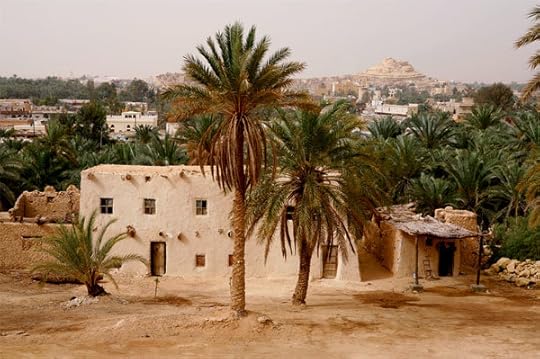 Siwa Oasis
Siwa OasisThe Oasis of Siwa itself is a very extensive shallow basin, being approximately 82 kilometres from east to west and 28 kilometres from north to south. Within this depression are seven large salt lakes, the greatest of which are Birket Siwa and Birket Zaytun. As well as these large areas of standing saline water, which are obviously useless for irrigation, there are a number of man-made artesian wells which provide more than sufficient fresh water to irrigate vast plantations of date-palms and fruit-trees.
Rising out of the greenery are a number of rocky outcrops on which, since time immemorial, the local population groups have built their fortified settlements, affording them protection against the more dangerous desert fauna and, in particular, nomad/Beduin raiders.
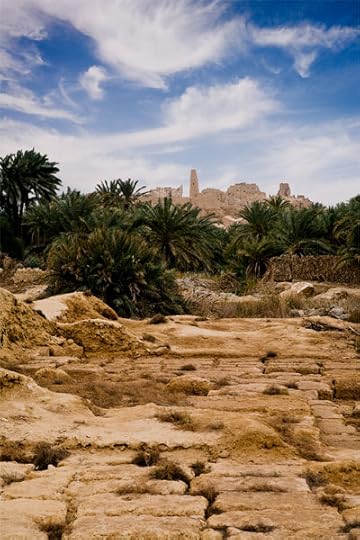 Siwa Oasis with Siwa Hill in the background
Siwa Oasis with Siwa Hill in the backgroundThe modern inhabitants of Siwa are mainly of Medieval Berber descent, having arrived in the region in the early 13th century in a group one hundred or so strong. It is only in relatively recent times that they have relinquished their unusual Berber dialect for modern Arabic. The forty men and their families settled around a rocky cone, building a fortified stronghold which they called 'Shali' (Berber for 'town'). This was later to become 'Siwa', after the name of the particular Berber tribe who had founded the settlement, and now forms the heart of the modern village of that name. The pharaonic name for the oasis is not certain but what limited evidence there is suggests that it may have been called 'Thay' or 'Tha'.
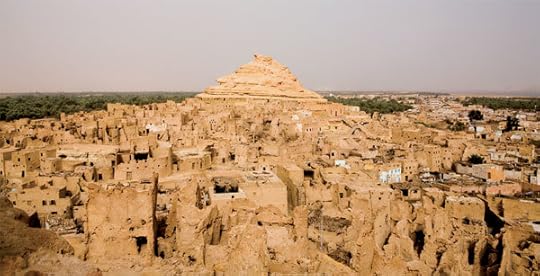 The medieval village on Siwa Hill
The medieval village on Siwa Hill
The more ancient inhabitants of the oasis were settled on and around the rocky crag of Aghurmi, some four kilometres east of Siwa town, and they continued to reside within the walls of this mudbrick fortress until 1926 when a heavy thunderstorm (lasting three days) destroyed a large number of houses, killing their inhabitants. The population then departed from the site, which had been occupied since pharaonic times, and built a new settlement nearby. It was that exodus from the crag which enabled the archaeologists to begin the work of clearing the medieval occupation in order to gain access to the more ancient remains which had been identified by James Hamilton in 1853 but which were otherwise only known through the stories of Alexander's visit to the Oracle.
The Ancient Pharaonic Sites
There are a number of ancient sites within the Siwa depression and around its periphery, including Aghurmi, Umm Ubayda, Ayn el-Gubba, and Gebel el-Mawta. Of these the settlement atop the Aghurmi crag is certainly the most interesting because it was here that the Temple of the Oracle of Amun was rediscovered in the last century and where most of the subsequent excavation and survey work has been concentrated in recent years. Before turning to this site, which will form the basis of this discussion, we should perhaps first take a brief look at the other locations containing pharaonic remains.
Umm Ubayda
The site of Umm Ubayda includes what was once an impressive temple built by the 'the Great Chief of the Desert', Wenamun, for the pharaoh Nectanebo II (360-343 BC) of the 30th Dynasty and dedicated to Amun. The temple lies within the palm groves just half a kilometre to the south of Aghurmi.
Unfortunately, and not untypically, this fine monument was blown up by a local official, one Mahmud Azmi, in 1897 so that the blocks could be used to construct a new staircase for the local police station and, needless to say, one also for his own house. What remains today is the stump of a wall from the sanctuary which never the less is richly decorated with scenes of Wenamun, Libyan feather in hair, kneeling before Amun and with a procession of deities behind him. The two temples of Aghurmi and Umm Ubayda are connected by a ceremonial way and probably functioned under a single administration, given the isolation of their setting.
Alexander's biographers mention a second temple of Amun, other than the Temple of the Oracle, and describe its setting amidst the palm groves of the oasis; this is no doubt the temple at Umm Ubayda.
Ayn el-Gubba
Ayn el-Gubba is the famous 'Spring' or 'Fountain of the Sun' to which Herodotus accords miraculous powers: he tells us that whilst during the hot hours of daylight its waters remain cool and refreshing, at night, however, the spring "boils furiously" [Herodotus Book IV.182]. In fact, the bubbling effect is caused by natural gasses rising from rocks beneath the surface – the temperature, of course, remains much the same throughout the 24-hour day.
Gebel el-Mawta
The limestone cliffs of Gebel el-Mawta, a promontory rising out of the palm groves in the northern sector of the fertile basin some five kilometres north of Aghurmi, formed the principal burial ground of the ancient Siwan settlement. Indeed, Gebel el-Mawta means 'The Hill of the Dead' in Arabic and is also called Qaret el-Missabbarin – 'The Ridge of the Mummified'. There are a great number of tombs in the area, many of which are now completely buried in sand. A number of others will have remained undiscovered, since a systematic excavation of the site remains to be undertaken. The important published tombs are those of Niperpathoth, Mesuisis, Siamun and the so-called 'tomb of the crocodile'.
The most interesting is that of Siamun which has fine colourful scenes of the deceased and his family painted on plastered walls. There is little doubt that, in spite of his Egyptian name, Siamun was not of Egyptian stock as he is shown with pale complexion, beard and thick black curly hair. His wife is darker skinned and bears the good Egyptian name Neferheret – 'beautiful of face'; she most probably, therefore, was a native Egyptian. Siamun's father, with the name Periytu, is, however, undoubtedly of foreign extraction. As if to add further confusion, the son of the tomb owner is depicted in Greek dress whilst Siamun himself wears the clothes of an Egyptian nobleman. Thus the tomb of Siamun is strong evidence for the international character of Siwa during the Hellenistic Period and appears to demonstrate that intermarriage was practiced between the Greek world and Egypt.
Aghurmi
We now turn to the most important of the Siwan sites, that of the Temple of the Oracle itself. The pharaonic remains are located on the relatively flat-topped rock of Aghurmi which forms a natural acropolis rising to some thirty metres above the palm groves. It appears that, not long after the temple and ancillary buildings fell into disuse, the rock was occupied by the local inhabitants who moved from the vulnerable low-lying areas into the fortified citadel of the Siwan chieftains – the local governors of the pharaohs. As a result, when the temple was discovered in modern times it was sheathed in mudbrick houses with very little of the ancient structure visible.
The major task of clearing the temple of its Medieval overcoat was undertaken by Ahmed Fakhry in 1970 but before that three brief surveys had been completed, first in 1932, by Ricke, Steindorff and Aubin, and then in 1938 and 1941 by Fakhry himself. More recently, during three seasons of activity at Siwa, a much fuller investigation of the temple and its surroundings was conducted by the German Archaeological Institute in Cairo under the direction of Klaus Kuhlmann. This work has revealed some very interesting details about the workings of the Oracle and its temple which had not been hitherto noted and these findings will be dealt with at the end of this section on the temple at Aghurmi.
During the two days that Ricke and his colleagues spent at Aghurmi they attempted to establish the building date of the Temple of the Oracle and indeed Steindorff, whose assignment was the investigation of the 'Holy of Holies' or 'cella', did locate a much damaged cartouche which he read as that of Achoris (393-381 BC), third king of the 29th Dynasty. Thus the earliest known building activity at the site – the sanctuary itself – could be taken back only as far as the post-Persian era. This was obviously very disappointing, as it cast doubt on the veracity of Herodotus' story about Cambyses' attempted assault on the Oracle. Then, in 1938 Fakhry cleaned down the inner walls of the cella and was able to show that the builder of the temple was in fact Amasis (570-526 BC) the last ruler of the 26th Dynasty, just prior to Cambyses' invasion. Thus Herodotus was vindicated by modern archaeology for now there was proof of the existence of the Oracle in late-Saite times.
The Temple of the Oracle
Let us now take a more detailed look at the Temple of the Oracle to learn something of the way it was built and how it may have functioned, at the same time recalling the Alexander-narrative so as to determine the accuracy of the Hellenistic descriptions.
At first glance it appears that the temple is of the basic Late Period/Pre-Ptolemaic Egyptian design, consisting of a courtyard and gateway with an interrupted lintel leading to an open portico/hall, a second inner hall and finally the central sanctuary with chambers on either side. However, when one looks further, there are a number of very untypical aspects in terms of both the temple's location and its design.
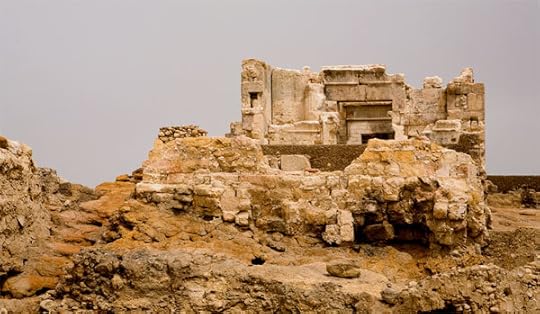 The Temple of the Oracle of Amun on Aghurmi Hill
The Temple of the Oracle of Amun on Aghurmi HillFirstly, and perhaps most obviously, the temple is located on top of a rocky crag. Throughout the whole corpus of temple or shrine building activity in ancient Egypt this is almost, but not quite, an exceptional occurrence. Only four other examples come to mind, the last two of which are even then somewhat doubtful. The obvious and most clear cut example is the shrine of Thoth built by Saankhkare Mentuhotep (2010-1998) of the 11th Dynasty which is located atop the highest peak in the hills of Western Thebes. Secondly, there is the Ptolemaic temple of Petesuchos at Karanis in the Faiyum – not only later than the Siwan temples but perhaps also the closest in character to the Temple of the Oracle. Then we may tentatively add the 'high place' at el-Hiba, which, although probably a sacred altar of some kind, now has insufficient remains to indicate if there was ever a mudbrick building at the site. Finally there is the Predynastic temple/shrine of Horus at Hierakonpolis which appears to have been erected on top of a large platform. All the other temples of dynastic Egypt (apart from the rock-cut speoses), as far as I am aware, were built on low-lying ground. In this respect therefore the Aghurmi temple is most unusual.
Furthermore the temple was reached by a grand stairway leading up from the base of the rock where the sacred well was located (mentioned by the Greek historians). This is only paralleled at Karanis but, even then, on a much smaller scale.
At the head of the stairway there was a narrow terrace in front of the entrance to the court. This court may have been that described in Alexander's story where the barque of the Oracle was paraded around the king and his escort before Alexander went alone into the shrine for his private audience. Above the low wall, on either side of the main entrance gateway, a second facade had been erected in Greek times, perhaps at the behest of Alexander himself. Attached to this second wall, and standing on the cavetto-cornice of the earlier 26th-Dynasty facade, were two fluted half-columns. The facade was otherwise completely plain and without inscription.
Now we come to perhaps the most intriguing features of the temple, the ones which give it its special character as the seat of one of the most famous oracles of the ancient world.
The cella, or shrine of the Oracle, possessed a number of special features which enabled the priests to put on dramatic performances for those wishing to seek the wisdom of the Oracle. Firstly, the cella had a second storey, which had no visible entrance, from where a priest could secrete himself and deliver the words of the ram-headed statue of Amun. Thus the source of the voice of the Oracle remained heard but unseen by those who had been granted a private audience – as in Alexander's case. The Oracle's theatrical performance could be further enhanced by other priests shaking sistra, making noises, or playing the roles of the other gods. This was done by means of another secret corridor located behind and to the right of the statue. Thus the voices of the priests could be made to resonate through the walls of the shrine echoing in the darkness all around the statue of Amun, bedecked in jewels – the ancient equivalent of a Son-et-Lumiere performance at Karnak perhaps? This corridor was only accessible via an ingenious tunnel, the entrance to which was only recently found at the base of a cliff immediately to the rear of the temple on the northern edge of the acropolis. By this elaborate system of hidden rooms and corridors the priests were able to impress even the least impressionable of visitors, and it is not really surprising that the Oracle of Zeus-Ammon was so renowned during the Greco-Roman era when exotic cults and mystic religions became so popular.
What we do learn from this, however, again leads us to think how un-Egyptian the temple and its Oracle were by the time Alexander made his visit. It is reasonably clear, from the archaeological remains of the pre-Ptolemaic temples of Egypt, that the Egyptian clergy did not go in for elaborate deceptions – in particular ones which involved the performance of the god's spoken word. We know this because no hidden chambers have been found earlier than that at Siwa. It is only in the Greco-Roman temples such as Dendera, Edfu and Karanis that such devices are introduced to deliver the oracular messages. We further observe that the normal method of oracular delivery in true Egyptian style was the silent nodding of the sacred barque of the oracle as it was brought before the questioner. This ceremony was usually performed not inside the holy shrine but outside in the public gaze. Indeed, as we have noted, this is precisely what happened when Alexander and his men were first introduced to the Oracle in the forecourt of the temple, before the king was given his private audience in the inner sanctum where he learnt of his divine parentage.
It thus appears that the oracular voice was a Greek invention and that the building of the Aghurmi temple, late in the 26th Dynasty, may have been a partially Greek affair, undertaken by an expeditionary force of Greek mercenaries sent by Amasis to garrison the Oasis. The involvement of the local native ruler of the Siwa Oasis, a Libyan named Sutekhirdes 'Chief of the Desert Dwellers', is quite evident as it is his figure which occupies one of the inner walls of the shrine, offering to the gods, whilst the king is portrayed on the opposite wall in a similar fashion.
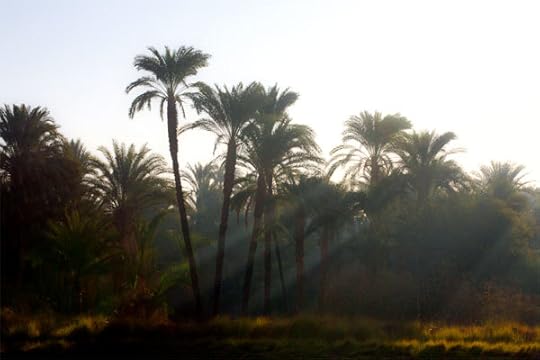
Summary
Although Alexander's experiences at Siwa are the only written records that we can draw upon to learn something of the history and nature of the place, modern excavations and surveys have revealed further information which not only confirms the accounts of Callisthenes and Arrian but also appears to show that Siwa only came under Egyptian control in the Late Period.
The earliest pharaoh recorded at the Oasis is Amasis and none of the other buildings, including the outlying temples of Bilad el-Rum, Qasr el-Ghashsham, Abu Sharuf and el-Zaytun (not discussed in this essay), are earlier than 360 BC. Indeed all are of Greek or Roman date.
The local chiefs or governors whose images appear on the Aghurmi and Umm Ubayda temples, along with Amasis and Nectanebo, do appear to be of Libyan stock and one must presume that contact was made between Egypt and Siwa certainly by the 22nd Dynasty. Siwa may have in fact been one of the primary staging points in the Libyan migrations of the early Third Intermediate Period.
With Old Kingdom mastabas having been found at Dakhla, we know that the Southern Oases were under Egyptian influence for most of the period of dynastic rule, but no such evidence exists for Siwa. Acknowledging that the following assumption is based on negative evidence, nevertheless I have to conclude that the Oasis of Siwa was essentially a foreign land and not a part of Egypt until the area was brought under pharaonic control in the late-26th Dynasty of the Saites. Subsequent archaeological investigation may invalidate this statement, however, for the moment, this conclusion, having been founded on what the site has revealed to date, appears to be justified.
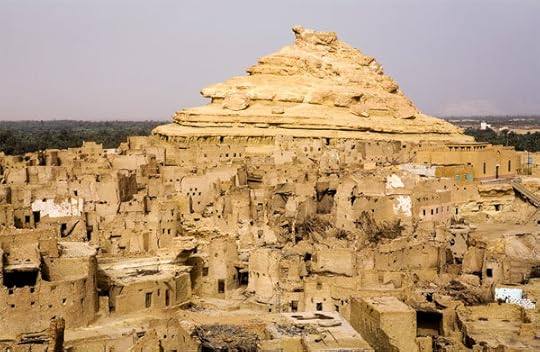
Bibliography
C. D. Belgrave: Siwa: The Oasis of Jupiter Ammon (London, 1923).
A. Fakhry: Siwa Oasis: Its History and Antiquities (Cairo, 1944).
--- 'Recent Excavations at the Temple of the Oracle at Siwa Oasis' in Agyptischen Bauforschung und Altertumskunde, Vol. 12 (Wiesbaden, 1971), pp. 17-33.
--- The Oases of Egypt, Vol. 1 (Siwa Oasis), (Cairo,1973).
K. P. Kuhlmann: Das Ammoneion: Archaologie, Geschichte und Kultrpraxis des Orakels von Siwa (Mainz an Rhein, 1988).
W. J. Murnane: The Penguin Guide to Ancient Egypt (London, 1983).
G. Steindorff: Durch die Libysche Wuste zur Amonsoase (Leipzig, 1904).
Published on March 09, 2012 11:44
February 29, 2012
Picture Gallery for February 2012
Here are some beautiful photographs of the Egypt you don't often see, taken by my good friend and exceptional photographer, Mike Shepherd. Enjoy!
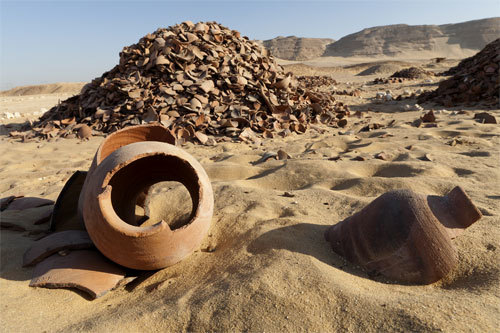 The Mother of Pots (Umm el-Gaab, Abydos).
The Mother of Pots (Umm el-Gaab, Abydos).
 Felucca on the Nile.
Felucca on the Nile.
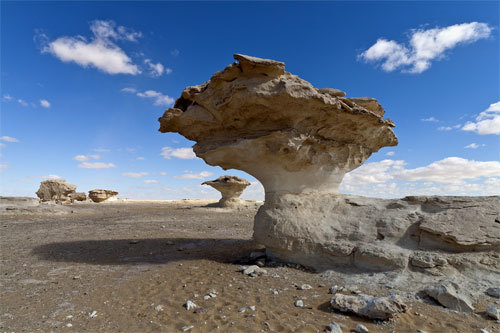 The White Desert.
The White Desert.
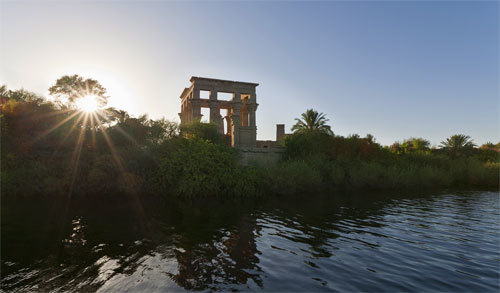 Philae Island.
Philae Island.
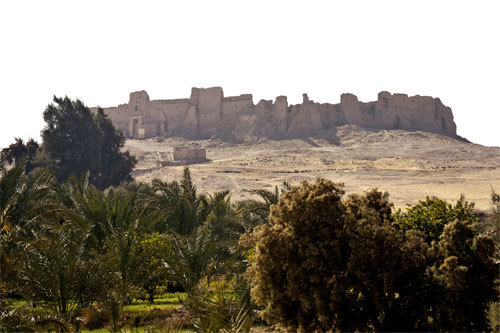 Gweeta.
Gweeta.
 Fishermen on the Nile.
Fishermen on the Nile.
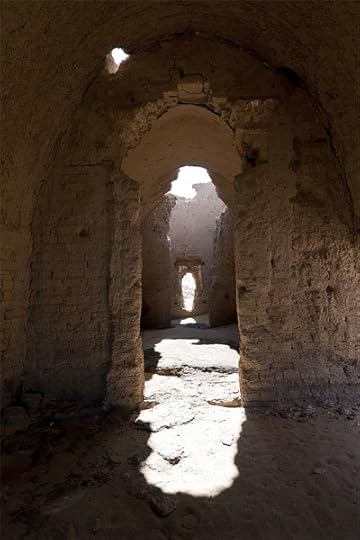 Dush.
Dush.
If you want to see more of Mike's wonderful pictures, you can visit his web site at:
http://www.mikeshepherdimages.com
 The Mother of Pots (Umm el-Gaab, Abydos).
The Mother of Pots (Umm el-Gaab, Abydos). Felucca on the Nile.
Felucca on the Nile. The White Desert.
The White Desert. Philae Island.
Philae Island. Gweeta.
Gweeta. Fishermen on the Nile.
Fishermen on the Nile. Dush.
Dush.If you want to see more of Mike's wonderful pictures, you can visit his web site at:
http://www.mikeshepherdimages.com
Published on February 29, 2012 09:52
David Rohl's Blog
- David Rohl's profile
- 62 followers
David Rohl isn't a Goodreads Author
(yet),
but they
do have a blog,
so here are some recent posts imported from
their feed.



